#Set It Off: Music From the New Line Cinema Motion Picture
Explore tagged Tumblr posts
Text

#Rap & Hip-Hop#Rap#Hip-Hop#Hip Hop#hiphop#soundtrack#1990s#90s#music#bone thugs n harmony#days of our livez#Set It Off: Music From the New Line Cinema Motion Picture#set if off#layzie bone#krayzie bone#bizzy bone#wish bone#flesh n bone#gif
15 notes
·
View notes
Text
THIS DAY IN GAY HISTORY
based on: The White Crane Institute's 'Gay Wisdom', Gay Birthdays, Gay For Today, Famous GLBT, glbt-Gay Encylopedia, Today in Gay History, Wikipedia, and more … November 21


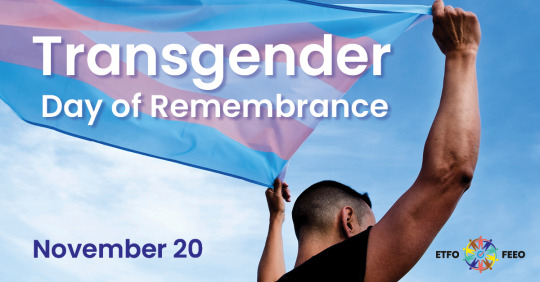
Transgender Day Of Remembrance (since 1999) set aside to memorialize those who were killed due to anti-transgender hatred or prejudice (transphobia). The event is held on November 20, founded by Gwendolyn Ann Smith, to honor Rita Hester, whose murder in 1998 kicked off the "Remembering Our Dead" web project and a San Francisco, California candlelight vigil in 1999. Since then, the event has grown to encompass memorials in hundreds of cities around the world.

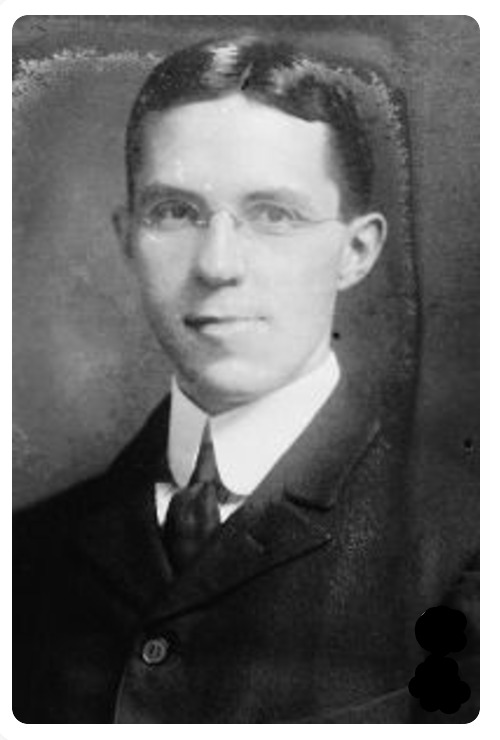
1873 – Daniel Gregory Mason, American composer, born (d.1953); Mason came from a long line of notable American musicians, including his father Henry Mason. He studied under John Knowles Paine at Harvard University from 1891 to 1895, continuing his studies with George Chadwick and Goetschius. In 1894 he published his Opus 1, a set of keyboard waltzes, but soon after began writing on music for his primary career. He became a lecturer at Columbia University in 1905, where he would remain until his retirement in 1942, successively being awarded the positions of assistant professor (1910), MacDowell professor (1929) and head of the music department (1929-1940). He was the lover of composer-pianist John Powell.

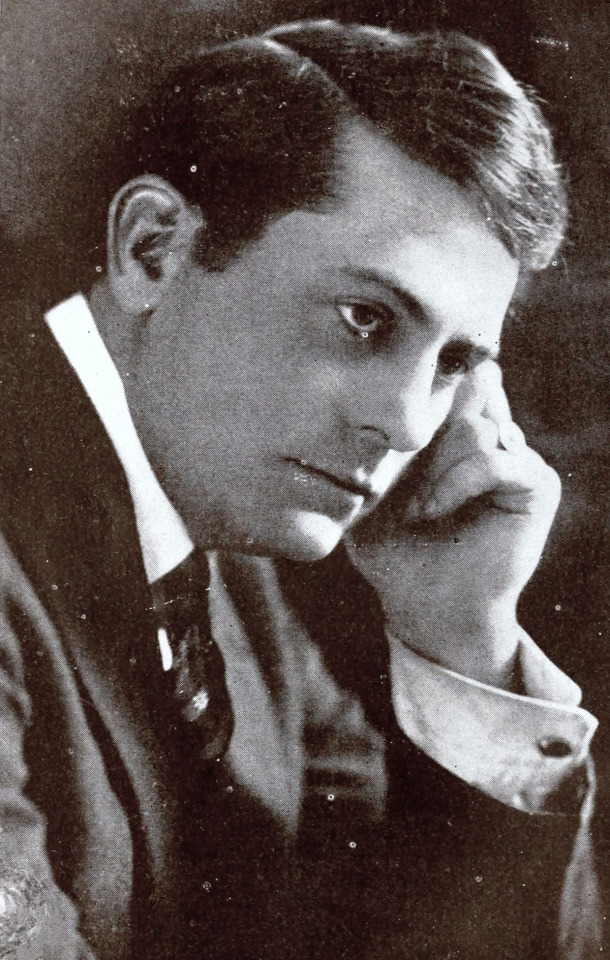
1883 – Edwin August (d.1964) was an American actor, director and screenwriter of the silent era. He appeared in 152 films between 1909 and 1947. He also directed 52 films between 1912 and 1919. He co-founded Eaco Films in 1914.
Edwin was born Edwin August Phillip von der Butz in St. Louis, Missouri, to August and Sarah Butz. He was educated at the Christian Brothers College.
He began working with Biograph Studios in New York as early as 1908 and moved to Hollywood with that company in 1910. He starred in several films by D. W. Griffith, who was also with the company, and continued to work well into the 1930s as a writer and director.
In 1916, he entered his name as a candidate for President of the United States, and spoke out against censorship in cinema. The candidate wasn't taken very seriously, and perhaps that wasn't the point. He didn't like the road that his industry was going down, and wanted to voice his opinion in the hope of change.
A co-star, Blanche Sweet, would later bluntly state: "He was a homo." He owned a chicken ranch at 648 South Figueroa in Hollywood and was friends with gay silent film star J. Warren Kerrigan and most likely Kerrigan's long time partner James Vincent.
Edwin passed away from cerebral metastatic disease on March 4, 1964 at the Motion Picture County Hospital in Woodland Hills, Los Angeles County, California.

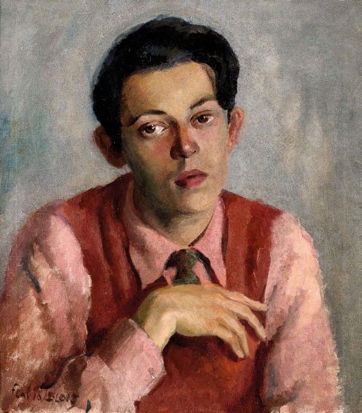
1916 – James Pope-Hennessy (d.1974) was a British biographer and travel writer.
James Pope-Hennessy was born in London on 20 November 1916, the younger son of Ladislaus Pope-Hennessy, a soldier from County Cork, Ireland, and his wife, Una, the daughter of Arthur Birch, Lieutenant-Governor of Ceylon. He was the younger of two sons; his elder brother, John Pope-Hennessy, was an English art historian, museum director and writer of note. James came from a close-knit Catholic family and was educated at Downside School and at Balliol College, Oxford, but generally showed a lack of interest in formal education and did not enjoy his time at either Downside or Oxford.
Largely owing to his mother's influence, he decided to become a writer and left Oxford in 1937 without taking a degree. He went to work for the Catholic publishers Sheed and Ward as an editorial assistant. While working at the company's offices, in Paternoster Row in London, he worked on his first book, London Fabric (1939), for which he was awarded the Hawthornden Prize. During this period, he was involved in a circle of notable literary figures including Harold Nicolson, Raymond Mortimer and James Lees-Milne.
He left the publishers in 1938 when his mother found him a job as private secretary to Hubert Young, the Governor of Trinidad. Although his time abroad provided the material for his later West Indian Summer (1943), he disliked both the West Indies and the atmosphere of Government House. The outbreak of the Second World War gave him an excuse to return to Britain, where he enlisted as a private in an anti-aircraft battery under the command of Sir Victor Cazalet. Rising through the ranks, he was transferred to military intelligence, given a commission and spent the latter part of the war as a member of the British army staff at Washington.
Pope-Hennessy enjoyed his time in the United States and made many friends there. After the end of the war he wrote an account of his experiences in America. On his return to London in 1945 he shared a flat with the British intelligence officer Guy Burgess, who later defected to the Soviet Union. He had a brief spell as the literary editor of The Spectator between 1947 and 1949, before he decided to travel to France and write Aspects of Provence, which was published in 1952.
He would eventually establish himself as one of the leading biographers of his time; his first effort in this direction being a two-volume biography of Monckton Milnes that appeared in 1949 under the titles The Years of Promise and The Flight of Youth. This was followed by further biographies of the Earl of Crewe and of Queen Mary, for which he was created Commander of the Royal Victorian Order in 1960. He also wrote a life of his grandfather, the colonial governor John Pope Hennessy, under the title Verandah (adapted as a documentary for BBC Television under the title "Strange Excellency", 1964), followed by an account of the Atlantic slave traffickers, Sins of the Fathers (1967).
In 1970, he took out Irish citizenship and went to live at Banagher in County Offaly, and during the next few years produced authoritative biographies of both Anthony Trollope and Robert Louis Stevenson. Trollope himself had chosen James' grandfather, John Pope Hennessy, as the basis for the character Phineas Finn in his novel of the same name. Robert Louis Stevenson was published posthumously and without revision in 1974. He became a popular figure in Banagher, evidenced by the fact that he was asked to adjudicate at a local beauty pageant and the horse fair, the oldest in Ireland. On being given a large advance he returned to London in 1974 to begin work on his next subject, Noël Coward.
Despite being a successful professional writer, Pope-Hennessy was careless with money. He suffered a series of financial crises and often relied on the goodwill of friends to get him by. A homosexual, he was a heavy drinker and frequented back-street bars and shady pubs where he mixed with a rough crowd, associations that eventually contributed to his death when he was brutally murdered on 25 January 1974 in his London flat by three young men. He had been sexually acquainted with one of them.

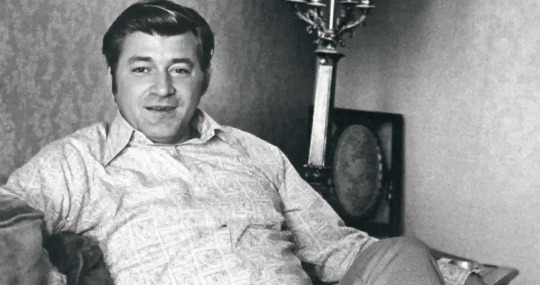
1941 – Oliver Sipple, the man who saved President Gerald Ford's life, was born today.
Sara Jane Moore attempted to assassinate U.S. President Gerald Ford outside the St. Francis Hotel in San Francisco, just seventeen days after Lynette "Squeaky" Fromme had also tried to kill the president. Moore was forty feet away from Ford when she fired a single shot at him. The bullet missed the President because bystander Oliver Sipple grabbed Moore's arm and then pulled her to the ground, using his hand to keep the gun from firing a second time. Sipple said at the time: "I saw [her gun] pointed out there and I grabbed for it. I lunged and grabbed the woman's arm and the gun went off." The single shot which Moore did manage to fire from her .38-caliber revolver ricocheted off the entrance to the hotel and slightly injured a bystander.
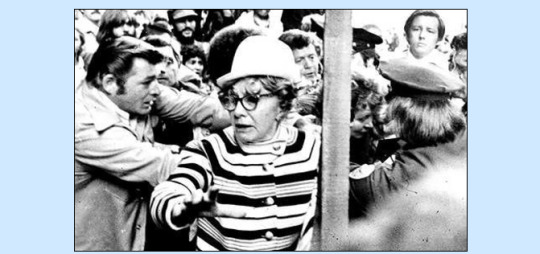
Sipple goes for the gun.
Sipple, a decorated Marine and Vietnam War veteran, was immediately commended by the police and the Secret Service for his action at the scene. The news media portrayed Sipple as a hero but would eventually report on his outing by Harvey Milk and other San-Francisco gay activists. Though he was known to be Gay by various fellow members of the gay community, Sipple had not made this public, and his sexual orientation was a secret from his family. He asked the press to keep his sexuality off the record, making it clear that neither his mother nor his employer had knowledge of his orientation; however, his request was not complied with.
The national spotlight was on him immediately, and Milk responded. While discussing whether the truth about Sipple's sexuality should be disclosed, Milk told a friend: "It's too good an opportunity. For once we can show that Gays do heroic things, not just all that ca-ca about molesting children and hanging out in bathrooms." Milk contacted the newspaper.
Several days later Herb Caen, a columnist at The San Francisco Chronicle, exposed Sipple as a Gay man and a friend of Milk. Sipple was besieged by reporters, as was his family. His mother, a staunch Baptist in Detroit, refused to speak to him. Although he had been involved with the Gay community for years, even participating in Gay Pride events, Sipple sued the Chronicle for invasion of privacy. President Ford sent Sipple a note of thanks for saving his life. Milk said that Sipple's sexual orientation was the reason he received only a note, rather than an invitation to the White House.
Sipple filed a $15 million invasion of privacy suit against Caen, seven named newspapers, and a number of unnamed publishers, for publishing the disclosures. The Superior Court in San Francisco dismissed the suit, and Sipple continued his legal battle until May 1984, when a state court of appeals held that Sipple had indeed become news, and that his sexual orientation was part of the story.
According to a 2006 article in The Washington Post, Sipple went through a period of estrangement with his parents, but the family later reconciled with his sexual orientation. Sipple's brother, George, told the newspaper, "(Our parents) accepted it. That was all. They didn't like it, but they still accepted. He was welcomed. Only thing was: Don't bring a lot of your friends."
Sipple's mental and physical health sharply declined over the years. He drank heavily, gained weight to 300 lb (140 kg), was fitted with a pacemaker, became paranoid and suicidal. On February 2, 1989, he was found dead in his bed, at the age of forty-seven. Earlier that day, Sipple had visited a friend and said he had been turned away by the Veterans Administration hospital where he went concerning his difficulty in breathing. His $334 per month apartment near San Francisco's Tenderloin District was found with many newspaper clippings of his actions on the fateful September afternoon in 1975. His most prized possession was the framed letter from the White House.
Sipple held no ill will toward Milk, and remained in contact with him. The incident brought him so much attention that, later in life, while drinking, he would regret grabbing Moore's gun. Sipple, who was wounded in the head in Vietnam, was also diagnosed paranoid schizophrenic according to the coroner's report.
Sipple's funeral was attended by 30 people, and he was buried in Golden Gate National Cemetery in San Bruno, California. A letter addressed to the friends of Oliver Sipple was on display for a short period after his death at one of his favorite hangouts, the New Belle Saloon:
"Mrs. Ford and I express our deepest sympathy in this time of sorrow involving your friend's passing..." President Gerald Ford, February, 1989
In a 2001 interview with columnist Deb Price, Ford disputed the claim that Sipple was treated differently because of his sexual orientation, saying: "As far as I was concerned, I had done the right thing and the matter was ended. I didn't learn until sometime later — I can't remember when — he was Gay. I don't know where anyone got the crazy idea I was prejudiced and wanted to exclude Gays."


1990 – A London judge convicted 14 gay men of committing criminal assaults upon themselves because of their participation in S&M. All 14 receive prison sentences.


1998 – John Geddes Lawrence and Tyrone Garner of Texas were ordered to pay fines of $125 each after being arrested for having sex in their home. The couple refused to pay and announced they would challenge the Texas sodomy law - initiating what became known as the historic "Lawrence vs Texas" Supreme Court decision which decriminalized homosexual sex.


4 notes
·
View notes
Text
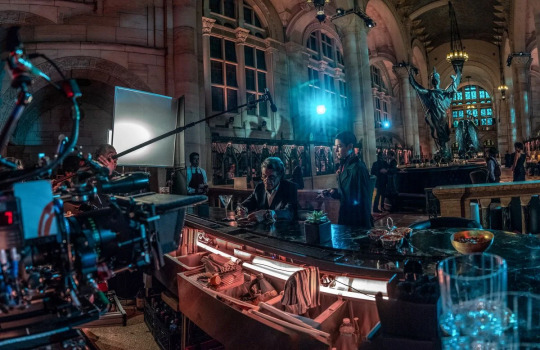
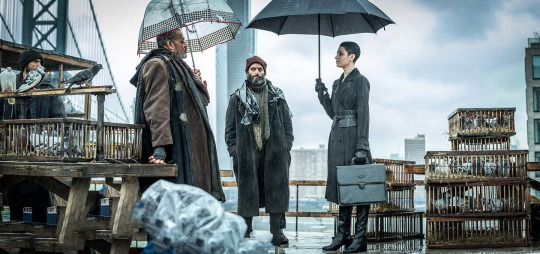

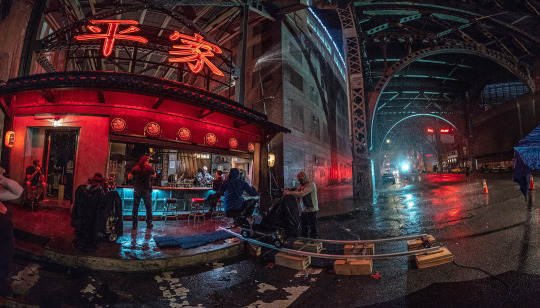

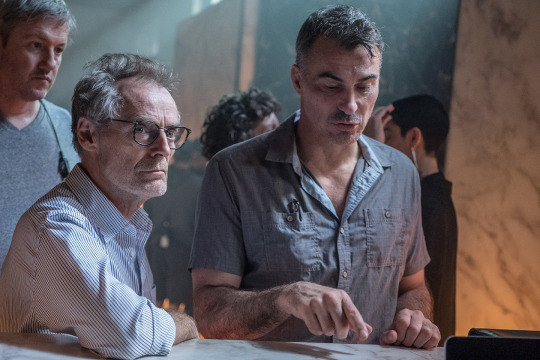
behind the scenes shots ft. akd as the adjudicator, from this article about the cinematography
“In Hollywood, action filmmaking was kind of looked down upon until The Matrix, and then people realized that action could also be part of the story,” [director] Stahelski notes. “I come from a place of loving dance and theater and fine art — action can be all of those things — and one of my favorite painters is Caravaggio.” When he was looking for a cinematographer for John Wick: Chapter 2, Stahelski recalls, “I asked myself, ‘Who paints with light?’ The answer is Dan Laustsen.” In strictly cinematographic terms, Parabellum functions less like an action movie and more like a Hollywood studio musical. The film’s first battle is a close-quarters knife fight in an antique weapons shop, where the camera cuts from wide shot to wide shot, sustaining the action in long takes so that the audience can better appreciate the physical prowess of Reeves’ performance — an elaborate fighting style that combines Japanese judo and jujitsu, Brazilian jujitsu, Russian sambo, Filipino kali, and Muay Thai, more for the benefit of show than for self-defense. “Ninety-nine percent of high-level stunt work is dance — not pirouettes, but how you move your body,” asserts Stahelski, who continues to train stuntpeople with Leitch through their company 87eleven. “I love the aesthetic of motion. A lot of our shots [in Parabellum] are lifted straight from Singin’ in the Rain and West Side Story. We’re mixing Buster Keaton and Charlie Chaplin with Hong Kong cinema from John Woo, Jackie Chan and the Shaw Brothers.” “We wanted to go wider than Hollywood action films normally do and really show off the choreography,” Laustsen agrees. “When the camera, lighting and actors are all moving together, it really is a dance.”
“After we made Chapter 2,” Laustsen notes, “we discussed how we could make 3 even more visually powerful. The main setting was still New York, but we wanted to bring out the city even more forcefully. We decided to shoot all at night, with rain as much as possible. Rain is fantastic because it gives a third dimension to the picture, but it is a challenge to do it, especially in a city like New York.”
The Master Anamorphics’ low-distortion design also prevents dramatic, streaking lens flares, and so the technicians at Arri Rental in Secaucus, N.J., fashioned a flare filter — comprising three strands of nylon fishing line stretched across an empty filter frame — for the XT’s and Mini’s Internal Filter Modules. When a front-of-lens filter produces a flare, Laustsen observes, it “just looks like the light is catching on a piece of flat glass in front of the lens. It’s more beautiful when the flare comes from the lens itself” — and that’s the effect that was replicated with the behind-the-lens nylon lines. “With the filters inside the camera,” the cinematographer adds, “it was also easier for first assistant Craig Pressgrove to do the lens changes.”
The exterior of the Continental was shot in lower Manhattan, but the hotel’s interiors were filmed in downtown Brooklyn, in the former Williamsburgh Savings Bank tower — which now serves as an event space —whose glass-and-wrought-iron front doors open to a 128'-long vaulted banking hall with limestone facing, marble floors, carved teller stations, and a 63'-high ceiling supported by Romanesque columns. For its role as the Continental’s lobby, the hall was furnished by Kavanaugh with two round settees crowned with statues of the Roman war gods Bellona and Mars, a fully-stocked bar, and a lounge on the mezzanine.
Parabellum’s stages were located at Gold Coast Studios in Long Island, N.Y. The first of the production’s two notable stage-bound sets is the Continental’s terrace, for which the Rockefeller Center rooftop garden was used in Chapter 2. The schedule didn’t allow for much time to shoot Parabellum’s scene, which takes place at sunrise. “You cannot make the sun rise [for] a movie,” Laustsen notes wryly. “It’s one or two shots, and then you have daylight, and then you’re fighting to control the light.” So, for more control, the scene was moved onstage, where the set was surrounded with a sectional 45'x350' bluescreen lit with SkyPanel S120s; a 120' black velour curtain was used to control blue spill coming from off-camera. Early-morning ambience was provided by 176 overhead SkyPanel S60s, and the light of the rising sun was simulated by a 20K tungsten Fresnel and a 24K Dino light with medium bulbs, both gelled with 1⁄2 CTS. The other key set built at Gold Coast was the “manager’s office,” a labyrinthine two-story glass-and-steel structure meant to represent the top floors of the Continental, with a 270-degree view of the adjacent skyscrapers. It’s in this space that Wick and Zero ultimately face off mano a mano. “The concept was to create a space where everything is exposed, a place where there are no secrets,” Kavanaugh explains. To help him integrate the lighting into the design of the set itself, Laustsen worked with a virtual-reality computer model based on Kavanaugh’s design. “Chad, Kevin and I had discussions about color — cool lights inside, warm light outside,” says the cinematographer, who wanted what he describes as an “organic” light element for both spaces. The art department therefore added a 35'x14' LED wall to the set’s second floor and a 28'x12' LED billboard to the rooftop; the latter was positioned between the glass structure and a 40'x440' Rosco SoftDrop that was backlit by 150 SkyPanel S60s through Magic Cloth sourced from The Rag Place. Almeida and his rigging crew installed more than a mile of LiteGear Chroma-Correct RGB-Daylite LED LiteRibbon into the glass and steel set, using aluminum profile and plastic diffusers provided by Kavanaugh’s art department. Cues were orchestrated from an ETC Ion Xe console operated by Kent Arneson; Laustsen took advantage of that control to increase the intensity of the light over time — until the very end of the fight, when the two combatants are photographed primarily in silhouette against the LED walls.
Wick literally fights his way through the set — alternately smashing his opponents and being smashed through glass pedestals, walls and floors — until he comes face to face with his nemesis. “We filmed this sequence with a [Chapman/Leonard Hustler IV] dolly and a Libra head, a Steadicam, and a couple of crane shots [with a MovieBird 45 and Aerocrane jib],” Laustsen details. “We didn’t want to go handheld because of all the straight lines. It would be a much more powerful look for the film if the frame was always parallel to the set.” “When we did bring in lights for the close-ups, we used Arri SkyPanel S60s and Astera AX1 LED tubes that we could attach virtually anywhere using magnets and clips,” Almeida adds. “The Astera tubes worked out great because they’re easy to hide, and if you saw a reflection, it just looked like the lighting that was built-in already.”
#all the pictures and quotes are neat & interesting....check out that article#further talk about color choices & tools & techniques....idk too much about film production stuff but i always think it's interesting#and like cinematography being pointed out & discussed in general lol as the end result & the process behind it#only one quote in there specifically mentions the adjudicator (not ft. here b/c it's just a quick plot point mention)#but others are included here b/c it's relevant. homemade lens flare? happens when their ride first swings up like Their iconique flair#didn't include quotes about the theater set used for when they show up walking down the aisle like augh!! anyways check out the article fr#asia kate dillon#the adjudicator
4 notes
·
View notes
Text
Once Upon a Time in America Is Every Bit as Great a Gangster Movie as The Godfather
https://ift.tt/38Ku8cF
This article contains Once Upon a Time in America spoilers.
The Godfather is a great movie, possibly the best ever made. Its sequel, The Godfather, Part II, often follows it in the pantheon of classic cinema, some critics even believe it is the better film. Robert Evans, head of production at Paramount in the early 1970s, wanted The Godfather to be directed by an Italian American. Francis Ford Coppola was very much a last resort. The studio’s first choice was Sergio Leone, but he was getting ready to make his own gangster epic, Once Upon a Time in America. Though less known, it is equally magnificent.
Robert De Niro, as David “Noodles” Aaronson, and James Woods, as Maximillian “Max” Bercovicz, make up a dream gangster film pairing in Once Upon a Time in America, on par with late 1930s audiences seeing Humphrey Bogart and James Cagney team for The Roaring Twenties or Angels with Dirty Faces. Noodles and Max are partners and competitors, one is ambitious, the other gets a yen for the beach. One went to jail, the other wants to rob the Federal Reserve Bank.
Throw Joe Pesci into the mix, in a small part as crime boss Frankie Monaldi, and Burt Young as his brother Joe Monaldi, and life gets “funnier than shit,” and funnier than their more famous crime films, Goodfellas and Chinatown, respectively. Future mob entertainment mainstays are all over Once Upon a Time in America too, and they are in distinguished company. This is future Oscar winner Jennifer Connelly’s first movie. She plays young Deborah, the young girl who becomes the woman between Noodles and Max, and she even has something of a catch-phrase, “Go on Noodles your mother is calling.” Elizabeth McGovern delivers the line as adult Deborah.
When Once Upon a Time in America first ran in theaters, there were reports that people in the audience laughed when Deborah is reintroduced after a 35-year gap in the action. She hadn’t aged at all. But Deborah is representational to Leone, beyond the character.
“Age can wither me, Noodles,” she says. But neither the character nor the director will allow the audience to see it beyond the cold cream. Deborah is the character Leone is answering to. She also embodies the fluid chronology of the storytelling. She is its only constant.
The rest of the film can feel like a free fall though. Whereas The Godfather moved in a linear fashion, Once Upon a Time in America has time for flashbacks, and flashbacks within flashbacks, and detours that careen between the violent and the quiet. It’s a visceral experience about landing where we, and this genre, began.
Growing up Gangster
Both The Godfather and Once Upon a Time in America span decades; it’s the history of immigrant crime in 20th century America. But they differ on chronological placement. Once Upon a Time is set in three time-frames. The earliest is 1918 in the Jewish ghettos of New York City’s Lower East Side.
Young Noodles (Scott Tiler), Patrick “Patsy” Goldberg (Brian Bloom), Philip “Cockeye” Stein (Adrian Curran) and Dominic (Noah Moazezi), are a bush league street gang doing petty crimes for a minor neighborhood mug, Bugsy (James Russo). New on the block, Max (Rusty Jacobs) interrupts the gang as they’re about to roll a drunk, and Max makes off with the guy’s watch for himself. He soon joins the gang, and they progress to bigger crimes.
The bulk of the film takes place, however, from when De Niro’s Noodles gets out of prison in 1930, following Bugsy’s murder, and lasts until the end of Prohibition in 1933. Max, now played by Woods, has become a successful bootlegger with a mortuary business on the side. With William Forsythe playing the grown-up Cockeye and James Hayden as Patsy, the mobsters go from bootlegging through contract killing, and ultimately to backing the biggest trucking union in the country as enforcers. They enjoy most of their downtime in their childhood friend Fat Moe’s (Larry Rapp) speakeasy. Noodles is in love with Fat Moe’s sister, Deborah, who is on her way to becoming a Hollywood star. The gang’s rise ends with the liquor delivery massacre.
The final part of the film comes in 1968. After 35 years in hiding, Noodles is uncovered and paid to do a private contract for the U.S. Secretary of Commerce Christopher Bailey… Max by a different name who 35 years on has been able to feign respectability and make Deborah his mistress. An entire life has become a façade.
Recreating a Seedier Side of New York’s Immigrant Past
While The Godfather is an adaptation of Mario Puzo’s fictional bestseller, Once Upon a Time in America is based on the autobiographical crime novel, The Hoods. It was written by Herschel “Noodles” Goldberg, under the pen name of Harry Grey while he was serving time in Sing-Sing Prison.
Coppola’s vision in The Godfather is aesthetically comparable to Leone’s projection. From the opium pipes at the Chinese puppet theater to the take-out Lo Mein during execution planning, the multicultural world of old New York crowds the frames and the players in both films. Most of Once Upon a Time in America was shot at Rome’s Cinecittà Studios. The 1918 Jewish neighborhood in Manhattan was a street in Williamsburg, Brooklyn, which was made to look exactly as it had 60 years earlier.
Leone skillfully, yet playfully, captures the poverty of immigrant life in New York. The first crime we see the four-member gang commit could have been done by the Dead End kids. They torch a newspaper stand because the owner doesn’t kick up protection money to the local mug. And like the Dead End kids, they needle their mark, and joke with each other. At the end of the crime, Cockey is playing the pan pipe, and the very young Dominic is dancing. They are proud of their work and enjoy it. It’s fun to break things for money. And even better when they get a choice between taking payment in cash or rolling it over into the sure bet of rolling a drunk.
Violence without the Cannoli
Gangster films, like Howard Hawks’ Scarface and William A. Wellman’s The Public Enemy, were always at the forefront of the backlash to the Motion Picture Production Code. Which might be why gangster pictures were one of the first genres to benefit from the censors’ fall. A direct line can be drawn from the machine gun death which ends Bonnie and Clyde (1967) to the toll-booth execution of Sonny Corleone (James Caan) in The Godfather. Another from when Moe Greene (Alex Rocco) gets one through the glasses and Joe Monaldi gets it in the eye in Once Upon a Time in America.
The Godfather has some brutal scenes. We get a litany of dead Barzinis and Tattaglias, horse heads and spilled oranges. Once Upon a Time in America ups the ante though. The shootings and stabbings are neat jobs compared with the beatings, which allow far more artistic renderings of gore, and pass extreme scrutiny. The one time the effects team balks at a payoff is when it’s not as gruesome as the setup.
“Inflammatory words from a union boss,” corporate thug Chicken Joe asks as he is about to light Jimmy “Clean Hands” Conway O’Donnell on fire. The mobster has such a nice smile, and the union delegate, played by Treat Williams, looks so pathetic while dripping gasoline that it feels like it might even be a mercy killing. It is a wonderful set piece, perfectly executed and timed. When Max and Noodles, and the gang defuse the situation, rather than ignite it, it is a lesson in the dangerous balance of suspense.
Like many specific scenes in Once Upon a Time in America, Conway’s incendiary introduction would’ve worked in any era. This is the turning point for the gang. The end of Prohibition is coming and all those trucks they’re using to haul liquor can be repurposed for a more lucrative future.
“You Dancing?”
Music is paramount in both Leone’s and Coppola’s films. The Godfather is much like an opera, the third installment even closes the curtain at one. Once Upon a Time in America is a frontier film. The score was composed by Ennio Morricone, who wrote the music behind Leone’s A Fistful of Dollars, For A Few Dollars More, and The Good, the Bad and the Ugly.
The film opens and closes with Kate Smith’s version of “God Bless America.” Though the scene occurs during the 1968 timeframe, the song comes out of the radio of a car seemingly from another point in time.
Morricone’s accompaniment to Once Upon a Time in America is as representational as Nino Rota’s soundtrack in The Godfather. Characters, settings, situations, and relationships all have themes, which become as recognizable as the Prohibition-era songs which flavor the period piece’s ambience. Fat Moe conducts the speakeasy orchestra through José María Lacalle García’s “Amapola” while grinning dreamily to Deborah who is chatting with Noodles. He’s a romantic.
Read more
Movies
Taxi Driver: A Look at NYC’s Inglorious Past
By Tony Sokol
Movies
The King of Comedy: What’s the Real Punchline of the Martin Scorsese Classic?
By Tony Sokol
The music becomes part of the action in Once Upon a Time in America. Individual couples cut their own rugs, doing the Charleston between tables as waiters and cigarette girls glide by. Cockeye, who has been playing the pan pipe since the beginning of the film, wants to sit in with the band.
Forsythe almost steals Once Upon a Time in America. He cries what look like real tears at the mock funeral for Prohibition and drinks formula from a baby bottle during the maternity ward scene. The blackmail scheme, which involves swapping infants, plays like an outtake from a Three Stooges movie, something Coppola would never dare for The Godfather. The ruse is choreographed to the tune of Gioachino Rossini’s “The Thieving Magpie,” which elicits the youthful thuggery celebrated in Stanley Kubrick’s A Clockwork Orange.
Devils with Clean Faces
One ironic difference between the two films is whimsy. The Godfather, which glorifies crime as corporate misadventure, is a serious movie with no time for funny business. Once Upon a Time in America, which is an indictment of criminal life, has moments of innocence as syrupy as in any family film (of the non-crime variety) and can be completely kosher. It’s sweeter than the cannoli Clemenza (Richard Castellano) took from the car, or the cake Nazorine (Vito Scotti) made for the wedding of Don Vito’s daughter.
The scene where young Patsy brings a Charlotte Russe to Peggy in exchange for sex is a masterwork of emotive storytelling. He chooses a treat over sex. On one level, yes, this is a socioeconomic reality. That pastry was expensive and something he could never afford to get for himself. But as Patsy sneaks each tiny bit of the cream from the packaging, he is also just a child, a kid who wants some cake. He learns he can’t have it and eat it. It is so plainly laid out, and so beautifully rendered.
The Corleone family never gets those moments, not even in the flashbacks to Sicily or as children on the stoop listening to street singers play guitars. We know little of Michael Corleone (Al Pacino) or Sonny as youngsters, much less teenagers, and are robbed of their happier moments of bonding. We know they are close, they are family. But Michael has his own brother killed while Noodles balks at the very idea. Twice, as it turns out.
Read more
Movies
The Godfather Coda: The Death of Michael Corleone Proves a Little Less is Infinitely More
By Tony Sokol
Movies
Mob Antipasta: Best Gangster Movie Food Scenes
By Tony Sokol
“Today they ask us to get rid of Joe. Tomorrow they ask me to get rid of you. Is that okay with you? Cos it’s not okay with me,” Noodles tells Max after the gang delivers on a particularly costly contract, double-crossing their partners in a major diamond heist. They are not blood family, but from the moment Max calls Noodles his “uncle” to fool a beat cop, they are all related.
Noodles then does what young men in coming-of-age movies have done since Cooley High: Something really stupid. An indulgence the Corleones could never enjoy. He speeds the car into the bay. The guys can’t believe it. It adds to his legend. The scene could have been in Diner, Ferris Bueller’s Day Off, or even Thelma & Louise. It is hard to dislike the gangsters in these moments. We know them too well, even as they do such horrible things.
How Women are Really Treated by an Underworld
The Godfather is told from the vantage point of one of the heads of the five established crime families; organized crime is as insular as the Corleone mall on Long Beach. That motion picture reinvigorated the “gangster film,” long considered a ghetto genre, but its perspective is insulated. By contrast, no matter how far they climb, Leone’s characters never really get off the block. They are street savages, even in tuxedos. Once Upon a Time in America whacked the gangster film, and tossed its living corpse into the compactor of a passing garbage truck.
The Godfather doesn’t judge its gangsters. The Corleones are family men who keep to a code of ethics and omerta. They dip their beaks in “harmless” vices like gambling, liquor, and prostitution. While there are scenes of extreme domestic violence, and a general dismissal of women, the film stops short of challenging the image of honorable men who do dishonorable things. Leone offers no such restraint. His history lesson is unabridged.
Long before Martin Scorsese’s The Irishman stripped gangster lore to a tale of toxic masculinity, Once Upon a Time in America robbed it of all glamor. There is a very nonchalant attitude toward violence and other demeaning acts against women in Leone’s film, from the very opening scene where a thug fondles a woman’s breast with his gun in order to humiliate her civilian date.
This is deliberate. The director, best known for Spaghetti Westerns, wants to obliterate any goodwill the gangsters have accumulated through their magnetic antiheroism. One scene between Max and his girlfriend Carol (Tuesday Weld) is so hard to sit through, even the other members of the gang squirm in their chairs.
Noodles sexually assaults two women over the course of the film. While there is some motivational ambiguity in the scene during the jewel heist attack, the rape of Deborah is devastatingly direct. It kills any vestige of romance the gangster archetype has in film. The camera does not look away, and the scene lingers with terrifying ferocity and traumatic intimacy. There is a visible victim, and Noodles’ wealth and pretensions of honor are worthless.
The Ultimate Gangster Epic
Once Upon a Time in America brings one other element to the genre which The Godfather avoids, a lingering mystery. Coppola delivers short riddles, like the fate of Luca Brasi, which are revealed as the story warrants. But the 35-year gap between the slaughter of Noodles’ crew and the introduction of Secretary Bailey is almost unfathomable. How did Max go from long-dead to a man with legitimate power?
What happens to Noodles in those years is fairly easy to guess, without any specifics. He got by. The gang’s shared secret bankroll was empty when he tried to retrieve it as the last surviving member. He put his gun away and eked out a quiet life. But even as the details spill out on the true fate of Max, it is unexpectedly surprising, as much for the audience as Noodles.
“I took away your whole life from you,” Max/Bailey says. “I’ve been living in your place. I took everything. I took your money. I took your girl. All I left for you was 35 years of grief over having killed me. Now why don’t you shoot?” This final betrayal, and Noodles’ inert revenge, take Once Upon a Time In America into almost unexplored cinematic depths.
Max has gone as low as he could go. The joke is on Noodles, everyone’s in on it, including “Clean Hands,” who is tied in to “the Bailey scandal.” The cops are in on it, and so is the mob. Max admits even the liquor dropoff was a syndicate set-up. He’d planned this all along. Just like Michael Corleone had a long term strategy to make his family legitimate.
This is an ambitious story. Beyond genre, this bends American celluloid into European cinema. By sheer virtue of being outside of Hollywood, Leone transcends traditional boundaries. He has a far more limitless pallet to draw from. He can aim a camera at De Niro’s spoon in a coffee cup for three minutes and never lose the audience’s rapt attention. Leone can pull the rug out from everything with a last minute reveal. Coppola bent American filmmaking for The Godfather, but stayed within proscribed parameters. He never gets as sweet as a Charlotte Russe nor as repulsive as the back seat of a limo.
Once Upon a Time in America ripped the genre’s insides out and displayed them with unflinching veracity and theatrical beauty. It is a perfect film, gorgeously shot, masterfully timed, and slightly ajar.
cnx.cmd.push(function() { cnx({ playerId: "106e33c0-3911-473c-b599-b1426db57530", }).render("0270c398a82f44f49c23c16122516796"); });
The post Once Upon a Time in America Is Every Bit as Great a Gangster Movie as The Godfather appeared first on Den of Geek.
from Den of Geek https://ift.tt/3yRxHIy
4 notes
·
View notes
Text
Clear The Area - Chapter Fifteen (Part Two)
**A Chris Evans Story**
Previous Chapter Here
Tags: @jennmurawski13 @kelbabyblue
Warnings: 18+ NSFW, strong language, generally a bit awkward
Notes: This is a long chapter, sorry. Any comments welcome, good and bad.
Chapter Fifteen (Part Two)
“Let me just bring up your booking here, one moment please.”
The lobby of The Langham was an ocean of grey and blue. The sun was shining brightly outside, the hottest day of the year so far, and it reflected in every surface of the space and accompanying bar. It was sparse on the usual detailing, instead preferring a minimalist approach; the check-in desk consisted of a mere iPad and one lily artfully growing from a tall, geometrical glass vase. Random art hung from all sides. One looked vaguely like a donkey, Sarah was sure. There was also what she thought was an ash tray balanced on a pillar to the left of where she was standing but she didn’t dare to investigate it any closer in case it cost the price of a small car.
It had the same over-perfumed odour as the fragrance section of a Macy’s. The tiled floor look so clean and fresh you could be forgiven for thinking it had only just been laid that very morning. Sarah felt a pang of guilt walking in wearing her scuffed Converse. She always felt so out of place in places like this. It was the kind of place she would run a mile from if she had the choice but Greg had an “in” with the manager and now here she was.
“So that will be four nights in our Executive Suite with Central Park view. You also have the bar allowance of $150 per night. You just need to take the elevator up to the 32nd floor and it’s the second door on your left. Would you like a hand with your bags, madam?” She motioned for the concierge to come over but held her hand up when she spied the puzzled look on Sarah’s face.
“I’m really sorry but I think there’s been some kind of mistake. I didn’t book a suite, just a standard double and I don’t think I pre-paid for any bar allowance. I didn’t even know I could do that to be honest.” Sarah chuckled awkwardly in an attempt to diffuse the tension but it fell on deaf ears. She handed the key card back to the lady, unsure of what else to suggest.
The lady showed practically no emotion at the possible mistake and simply took another look at her records before confirming that she was in fact correct with the initial room choice. “It’s definitely your suite, and...everything is paid for in advance. Could it have been made on your behalf? It looks like it was upgraded yesterday afternoon.”
Sarah wasn’t sure if she was asking her a question or telling her. She couldn’t believe she wasn’t biting her hand off but she hoped she hadn’t made some kind of horrific error her bank wouldn’t forgive her for. She could barely afford the double room she’d booked as it was and she’s sure the college wouldn’t have upgraded her without letting her know in advance. It made zero sense. They couldn’t have that kind of money going spare, putting students up in posh suites. She had no clue what could have happened.
Unless...Chris?
No, it wouldn’t be. He was less than pleased to hear she’d be away as it was. Except...well, who else? Sarah rolled her eyes a little too obviously before accepting the key card back. “That’s OK. I think I know what’s happened. It’s only the one bag. I can manage it.”
The lady nodded her thanks and, smiling politely, pointed her back towards the elevators. Sarah couldn’t move away from her fast enough.
Arriving at her floor, Sarah emerged from the lift expecting someone to come running up to her to confirm that they had in fact made a horrendous mistake. She slipped the key card into her door before pushing her way in to find her new home for the week.
The bedroom was large, uncomfortable so, with the bed positioned just off the middle in the room. Sarah figured the designer for a psychopath. It was big but not as empty as the lobby would have had her believe. In fact, it seemed reassuringly cosy despite the windows, so many windows stretching around the suite. There was a soft blue curved sofa opposite a screen that she’d seen smaller versions of in a cinema. Cushions fucking everywhere and fluffy white slippers she’d probably never take off again.
Everything seemed to be controlled from an iPad set in a stand by the bedroom door; the lights, the curtains, the air freshener, some background music for ambiance if she wanted. The windows tinted darker to block out the sunlight. Even the $1300 coffee machine was remote controlled; she had recognised it from the last edition of Home & Country Jocelyn had mailed to her, the exact one Shanna had been dropping hints about to Chris as a potential Christmas present.
The lounge offered her the clearest view of Central Park and with the light at this time in the afternoon, it was beyond stunning. She snapped a picture and considered texting it to Shanna but thought better of drawing attention to where she was staying. There was no way she could pass this off as a standard room even with her best efforts.
It was almost a shame to waste all of this on just herself. This room deserved romance, she thought.
Around the same time, Chris was on his third beer of the afternoon and lounging on his sofa. He had a new script in one hand, one he wasn’t particularly keen on but offered to read as a favour for a friend. He was so relaxed now that he had to re-read the last ten or so pages simply because it wasn’t landing. The whole room was lit softly by the sun outside. It had gone 4 o’clock when his phone rang disturbing the peace.
“Bernette! How was the journey?” he smiled into the phone as soon as he saw who it was.
“The bathtub is the size of my entire bathroom.” She announced, not giving him room to breathe. She heard him laugh heartily at the end of the line and could picture him looking smug and proud of himself, the dick. “I could have an orgy with the Patriots and still have room left.”
“Hey, don’t go getting any ideas.” he jostled with her. He placed the script down on the tablet to give her his full attention. “So, you like it, huh?”
“It’s...it’s absolutely gorgeous and utterly ridiculous. Seriously, dude, you did not need to do this.” She could sense his growing pride from here. “I’ve never stayed in anything like it. I have, like, a hundred towels.”
“That’s why I did it in the first place. Not for the towels, obviously, but just because you deserved something different. Something nice.” He enthused. “Don’t fight me on this, Bernette.”
“You should see the view. It’s so beautiful. I think I can see the museum.” She was stood on her tiptoes, pressed against the glass, looking at the tiny people milling around on the street so far below her.
“i know,” he responded. “You’ll be there for a week and best to be comfortable, right?”
She didn’t want to argue with him. She was tired and extremely grateful for the kind gesture. She’d be able to enjoy the place and her time in the City more if she could firmly separate her work from any space in which she could chill out. It wasn’t like she was going to be raving all night nor have much chance to see places at this rate, so more space was probably a good thing. She hadn’t had an unbroken night’s sleep in...she couldn’t even remember when.
“Thank you, Chris.” she spoke softly after a brief pause.
“You’re welcome.”
She put her phone down on the bedside table and set about removing her clothes from her suitcase. Well, “clothes” in the loose sense. What she’d packed was basically gym gear, sweat pants, t-shirts, nothing remotely attractive, and a simple paid of black trousers for the exam day itself. Who was going to see her anyway? Shanna had thrown a jumper in the mix without her realising, dismayed at her insistence that she was not going out to bars to hook up with someone.
“But you’ll be gone the next day! It’s. The. Perfect. Crime!” Shanna had said, exasperated and throwing her hands in the air in dismay.
The majority of space in her suitcase has been taken up with journals and textbooks, ones she hadn’t see since she left medical school and had long since expected she would never see again. Funny what opportunities life threw at you when you least expected it.
She was soon feeling the push and pull of the day and had planned on spending at least a couple of hours studying that evening, so she had a clean-up and threw on the first set of sweatpants that fell out of the closet. She tied her hair up and out of her face, pulled out her notepad and switched her Macbook on. The TV was showing some repeat of a gameshow with the sound on low, more for background company than anything else, and she finally figured out how to get the coffee machine working thanks to a small tome buried inside a drawer underneath the coffee table.
Chris 9.44pm: All OK? Need company yet??
Sarah 9.45pm: I love you guys bt I can’t tell u how amazing it is having space to myself. Been a looooong day
Chris 9.51pm: ah
Chris 9.52pm: OK maybe don’t look outside your door
Momentarily confused, she rubbed at her eyes trying to come up with a pithy response.
Chris 9.56pm: well this is awkward...........
Sarah looked at the door and then back at her phone. Looking up at the door again, she unfolded her feet from underneath her and slowly walked towards it. Pulling it open, she found Chris looking up at her through his lashes, sheepishness drenching his entire body.
“OK, funny story,” he said. “But I thought this might be romantic and then I got carried away and now I’m here and I can absolutely go if you need me to...?” He half-turned his body in the direction of the elevators. “I’m so sorry, honey. I just thought it might be nice and not at all annoying but it’s annoying, isn’t it? It’s OK, you don’t need to say anything. Dammit, I really thought I pitched this right.”
“Chris, it’s fine.” Sarah finally found her voice to speak. “Honestly. I’m...I’m just really surprised is all. I was not expecting you to...drive? All this way?”
He nodded. “Yeh, I just bombed it down the ‘95.”
Awkward silence fell between them as they stared at each other unsure of what to do next. Finally picking up on the fact he remained in the hallway, a backpack thrown over his shoulder, she moved out of the way and he entered the suite. Relieved, he placed his bag down and turned to see her close the door behind him. He looked mildly embarrassed and she was all too aware she wasn’t welcoming but it was getting late and her eyes had started to hurt a little as she rubbed at them with the back of her hand.
“Fuck, that’s a long couch.” he announced, taking his black suede jacket off and placing it over the armrest nearest to him. He glanced over and saw papers strewn over the coffee table, her laptop light blaring brightly and looked back to her. She was working hard and he had ruined it.
“I am so sorry. First thing tomorrow, I’ll go home, I promise.” He held his hands up by way of an apology but she shook her head in response.
“Stop apologising.” she chuckled. “Do you want a beer?”
He nodded gratefully and looked so adorable that any annoyance she might have felt finally dissipated. “How about I give you a hug and then leave you to it? I need a shower and I can amuse myself in there for a little while. I don’t know why I just said that.”
Sarah laughed again and a little more relief moved through him. He wasn’t sure why he was feeling so nervous when he had been so confident of his decisions in the car all the way here. He’d rehearsed his lines and imagined her big smile when seeing behind the door. He had wanted to stop off and buy flowers but he was so eager to see her, he’d just kept driving. No daydream could live up to the reality of seeing her face up close.
*
He watched her from the bathroom doorway. She was cross-legged on the bed, studying the thickest textbook he’d ever seen with colour-coded notecards laid out across the duvet. He had earlier glimpsed a page over her shoulder but decided against pursuing medicine as a new career when he was faced with photographs of god knows what. He tried to remove the images from his mind by drinking another beer and thinking of Sarah in her scrubs. That tended to work well for him these days.
She looked so cute sat on the bed, her reading glasses perched on the end of her nose. He wanted to come up with a joke, calm the tension a little that had grown between them in the meantime, but she looked pretty hot. More hot than usual and it was distracting. Like a sexy Librarian and for the second time this month he discovered something else he was into.
One pen was stuck behind her ear but she’d forgotten she’d put it there and was now using a different one. Her hair was tied up at the top of her head in a messy bun that she hadn’t touched since she’d arrived, more and more strands falling loosely around her as the evening wore on, framing her perfect, round face. She seemed to engrossed in what she was doing.
He was still a little wet from his shower and pondered whether she would notice if he just whipped his towel off and offered himself to her. There really wasn’t anything he wanted more at this moment in time than to have her touch him, to have her run hands gently over his chest, to tease him a little bit. There’d be some time, he reasoned, and right not it was just was exhilarating to think of her being here alongside him knowing it would be just the two of them for a little while.
He perched on the end of the bed in front of her. She barely moved, barely seemed to notice him. He took one of her blank notecards and carefully placed it on the open page so as not to lose her place. She leaned back slightly, allowing him to gather up the papers and place them in a pile on the floor besides the bed before turning back to lean in towards her, one arm stretching out across her legs. She took off her glasses and rubbed her eyes again. She wanted peace and quiet and he decided to rock up just because he could. He sighed to himself. He was such a dick sometimes.
“Do you mind me being here?” he asked her, fully resigning himself to leaving if she now asked him to as hard as that might be. He’d got so caught up in his idea of surprising her that he hadn’t fully registered just how important these exams were or how well she wanted to do. Passing them wasn’t an option for Sarah; she wanted to knock it out of the park. She wanted to do better for herself and the more he got to know her like this, the more it became his favourite thing about her. And he related. He related perfectly. He knew exactly what that was like. “Cos I can go if you need me to.”
“Chris, I’ve said it’s fine. It’s nice that you’re here. I would just hate you feeling bored if all I’m doing is studying all the time.” She nervously twirled the pen between her fingers while taking in how amazing he looked following a shower, a little steam rising off his skin.
“I won’t get bored.” he assured her. “It’ll be nice hanging out with you. Just the two of us.”
He plucked the pen from behind her ears and she rolled her eyes realising the mistake she’d made. He tucked strands of hair back and leaned in placing a quick, soft kiss to her lips. He smelled like her coconut shampoo and she just now understood how truly spontaneous his trip had been.
“Listen, there’s another reason why I’m here. There’s something I need to talk to you about and I couldn’t wait until you got home.” he stroked her arm gently, looking down into her lap. “It’s been going around in my head and I’m not entirely sure what to say about it to be honest, but...it looks like Jenny’s done an interview with a magazine. A full thing with a photoshoot and stuff and it looks like I might be involved.” He closed his eyes for a second before correcting himself. “Not might actually, it’s pretty much definite that I’m in there for a large portion of it.”
“OK.” Sarah nodded. He for sure seemed weary of the whole thing and she felt for him.
“I just, I know she can be pretty unfiltered at the best of times, so-”
“-but she won’t have said anything negative, right?”
“No, no, not negative. I’m not worried about that exactly. It’s just that...” He was struggling to find the words. “I just didn’t want you to get the wrong idea about us, about me and her. I expect she’ll have this hyper-romanticised view of things and I guess I didn’t want you thinking it was some great love affair which is what I think she’ll spin it as.” He couldn’t quite meet her eye while he was talking. “I’m not proud of myself or of what I said or did at the time but I was low and she was there and it was...easy, I guess.”
He immediately regretted his choice of words. As much as he wanted Sarah to understand, he didn’t want Sarah to think he was dismissive of his relationships in this way. “Matt’s figuring out some damage control with them. Hopefully, it’ll go away as quickly as it comes.”
“You think he’ll be able to clear it up?”
Chris nodded. Matt was a formidable guy and he was assured things would look and read much better by the time it went to print. He placed his hand on her thigh and it was only now she registered just how close he was to surrounding her. “I don’t wear my heart on my sleeve all too often but when I do, they know about it. I want to make them aware of exactly how I feel about them and I didn’t do that with her.” He dipped his head to catch her eye line. “So, when I do something for someone, it means something, y’know?”
“Yeh, of course. You’re a good guy, Chris. Everyone knows that.” She took his hand and lightly interlocked their fingers together.
“I guess I just didn’t want you worrying about her ‘cos there’s absolutely nothing there for me. Never had been.”
“You don’t need to explain this to me, I’m not going to hold anything against you.” she stroked his chin with her thumb and felt him relax into her hand. He glanced down at the mess he’d made on the floor and started picking a few things back up.
“How much left do you have to do tonight?” he whispered as his lips closed upon hers for a fleeting moment.
“I could do with finishing some notes but...half an hour, maybe?”
“I’ll hold you to that.” he kissed her again and got up from the bed, lifting her books back on top. “Just come get me when you’re done, yeh?”
*
Finishing up in the bathroom, Sarah switched off the light and moved towards the bed. She kneeled alongside Chris who was lying flat out, naked except for the duvet bunched across legs, reading what she assumed was the hotel magazine only to find upon closer inspection that it was in fact one of her medical journals. She giggled as she grabbed the moisturiser from the bedside table and began rubbing a small amount up and down her arms, regarding him as his nose creased up in apparent disgust at something he’d just read.
“Did you know the body has ten times more microorganisms living in it than actual human cells?! That’s bacteria, Sarah. Living, gross bacteria. All over us.” he looked at her, shock and horror crossing his fine, perfect features. She wasn’t sure whether to pat him on the head or laugh.
“It’s mostly good bacteria, though. Only, like, 1% of it is bad for us.”
“And when exactly were you going to tell me about this?!”
She creased up laughing and flopped on to her side next to him. “It’s all information that’s out there for the world to see. Remind me not to tell you about eyelashes.”
“What’s the weirdest thing you’ve ever removed from somebody’s ass?” he asked.
“What? Why is that always a question people want an answer to?”
“I don’t know. It’s just weird. Humans are weird.” he muttered, turning back to the pages in front of him. She was glad he had chosen one without pictures. That was the last thing she wanted to see before falling asleep.
“So, have you learned something new?” she asked, curling her legs under the duvet.
“I have. I think you should test me and if I get a question wrong, you can do whatever you like to me. Deal?” he asked, smirking. She shyly smiled and he tossed the book onto the floor. “Hi.”
“Hi.” She repeated. She watched as his eyes slowly travelled down her body. It was unreasonable how much he managed to disarm her with only a look.
His hand reached out to gently caress the side of her thigh, nudging the duvet slightly down before moving back up to her hip, a ticklish area he’d picked up on the last time they were together. He leaned in and kiss her on the side of her jaw, so feather-like and soft she barely felt it if not for his warm breath she could feel on her neck.
“You smell nice.” he whispered, looking at her from underneath his eyelashes. “We could have showered together, y’know? Save the planet?”
As much as she was getting used to the little things he would do when they were alone, rubbing her arm, tucking hair behind her ears, saying nice things about how pretty she looked, having him here in such close proximity with no else around to distract them or force them into the light...it was getting risky. Not that Chris ever pushed her, mind. He’d been nothing but understanding and respectful and she was grateful for that but also growing concerned he was perhaps a little...bored. Why else would he drive over state lines to see her. None of this was normal and the more time went by, the more she became fretful of what they were doing.
“What are you thinking about?” he kissed her shoulder. “Is it dirty? If it’s dirty, I wanna know about it.”
Sarah smiled and placed her hand on the side of his face, running her fingers gently over his beard. He’d thoroughly given up shaving but she liked how soft it still felt under her finger tips and judging by the breath he released as he closed his eyes, so did he, relaxing into her hand. He kissed her again. She was hoping he’d take charge so she could put off talking to him a little longer but instead, he refrained from pushing them any further and leaned back a little, looking into her eyes. “Talk to me.”
She could feel his hand move slowly and deliberately up her arm until he reached the back of her neck, his fingers playing with the loose strands of hair that had fallen from her messy bun. There was no getting away from this.
“You know you can tell me anything, right? It’s OK for you to tell me what you want.” She could feel his breath on her skin, his voice low and rough. His fingers moved again and she felt them touch her lips, one of them running back and forth over her lower lip until she parted them ever so slightly and his finger softly dipped inside her mouth. He seemed to like that and kissed her again, a little harder this time.
“Just keep kissing me.” she whispered, relieved that se finally got some words out.
He smiled at her, satisfied with her response, and kissed her again. Slow, wet, a kind of kiss that was full of promise of what he wanted to do and it made her whole body thrum with anticipation.
One hand now resting on the bed beside her and the other moved from her cheek back down to her thigh. She was frozen to the spot, this man focussed on her so intently, prepared to give her whatever she asked for, whatever she needed, expressing so much in a kiss that she didn’t register when her hand began moving slowly, grazing a finger ever so slightly over the waistline of her shorts.
“...and what else?”
A little more, he moved his hand until his fingers dipped inside her underwear until he felt her skin, hot to the touch. She broke the kiss momentarily to let out a breath, one hand resting on the back of his neck for leverage as he continued tenderly moving his fingers until he got to where he wanted to be. Feeling her wet for him seemed to spark something inside and she felt him push her carefully until she was lying back on the bed, head just off the pillow, and he leaned over her. He adjusted his hand ever so slightly until she could feel his fingers pressing at her entrance before moving in small circular motions, riling her up.
“Look at me, honey.” he whispered, his voice rough and turned on as he wanted her grabbing at the covers as he stroked her. She tried to but she couldn’t stop her eyes from closing again, zoned out with only his smooth and confident movements to focus on. It was almost getting too much with him hitting her at just the right spot for her to lose herself completely when, just like that, he pulled his hand away and grabbed both sides of her underwear to pull them down and off her legs. The next thing she remembered was the feel of him skilfully grabbing her from underneath her thighs, his tongue swiftly taking over.
It didn’t take long for her to feel like was she coming undone and him feeling proud of himself. She couldn’t fight it and with one arm draped across her lower tummy, he certainly had not intention of letting her get away. Any feelings of awkwardness were soon a thing of the past as she let the gentle, unbridled bliss he was giving her wash over her completely. She honestly couldn’t remember ever feeling anything like this before, she was so out of it. He was covering her completely, her wetness mixing with his own, his beard rubbing against her smooth skin adding another level of pleasure.
She ran her fingers through his hair, messing it up. His tongue hit her clit again and again causing her to give him a short, sharp pull. His groan was so filthy and deep from within him, she felt it reverberate through her, raising goose bumps up and down her skin.
He wanted her on the edge as much as he felt he was. He wanted her to want him, to tell him exactly what she wanted him to do. He wanted her on fire. He wanted to hear her beg.
Just as she was on the edge for a second time, he stopped and blew softly across her wisps of hair. He chuckled when he heard what sounded like a quiet yet frustrated groan leave her lips, followed by a chuckle, something innocent and familiar. Her hands loosened from his hair as they stared into each other’s eyes, their mutual breathlessness the only sound they could hear.
“Does that feel good?” he whispered, the breath from his words scorching her skin. He moved his tongue just a little lower, not breaking eye contact, and she felt him dip ever so slightly inside of her, his arm wrapped around her thigh and the pad of his thumb taking care of the rest. He did this a second time, then a third, and when he returned to pressing his tongue over her clit, drawing her into his mouth, she was soon grabbing at him in any way she could in a futile attempt to take the edge off the orgasm that was coming at her like a freight train.
She was close. He knew she was so close now and he held his arms tightly around her to keep her close to him. One more swipe of his tongue right....there...and she was gone.
When her breathing even out, she slowly opened her eyes to see him move up and over her, placing soft, wet kisses on her hip, her tummy, her neck, and finally on her lips. He seemed cautious to kiss her, unsure of whether she wanted him to but she grabbed his face with both hands to pull him back down to her, kissing him as passionately as she could manage with what felt like no energy. She could taste herself and it was so much more erotic than she could ever have imagined.
She felt him smile into the kiss as he carefully settled his body on top of hers, allowing her to wrap her legs around him. He moved the hair that was sticking to her forehead and stroked her face with one finger, gently mapping her eye and her nose and her cheek. She couldn’t reconcile this being the same man who had minutes earlier been so dominant. He had so clearly wanted to say something at that point if only his hardness hadn’t been so distracting. He mover one arm under her neck, using the other hand to move hair from where it had clung to the side of her face. Holding her as close to him as possible and feeling blissful when he felt her legs wrap around his own, he entered her and held still, enjoying the moment.
“We should’ve done this years ago.” he spoke and for a brief moment, without realising, she was pulled from their intimacy, a pang of guilt taking its place.
He was too busy pushing into her, needing whatever she had left to give him. He grabbed at the back of her neck to keep her in place, his face buried into her hair. She felt her skin heat up all over from his breath as he panted at her side. It was more frantic than he’d wanted it to be as he groaned and moaned and pushed his whole weight into her with force. It was really all she could do to just hang on to him as he fucked her deeper, as he surged towards his own orgasm, then letting go when she felt him shudder insider her minutes later. He sounded helpless and as much as he tried to hold himself up from collapsing on her, he soon gave up trying and laid his head on her shoulder.
His warm breath continued covering her skin as she ran her hand gently over the back of his head. She felt him chuckle a vibration into the top of her arm before a wet kiss landed just underneath her ear, a place he had deigned his own after he realised how sensitive she was on that particular spot.
Finally rolling off her to lie on his back, he kept his arm stretched across her lower tummy and rubbed his fingers across the apex of her thigh. She wasn’t sure how long they stayed in this position but at some point he leaned over her to turn the bedside light off plunging the room into complete darkness and they continued to lie there in silence not really sure if the other was asleep or not.
He eventually turned onto his side to face her, keeping a firm grip on her waist. He was across her pillow and she could practically feel the flutter of his eyelashes as he watched her in the dark, a soft outline gradually appearing as his eyes adjusted to the blackness of the room, making out her features. she felt his hand move up and down her ribcage and over the inside of her elbow, another sensitive spot that made her shudder and him chuckle again when he realised she was in fact still awake.
She turned onto her side to face him and his hand moved to her lower back where it finally rested over her hip. She pushed her leg in between his and he seemed content and comfortable in how they were existing in this space, both aware they didn’t have to worry about getting up any time soon. He was running his fingers up and down her spine in slow, circular motions and it felt wonderful. Too wonderful. And there was that guilt again.
“What will you do tomorrow?” she asked.
He took a deep breath in contemplation at her unexpected question. “Gym looks pretty good. I have a book and a couple of scripts, too. Don’t worry, I’ll be fine.”
“I know.” she murmured but he knew she was dwelling on something.
“I wanna be here for you if you need anything and if you don’t, you won’t even know I’m around. I promise.”
“I know that, too.”
She could sense him smile at her even in their dark. “Good.” he said. “It feels nice knowing I’ve made a good decision for a change.”
*
#chris evans#chris evans fic#evans fic#fan fiction#clear the area#sarah bernette#chris evans x original female character
35 notes
·
View notes
Text
Binisutoy: This New picture shows where the relationship between Binisutoy ends
Binisutoy: This New picture shows where the relationship between Binisutoy ends.
New Bengali Film "Binisutoy" Movie Review:
Web Desk, Trending News Fox, Kolkata: ‘What’s your name?’ - this question can be the beginning of a film or a story. How many conversations start with the exchange of names, addresses, and identities. And by the way, even if there is talk at the beginning, be it in the case of raga-music, or life. But, last? Can the conversation ever end? If the name of the film is Atanu Ghosh's 'Binisutoy', then the answer is positive. Bini-yarn, meaning without yarn binding.

The English name of the film is 'Without Strings'. The two people who come from two different positions in society are connected like loose threads to each other, but they are not connected. When two parallel lives meet at any point for a short time, many possibilities open up, what a lot of stories can be created from there! In fact, Atanu Ghosh's picture goes ahead by capitalizing on the idea of this story. The necessity, the importance, the nature of the story - many such commentaries come up in fragmentary scenes and contexts. But the quality of the story, as well as the subject matter, depends a lot on the story-telling. Which is a bit disappointing in the case of this film.
Also, Read Ritwick Chakraborty: "If Politics Is An Alternative To Artists, It's A Danger To People Now"
The film begins with the words of the Russian writer Dostoevsky: "For the secret of man being is not only to live but to have something to live for". The first scene that appears on the screen after that is a big long shot of a huge tree, a bicycle going through its floor. Ritwik Chakraborty's voice can be heard in the commentary in the background, "Every day someone comes to wake us up. When it will come, it is not known in advance. But he will come. ”This uncertainty is not only about the man’s arrival, but also about his identity. We do not know for sure who will come. This amazing uncertainty surrounding human identity is the focus of this film.
Sraboni Barua (Jaya Ahsan) and Kajal Sarkar (Ritwik Chakraborty) were seen auditioning for a reality show titled 'Ke Paabe 50 Lakh'. Sraboni is quite a numb, timid young housewife. When he is asked to say something about himself, he is in a lot of trouble. He walks in front of the camera without noticing while making videos of others. All in all, she is quite incongruous on the audition set. Kajal, on the other hand, is quite agile.
When Sravani suddenly fell in the open field, he took her to the hospital and after first aid, he drank tea. They both deal with their confidence as they choose to embark on their play activities. The camera flashes back to the beginning of that particular day, the prelude to their meeting. Then they spend the rest of the day together. At the end of the day, as expected, they return to their homes.
Also, Read Vande Bharat Express: New Era Is Coming To Indian Railways! High Speed 75 Bande Bharat Express Will Run On The Railway Line
They go back but go back in another form and identity. This is the twist of the story. The director has been confused for a long time about what the new identity is, what their identity is, or the real one. What happens at the end is definitely for the viewers, but this conflict of identity is the main fun of the story. Hundreds of years ago, England's most famous playwright wrote: All men and women on the world stage are just actors. Seeing this picture of Atanu Ghosh, this statement can be given even if it peeks in the corner of the mind.
Atanu himself wrote the story of the film. The story is really admirable. In fact, the concept and definition of the story is the main reliance of this film here. Watching the trailer, even at the beginning of the film, it seemed that maybe an extra-marital love affair would be formed between the two main characters in this film as per the conventional chart. He also had enough materials or possibilities. But it does not happen, there is no way to know if it develops in the next case. Because the picture ended before him.
Also, Read World Photography Day 2021: The World's 1st 'Selfie' Was Taken 182 Years Ago, Find Out Interesting Things
However, the main problem of 'Binisutoy' is storytelling. The story of the movie depends a lot on the scenes and the dialogue, both of which are a bit weak — especially the dialogue. The beginning of the film is quite mature, it also creates enough expectations. But as the picture progresses, it spreads as a result of giddy and weak dialogue. Several scenes seem to be imposed, such as the scene of Sravani's grandfather's house.
Dada (Kaushik Sen) gets very angry when he sees his sister after some past misunderstandings and tries to get her out of the house. In this scene, Sraboni's grandfather suddenly begins to read a poem written by his grandfather, first by his wife, and then by himself, which seems out of place in the flow of the story, as if trying to force a poetic dimension for the sake of art. Perhaps the fact that 'story' has been given so much prominence throughout the film makes the story-telling weaknesses of the film more apparent.
Although Jaya Ahsan's presence with him did not take his eyes off the screen, his acting seems a bit limited. The facial expressions are pretty much static, unchanging throughout the whole picture. On the contrary, the picture has gone a long way in the priest's usual fluent acting. Kaushik Sen is good in the small role, and Chandreyi Ghosh is good in the role of Kajal's wife.
Also, Read Online Hilsa Fish: Padma-Meghna's The Fresh Online Hilsa Fish! How To Get, How To Recognize
There are some notable frames in the picture that will be remembered even after the end of the picture. For example, an orange placed next to a strange combination of sun and shadow on the railing of an old house, or a shot of Sravani waiting on the floor of a tea shop tent in the sudden rain. In the last frame, the name 'Sraboni' merges with the torrent of rain, and Sraboni literally becomes the symbol of Sravan. Although much of the middle part fell for slow motion and poor screenplay, the last bit of the film is memorable again.
Especially towards the end, a strange soft range is created by making ‘I saw you in the midst of happiness’ in Jaira’s throat. This Rabindragan has also been successful in arranging music as informally as possible. Mixing good and evil, Atanu Ghosh's new film tells a story of different tastes. The cinema hall opened after so many days on him. You can visit 'Binisutoy' once.
#Movie Review #Ritwik Chakrabarty #Jaya Ahsan #Atanu Ghosh #Bengali Film
1 note
·
View note
Link
Dee Rees was waiting outside a discreet home on a quiet street in Los Angeles on a warm day in June, wearing a T-shirt emblazoned with the words “Arrest the President.” She led the way past her fragrant jasmine bushes, past a kidney-shaped pool, past a Great Dane the size of a tween into an intimate guesthouse that had been converted into a music studio. The walls were painted dark blue and nearly every spare inch of wall and floor held equipment: Fender guitars, synths, amps, speakers and keyboards. The floor was covered by so many power cords that they resembled an area rug. A recording of an off-key voice earnestly singing was playing loudly on a loop. Rees shot me a pained look. “I’m not a singer,” she said.
Nearby, standing at a microphone, the singer Santigold was humming along to Ree’s voice and mimicking the undulations until she knew them by heart. The musician Ray Brady, sitting at a computer nearby, cycled through a series of drum-machine sounds until they heard one they all liked, and Santigold started singing over it. The air-conditioner was off — it interfered with the quality of the recordings — and the air was dense with humidity that no one seemed bothered by.
Rees and Santigold were recording a series of demos for a big-screen futuristic opera titled “The Kyd’s Exquisite Follies.” The screenplay, which Rees had been working on for about a year, describes the journey of a young, black androgynous musician living in a small town who sets off for “It City” in search of stardom. “An outsized, sequin-spangled, sunglassed Cosmic Being leans into frame,” reads the description for the first scene. “It is Bootsy Collins if Bootsy was simultaneously tripping on acid, André 3000 and CBD Frosted Flakes with extra sugar.” Her mood board for the project features images from the cultural festival Afropunk and a dream cast of Erykah Badu, Beyoncé, Janelle Monáe and the R&B singer Syd. The whole thing almost sounded like a fantasy incubated deep in a Twitter thread, but Rees later told me that she was inspired to combine the cultural legacy of “The Wiz” with the grandeur of the “Star Wars” franchise to create a kid-friendly movie as canonical as her reference points. “I was like, ‘Where’s “The Wiz” for us, for our kids, for queer kids?’ ” she said.
Rees has been working toward this moment for nearly 10 years, assuredly moving from indie films into blockbuster cinema with the hope of establishing a creative freedom few directors attain. She is placing a thick spread of bets, in the hope that she will soon be able to play as boldly as she wants. Legacy, she told me, is her ultimate goal: “I want to create work that matters and lasts.”
At 43, Rees has already had the type of success that will outlast her. In 2011, she released her first feature film, “Pariah,” a lush coming-of-age drama about a young black woman named Alike grappling with both her sexuality and the world’s response to it. The movie won more than a dozen awards, including, most notably, the N.A.A.C.P. Image Award for Outstanding Motion Picture. Last year, the movie was included on IndieWire’s list of best films of the past decade, along with “Moonlight,” “Carol,” and “Call Me by Your Name” — movies that also feature queer narratives, though it’s worth noting that “Pariah” came out years before them. In 2017, she released her next feature film, “Mudbound,” a drama about the lives of a black family and a white family working the same plot of land in Mississippi in the 1940s. It garnered four Oscar nominations, including Best Adapted Screenplay, making her the first black woman to be nominated in the category. Her latest project, opening on Feb. 14 before streaming on Netflix, is her most Hollywood yet: Starring Anne Hathaway, Willem Dafoe and Ben Affleck, “The Last Thing He Wanted” is an adaptation of the 1996 Joan Didion novel about an American journalist investigating illicit arms sales to Central America during the Reagan administration. It is Rees’s attempt to demonstrate her range across scale, genre and star power.
But here in Los Angeles, her deepest professional desire was underway. Rees had already secured a producer for “Follies” in her longtime collaborator, Cassian Elwes, as well as a costume designer. Lucasfilm’s Industrial Light and Magic had signed on to create the visual effects. The next stage of the process was to produce a music sample that could be played for potential financiers, studio partners and distributors, to generate excitement for the project.
The main song she and Santigold were working on that afternoon was a duet between the hero, the Kyd, and an unseen entity offering support from afar. “The intention here is that the Universe is accompanying her, and she doesn’t realize it,” Rees informed the room, using her hands to show two entities orbiting around each other, the smaller one oblivious to the larger one. She described the song as a ballet, with choreography. The Universe is not a metaphor, she explained; it’s an actual character, a guiding light and love interest, which she imagined being played by Erykah Badu. The song lyrics included melancholic lines like “It was easier when no one was looking” and “People see you as they need you to be.”
Santi, as everyone in the room called her, finished singing one part and began recording another, in a lower intonation to indicate a different voice. She and Rees were building out the bones of a pivotal point in the narrative: The Kyd is reflecting on the isolation, loneliness and self-doubt that accompany a rise to stardom — feelings that Rees teased out from her own life experiences as a young director. They worked intently for nearly an hour this way, playing keyboard, looping drums, recording Santigold as she sang both parts, then pausing to get feedback. When Rees wasn’t feeling something, it was obvious: She remained silent but shook her head “no.” When she liked something, she bounced in her seat and offered affirmations like “that’s hot.”
Watching the two women work, I realized that Rees didn’t just have an idea for music, she had created an entire universe, writing all the songs, arranging the melodies and constructing a 3-D model in her head of the sets and landscape. To her, composing compelling songs and comedy numbers while grabbing milk at the bodega comes as effortlessly as directing some of the biggest actors working in Hollywood. Despite that, the biggest question about her career now is whether Hollywood will allow her the longevity she craves.
“I know this character,” Rees said at one point about the Kyd, though she might have been talking about her own journey as an artist so far. “That feeling of being trapped, wanting to be an artist, knowing the odds are against you and doing it anyway.”
A few weeks later, Rees was sitting in a small coffee shop in Harlem, not far from where she lives with her wife, the author Sarah M. Broom, who recently won a National Book Award for her memoir, “The Yellow House.” Rees had been stationed there for a while, talking to other regulars, reading the short-story collection “Heads of the Colored People,” by Nafissa Thompson-Spires, and working on her laptop. Rees is a minimalist: Everything about her has an understated elegance, from the twists in her hair to the black and camo Jordans that she likes to wear. That day, she was dressed in a tailored white-and-pink-dotted button-down shirt and carrying a backpack.
Rees told me that people often describe her success in the film industry as overnight, which feels dismissive of the years she spent hustling for “Pariah” and glosses over the years that she struggled to sell pilots and feature films since then. “I’ve spent 12 years slugging away,” she said. She’s quick to point out that most of her work has not made it to market.
Rees said her strategy is to work on “five things at once and see which one sticks.” Each time we talked, she was working on a new project. Once it was a television show about a black police officer in the South, set in the 1970s. Another time it was a potential collaboration with a black playwright. This is both a survival tactic designed to navigate the ever-changing tides of a mercurial entertainment industry and perhaps also a defense mechanism: better not to get too attached to a project that doesn’t get picked up. The gap years after “Pariah” taught her to be strategic.
“For me, everything still comes with a grain of salt,” she said. “I never trust if it’s going to happen until you see a grip truck pulling up.” Many black women who make a compelling, noteworthy debut never manage to make a second feature — think of Julie Dash or Leslie Harris, whose names you might not know but who are responsible for, respectively, the indie films “Daughters of the Dust” and “Just Another Girl on the I.R.T.” “It seemed like people wondered if that was a fluke,” she said about “Pariah.” After “Mudbound,” she felt that question of her directorial ability has been answered. “Now it’s just about, How much do I get to do?”
From Rees’s vantage, this is the time to be working as quickly and furiously as she possibly can to get all of her dream projects off the ground — not just “Follies” but also a lesbian horror film she plans to write with her wife and a sci-fi graphic novel that she can eventually adapt for the screen. “It’s a creator’s market,” she told me. “There are more canvases, and not just feature films. You can work online, you can make different kinds of TV. You can make your thing, and they’ll come to you.”
Rees was referring, in part, to streaming services, specifically Netflix, which financed and is distributing “The Last Thing He Wanted.” Over the past five years, Netflix has done the same for hundreds of original shows and movies, many of which are critically acclaimed and attract as much attention and accolades than the offerings from traditional movie studios. In 2019, Netflix released 60 films, and analysts estimate the company spends more than $8 billion on original content a year. “We’re not a 100-year-old studio or own intellectual property like Disney does,” Scott Stuber, the head of films at Netflix, told me. “We don’t have an archive or a library, so it’s very important strategically to get in business with filmmakers like Dee, Alfonso Cuarón, Martin Scorsese, and that is our differentiator.” Netflix’s elbowing into Hollywood has propelled other companies to follow suit, including Disney, Hulu, Apple and Amazon, all of which now produce exclusive streaming content. Netflix’s dominance is likely to be challenged in the coming years, but the company has already reshaped consumer standards, including the expectation that people can watch high-quality, Oscar-worthy first-run entertainment from the comfort of their couch.
To stay competitive, traditional studios now have to pay attention to what those services are doing and try to beat them at their own game. Many of the directors making the best material are coming from the indie world, Rees reminded me: Ryan Coogler, Ava DuVernay, Barry Jenkins. “And it’s not because of altruistic reasons but because of moneymaking reasons,” she said. “Studios are realizing it’s profitable to keep their eyes open. Netflix forced the rest of the industry to take more risks. The advantage for filmmakers is that they’re making it impossible for the rest of the industry to be dismissive or willfully ignorant, and they make the industry consider films and filmmakers that they might not have considered.”
Rees also pointed out the desire for content aimed specifically at black consumers, noting that studio heads and industry leaders were finally paying attention to the black appetite: “We’re the consumers and we’re the producers. And we’re saying: No more ‘Green Book.’ We’re not interested in that.” Though Rees tends to avoid social media and the internet, she sees them as levers for this radical change. “The gatekeepers can still modulate production, but they can’t modulate awareness in the same way,” she told me. “With that awareness comes a hunger, and it sustains a stable of artists.”
In the 1970s, Rees’s parents bought a home in a largely white neighborhood in Nashville. Her father was a police officer; her mother, a scientist at Vanderbilt University. When I first asked Rees to describe her childhood, she told me it was a “typical, boring suburban experience.” She was an only child who liked to lose herself in video games, “Garfield” comics and Choose Your Own Adventure books. The family was solidly middle class. “At the grocery store, it was my job to hold the calculator and calculate the grocery bill as we went along,” Rees recalled fondly.
But Rees’s “typical” childhood also included anecdotes about growing up adjacent to white people who questioned her family’s presence in their midst. Neighbors hung Confederate flags as curtains. Kids toilet papered their trees, prank rang the doorbell, ripped up the roses that her mother planted in a wagon wheel. People regularly tossed garbage in their yard as they drove or walked by. “It was my job to pick up that trash,” Rees said. “They always seemed to be looking at us like, ‘How can you be here, how can you have more than us?’ ” Rees’s father often parked his police car outside their home to “let people know not to [expletive] with us,” Rees said. “You were constantly bracing for it, preparing for it and trying not to let it provoke you, as it was meant to do.” These incidents, and the questions about belonging they raised, can be felt in all her films.
Rees graduated in 2000 from Florida A&M University with a master’s degree in business administration and worked in marketing for a series of health and beauty companies. Rees envisioned herself as Marcus Graham, one of the young black advertising professionals in the movie “Boomerang.” “I really thought I’d be working with people like Strangé,” she said, referring to the eccentric Grace Jones character who gives birth to a perfume bottle in a cosmetics commercial. None of the jobs lasted more than a year, but the detour was productive: She went on a commercial shoot for a client, Dr. Scholl’s, and followed the production assistant around out of curiosity. She was energized watching the work, prompting her to reconsider her career trajectory. She was accepted to New York University’s graduate film program in 2003.
Rees had never been to art school or even touched a camera. “I had no idea what I was doing,” she said. She struggled with the assignments, which often consisted of making short film experiments. “I failed and I failed hard,” she recalled. Her professors seemed to pay more attention to the better students. “It felt like an instant divestment of interest.” By the second semester, she was considering dropping out. “On the first day, they told us that ‘only two of you will make it,’ ” she said. “And I was not the one who seemed like they were going to make it. I was like, ‘This is a waste, it’s so expensive, I shouldn’t do this.’ ” At 27, she worried that she was too old to start a new career.
Rees confessed all her fears and insecurities to her girlfriend at the time, who told her: “O.K., so there’s only going to be two of you. That means you and who else?” The pep talk helped, as did the support from a few professors, including Spike Lee, who has served as the film program’s artistic director for nearly two decades. Lee was impressed by Rees’s storytelling abilities and her eye, which already felt uniquely her own — rare for anyone, but especially students. “In my experience, very few people have a style right off the jump,” he told me recently. “It’s something that you develop over time, and she had it. I never had any doubts about her being successful. I could see that she was going to do what she had to do to get where she wanted to get.”
She felt her work began to click when the assignments moved into documentary. “That is when I found myself and found my voice,” she told me. She took a trip to Liberia with her grandmother and the budding cinematographer Bradford Young. “It just felt like no one was looking, and I felt confident and was able to make the doc.” That film, “Eventual Salvation,” tells the story of her 80-year-old grandmother, Earnestine Smith, as she travels to Monrovia, where she lived for decades, and confronts the aftermath of a devastating civil war.
She loved imagining herself into the shoes of her subjects. “It helped me be a better director, because I could see that ‘Oh, if I’d gotten this shot, it would be a better dynamic, better storytelling through body language.’ ” Rees’s graduate thesis was a short film called “Pariah,” and the strength of the script landed her at Sundance Labs to incubate the short into a feature. Lee offered guidance, and Young, still unknown, drenched the film in the shimmering, richly colored patinas that he would later use in movies like “Arrival” and “Selma.”
While at N.Y.U., Rees shortened her name from Diandréa to Dee. She was establishing a boundary between herself and the world that to this day feels as if it safeguards her personal life. She was coming out as a lesbian, which at first, her parents chalked up to an “art-school thing,” Rees said. But once they realized she was truly in love with a woman, they imploded. Her mother came to New York to try to stage an intervention. Her father was embarrassed. “Nashville is superconservative and small, and I guess word was getting around,” Rees said. Neither parent spoke to her for some time, but both came to see a screening of “Pariah” in New York in 2011. The support in the room eased their worries, as did the affiliation with Sundance. “My life wasn’t a wreck, which somehow made it more acceptable for them,” Rees said.
A common theme threading through Rees’s projects is the way the world places limits on people and whether that destroys or liberates them. The moments in her movies at which her characters confront that existential dilemma are often extremely subtle, but powerful nonetheless. In “Bessie,” the 2015 HBO movie Rees made about the blues singer Bessie Smith, we see how Smith rebels against societal expectations in her sexual fluidity, hard drinking and even in her confrontation with the Ku Klux Klan at one of her shows. But the moment that is most revealing is Smith, played by Queen Latifah, sitting fully nude at a vanity, her body shining with oil, seeing herself surrounded by the trappings of fame but ultimately alone and aging. She’s facing the choices she has made and seemingly deciding whether she’ll make different ones tomorrow. In “Pariah,” it’s the spark of possibilities reflected in young Alike’s eyes as she watches a dancer slide down a pole to Khia’s pleasure anthem “My Neck, My Back” in a gay nightclub.
What is striking about Rees’s work is that even though none of her movies are explicitly autobiographical, she still finds ways to channel her life experiences into them. Embedded in “Mudbound,” for example, is the experience of her great-grandparents, who picked cotton, but it also reflects the amorality of racial violence and how a country can fight against it in a war, while still perpetuating it at home. At the center of “The Last Thing He Wanted” is a father-daughter relationship complicated by guilt and obligation, but it’s also a thriller whose main character is determined to expose government corruption.
Rees realized early in her career that as a female director working in Hollywood, she wouldn’t have the same liberty as, say, Richard Linklater or Noah Baumbach to explore the details of her life onscreen. Rees made compromises so that she could still work on the themes that interested her most. “When I first started out, I was like, ‘I’m not going to do adaptations,’ ” she told me. “I only want to do my own stuff, but I quickly realized that I couldn’t survive because of the time it takes to get people to want to do your original thing.”
In 2014, Cassian Elwes, a longtime Hollywood veteran who has produced such films as “Lee Daniels’ The Butler” and “Dallas Buyers Club,” found himself horrified after reading about the extreme gender imbalance prevalent in Hollywood movie making. Dr. Stacy L. Smith, a communications professor at the University of Southern California at Annenberg, has found that less than 5 percent of major Hollywood movies were directed by women. People of color were also dramatically underrepresented. (Those numbers have not fluctuated significantly in the years since.) Elwes was similarly shocked to read that most young white male directors make their sophomore projects not long after their first; most women of color take years. Many of them, unable to support themselves during that gap, give up.
Around this time, two young producers brought Elwes the script for “Mudbound.” He fell in love with it, and his mind drifted to “Pariah,” which he’d seen at Sundance. Elwes sent Rees the script. A few years earlier, Rees had wanted to adapt the novel “Home,” by Toni Morrison, to explore the paradox of freedom for black Americans returning home from overseas; now she realized she could inject that desire into “Mudbound.”
“He was the first producer who was just like, ‘It’s yours,’ ” Rees recalled. “It wasn’t exploitative or like you should be grateful. He was like, ‘Whatever you want to do, let’s work it out.’ He’s believed more in me than some producers of color.”
A movie like “Mudbound” could easily be saturated with simplistic Hollywood narratives about the resilience of black people and the restorative power of interracial friendships. But Rees was not afraid to show a world where some white people are evil and none will save the black characters. Rees first impression of the script was that it was “a little too sweet.” It featured music as the balm easing tension between the two families. Rees wrote more scenes explicitly featuring the Jackson family, including one around a dinner table where they discuss their dreams of purchasing their own parcel of land, only to be interrupted by the white landowner, who demands they come unload his truck. The film finds its own emphatic language for the spectral horror of white violence in America through quiet vignettes: The tight face of a well-dressed black man, riding in the back of a white man’s dusty pickup truck. The wet and swollen face of a white woman sobbing into the arms of a black matriarch, whose resignation and fatigue can be read in the set of her mouth.
Rachel Morrison, the film’s cinematographer, who received an Oscar nomination for the film, said she was drawn to Rees’s ability to “put the audience squarely in the main character,” she told me. For example, when filming Laura, a woman at a loss for who she is in the world, the shots feature her petite, wiry body dwarfed by the soggy terrain and gaping blue sky. Rees was “uncompromising in only the best ways,” Morrison said, in a tone rich with admiration. She recalled an instance where Rees wanted a shot looking through a screen door, from the outside world into a dark home. “It was a ton of work, balancing the bright sun and dark shadows, but I was like, ‘If it’s worth it to you, I’ll do it.’ ” It was worth it to Rees. Morrison spent close to an hour manipulating the set to capture what would amount to seconds of screen time. When Morrison saw the final cut, she realized the elegance of the shot and how beautifully it articulated the difference between the two families and the worlds they inhabit. “It’s one of my favorite shots in the film,” she said.
After they finished “Mudbound,” Rees told Elwes that she wanted to adapt the Joan Didion novel. He knew Didion’s agent and was able to option “The Last Thing He Wanted.” “We took it around to all the studios, and no one would deal with it,” she said. “Netflix jumped in and saved it. But it was hard in that way. You think because it’s Joan Didion, like, of course — but nope.”
Rees struggles not to take the studios’ lack of interest in her work personally. When I asked her how she rationalized their indifference, she took her time answering, clearly weighing how much of her inner thoughts about Hollywood she wanted to air in public, staring into her coffee all the while. “When stuff doesn’t make logical sense, to me, I go to a place where there’s only one thing that can explain this. You know what I mean?” She paused again, fiddling with her latte. “It feels like a double standard, and the double standard to me is race.”
I asked her how she coped with being so demonstrably talented as a filmmaker and yet feeling thwarted in her efforts at the same time. “The only refuge I have is to do more work, to be relentless and keep making and making, and hopefully, eventually I won’t have to continue to prove that I have the capabilities.” She felt this deeply when “Mudbound” was passed over by major studios, even though it resembled a Birney Imes photograph come to life and featured mesmerizing performances by Carey Mulligan and Rob Morgan. It eventually sold to Netflix, reportedly for $12.5 million, the largest deal to come out of Sundance in 2017. “I’ve learned to go where the love is and work with who wants to work with you,” she told me. “The thing you’re up against is not new. Since first grade, the moment you enter school, you’re up against racism. But it’s still stunning sometimes.”
What remains striking about Rees is that these challenges haven’t muted her ambition. Elwes repeatedly highlighted it. “It’s gigantic,” he said, marveling. “She could be knocking out independent movies all day long if she wanted to.” But instead, with something like “Follies,” she is trying to create a pop-cultural empire. “She’s building a world, and right now in Hollywood, most people are just making another version of a comic book or a sequel or a remake,” Elwes said. Her fearlessness and talent are why he immediately agreed to help her produce and finance her sci-fi opera after she floated the idea by him in a text message. He has been hustling to raise the $80 million or so that she needs to pull it off. “It’s not a slam dunk,” he said, “but whoever takes the risk will get the reward.”
Toward the end of our meeting at the coffee shop, Rees told me shyly — a rare mode for her — that her biggest dream is to work on a major feature-film trilogy, something even more audacious than “Follies.” “I want to have a world with a black woman at the center of it, who ends up leading a rebellion,” she said. “I want to create a whole new world rather than color in somebody else’s.” The trilogy Rees wants to build takes place in a dystopic time, a hellscape devastated by climate change and out-of-control social media where people have to meet a minimum “credit” rating in order to have a decent quality of life.
Rees hopes that “The Last Thing” will be a bridge between her past work and her larger ambitions. Unlike her previous films, “The Last Thing” is a fast-paced political thriller with car chases, shootouts and body counts that includes tight close-ups and impressionistic landscape shots. The effect is claustrophobic and dizzying — a departure from Rees’s previous, more linear work — and yet the audience remains, as Morrison reflected, squarely in the perspective of Elena McMahon, the journalist at the center of it, played by Anne Hathaway. As McMahon loses her moral compass, the viewer becomes disoriented, too, and unable to keep up with the revelations, which, at Sundance, caused many critics to pan the movie.
When I spoke with Rees by phone from Sundance, right after the first reviews came in, she sounded sanguine. Her film had been “trashed,” she said, “but I still believe in it.” Then her voice perked up as she proceeded to tell me the details of a few still unannounced deals she had inked since we last saw each other. From her perspective, it seemed, the critical response was a blip in what she plans to be a long career.
Rosie Perez, who portrays a photojournalist in “The Last Thing,” told me that the day she arrived on location in Puerto Rico to shoot the film, she immediately noticed Rees’s sharp intelligence but found her aloof. “I wasn’t sure if I was going to connect with her,” she said. When it came time to work, Rees was meticulous but hands off. She set up the scene, positioning the camera with her own hands at times, and then stepped away. “It freed us up to just act,” Perez said. “She lets you do your thing. But you have to trust that she’s doing hers, too.”
Once, after a scene, Rees called cut, and Perez asked Rees if she was sure they got the shot. “She looked at me and said, deadpan: ‘I wouldn’t have moved on if we didn’t.’ ” Perez, deep in recollection, let loose that famous laugh from deep in her nasal cavity. “I was like: ‘Got it. Let me shut the [expletive] up.’ ” Her admiration for Rees was cemented in that moment.
But that wasn’t all she got from Rees, Perez told me, recalling a scene in which she and her co-star, Anne Hathaway, are running to catch a plane, dodging gunfire. “Anne is running like Catwoman, sprinting toward the plane,” Perez said. “I felt like the older lady trying to keep up.” She mentioned this to Rees, who replied, “Well, that’s your character, isn’t it?” At first, Perez’s ego was bruised. But later, Rees told her, “I hired you because you’re a kick-ass actress and also because you have the courage to look like a grown-ass woman.” At the time, Perez was splitting her time on the set of the second season of Spike Lee’s “She’s Gotta Have It,” where she was guest-starring as Mars Blackmon’s mother. Lee didn’t want Perez to wear a lot of makeup, and Perez initially balked. But her time with Rees adjusted her priorities: “I walked onto his set, and I was like ‘O.K.’ ” Working with Rees, she said, “gave me the confidence to do that.” That, she said, was Rees’s gift. “You have to let her be who she is, in order to see what she is trying to give you.”
89 notes
·
View notes
Text
King Kong (1933); AFI #41
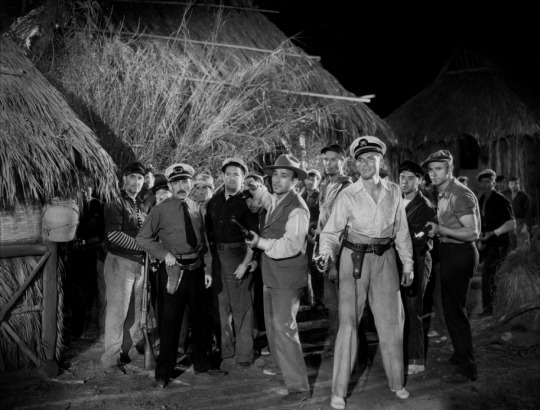
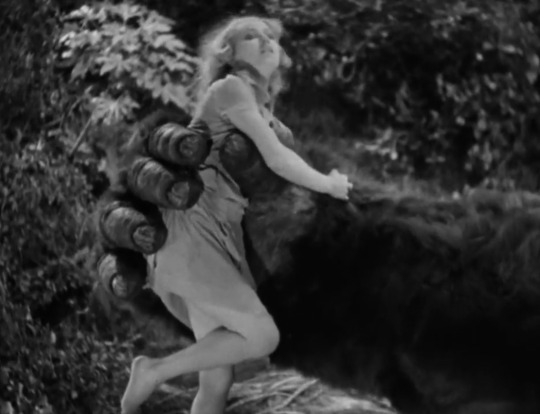
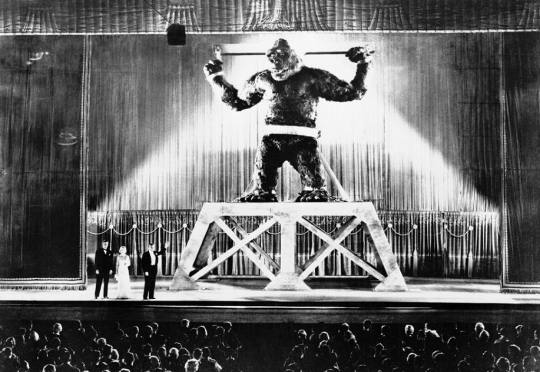
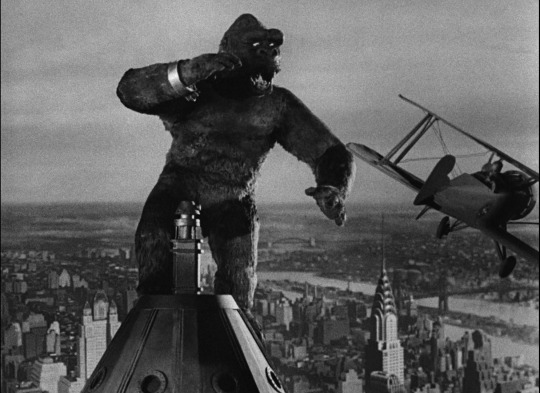
The latest movie for review was the one and only creature feature on the AFI top 100 list, the iconic Kong Kong (1933). This was the equivalent of a blockbuster for the time as it was first presented at Radio City Music Hall for 4 days and all shows were sold out. The film incorporated layering technology that had never been utilized before, which I assume made the experience of watching in a 9,000 attendance capacity crowd on a 30 foot screen an amazing experience. The film did not win any awards, but has since been recognized as a defining film for special effects in Old Hollywood. I was able to track down a version of the movie with commentary by Ray Harryhausen and I want to discuss what was revealed about the film production, but we should do a quick summary of the film first. I will not go into too much detail since the film has been remade three times now and most everybody knows the story, but I still need to do the standard...
SPOILER WARNING!!!! I AM GOING TO GIVE AWAY THE PLOT OF A MOVIE THAT IS 90 YEARS OLD AND HAS BEEN REMADE TWICE!!! IT WON’T EVEN BE THAT IN DEPTH, BUT I GET IN TROUBLE IF I DON’T SAY SOMETHING ABOUT SPOILERS!!! YOU HAVE BEEN WARNED!!!
-------------------------------------------------------------------
The film starts out with a movie director named Carl Denham (Robert Armstrong) who is looking to discover an actress. He has a map to a secret island and he wants to shoot a film there. He hired a ship with a crew and his producer has secured a camera, but an actress is still needed. Denham scours the streets looking for a pretty new face that is desperate enough to not ask questions. He quickly discovers Ann Darrow (Fay Wray) as she is trying to steal an apple from an apple cart. He pays for her, gives her some food, and whisks her away on the boat.
On the ship, it is revealed that only Denham knows where they are going. He has a hand drawn map to a place called Skull Island where there is a giant wall that contains a world of monsters. Ann Darrow falls in love with the first mate, Jack Driscoll (Bruce Cabot), by the time boat makes it to the island. A large group goes ashore and they run into natives in front of a huge wall with a giant door. There seemed to be some sort of ceremony involving the sacrifice of a young girl, but that changes when the natives see Ann and they want to take her for their ceremony. The group from the boat decides it is a good idea to get off the island, so they row back to the ship. In the night, a group of natives spirit away Ann and her absence is quickly noticed.
Fires and celebration light up the sky and the crew figures out that the natives stole their actress. The tribe is then shown opening up the giant door, tying Ann to some rocks inside the enclosure, closing the doors leaving her alone, and then hitting a gong to summon the beast. The sailors all run up on the natives right as Kong appears and takes away Ann. The group including Denham and Driscoll open the door and half the group chases after Kong deep into the enclosure.
All of the men who go inside are slowly picked off by either Kong or dinosaurs that live in the enclosure, which turns out to be somewhat of a Jurassic jungle. Kong has to constantly fight off beasts that want to steal Ann from him including an allosaur, pterodactyls, and what appears to be the Loch Ness monster. With the constant barrage of predators, the chase team of sailors is whittled down to just Driscoll and Denham. Denham goes back to the gate and Driscoll goes after Ann. During one of Kong’s monster distractions, Driscoll is able to steal Ann and they flee back to the gate with Kong following behind. Everyone gets out of the enclosure successfully, but Kong is so mad he breaks down the gate and wreaks havoc on the native village killing many. Our three main characters and a few of the sailors that stayed behind to guard the gate run back to the boats with Kong following, but Denham is able to throw a gas bomb in the face of the giant gorilla and he is subdued.
The beginning of Act 3 has the hardest cut between settings of any movie I have ever seen, yet it makes sense in the movie. Kong is somehow transferred to New York from Skull Island where the beast is chained up. Time has passed (I am not sure how much) but the giant ape will be revealed to the public at Radio City Music Hall. Denham has made $10,000 in one night in ticket sales to see the beast and gotten ahold of the press to document the occasion. It turns out that Driscoll and Ann are about to be married as well. All of this is neither shown nor explained outside of about 1 minute of dialogue. Anyway, back to the film...
Kong is being displayed for the public and Driscoll and Ann are dressed in their best that Denham has bought for them. The couple are introduced on stage and then the press is brought in to take pictures of the beast. Kong becomes so enraged by all of the flashing that he breaks his bonds and escapes. He is somehow able to get out into the streets where he stomps on people and destroys an elevated train. Ann and Driscoll escape and hide in a hotel which Kong is able to find. He does pick a lady out of the wrong room initially and he just drops her to her death. Second attempt gets a jackpot and Driscoll basically faints while a giant hand steals Ann.
After some more destruction, Kong takes Ann and climbs the Empire State Building. They get to the top and planes are sent in to shoot Kong off the building. Eventually he falls and dies on impact. Ann and Driscoll are OK and Denham walks out of the crowd to see the body of Kong at the base of the giant building. The movie ends with Denham saying the famous line. “Twas beauty that killed the beast.”
---------------------------------------------------------------------------
First, let me say what an absolute treat it was to watch this film with the commentary from the great Ray Harryhausen. That man is a class act with so much great insight into film making during the Golden Age of Hollywood. He was apparently 13 when the movie was released and he saw it in theaters on many occasions. The work of special effects director Willis O’Brien and producer Merian Cooper in King Kong influenced Harryhausen when he made The 7th Voyage of Sinbad, Jason and the Argonauts, and Clash of the Titans. The special effects in these films then influenced a huge list of great directors like James Cameron, Guillermo Del Toro, Tim Burton, Peter Jackson, J.J. Abrams, Wes Anderson, and George Lucas. I learned so much about the connection between King Kong and my favorite movies, it was just a great watch.
King Kong was actually made in three different sizes and there were multiple models of each. One giant gorilla head, which was manned by three men, with a single giant foot and a single arm with a hand, were made for the close up interaction shots with the actors. The fingers and toes on the full sized limbs had to be moved by hand (many very strong hands presumably) so there is no movement from the digits in these shots. A bunch of 2 foot wire framed puppets of Kong were made that could interact with the dinosaurs and the buildings around New York. Finally, a couple of six inch puppets were made to superimpose onto stock shots of the Empire State Building for the famous ending shots of Kong climbing the giant building..
Almost every shot in the film that didn’t involve a simple human interaction was created through layered shots. All the shots of the island, any shots of King Kong or any monsters, many shots of the jungle, and many shots of King Kong interacting in New York. The use of matte paintings in the far background with paintings on glass in front of those made all the shots seem deep and lush. In front of these were layered the stop motion puppets of Kong and the monsters and at the very front were humans and directly interactive props (cars, plants, huts, etc.). I never realized how much work went into every single shot of this film and I can see why it is so famous.
Another note is the direct influence on some of the most famous films of all time. The approach of King Kong started with sounds, went on to the effect of the great apes weight hitting the ground, and ended with the giant figure coming out from the trees. This method of introducing a monster has been highly copied, most notably the T-Rex in Jurassic Park.
The film was somewhat risque at the time and some of the film was cut on first release. Kong biting people and squashing natives was not originally included. There was a scene in which Fay Wray fell into water in her ripped white dress and that was not included. Also, Kong picks up a lady from the hotel that Ann is in and promptly drops her (she wasn’t blond so she has to go), which was harsh enough to be cut from the original release. None of this seems that bad today, but there were no restrictions on film in 1933 and studios didn’t know what would upset audiences.
One thing that struck me as funny while watching (and the commentators noted this as well) was how every character immediately loved and was willing to die for this blond white lady. Denham just found her on the street and the entire crew didn’t think she should be on board for about 3 minutes, then suddenly Driscoll loved her and the entire crew was willing to die horribly to save her. The natives took one look at her and thought she would make a better sacrifice then the young girl they had. Kong was willing to fight off all forms of monster to protect her. I thought he might have simply wanted a companion, but he tossed that other poor woman from the New York hotel down off a building. At the end, men shot the ape off the Empire State Building sending bullet spray everywhere in an effort to save the girl. I honestly don’t think she was worth it, but that is just one man’s opinion.
So is this film worthy of being on the AFI List? Absolutely yes. It does not have great acting, but the contribution to American cinema through the effects, the story, and the pure ambition is well worth a spot on the list. Would I recommend it? Across the board yes with no hesitation. I especially recommend watching with the commentary, if that is your thing, because watching this film and listening to Ray Harryhausen tell stories is an absolute treat. Definitely one of the best film watching experiences I have ever had.
#King Kong#1930s#black and white#american cinema#AFI list#special effects#stop motion#miniatures#introvert#introverts#classic film#ray harryhausen#commentary#dinosaurs
2 notes
·
View notes
Text
Love/Song/Kiss Prompt
(Matt Rodriguez x Addison Sinclaire) with the song Señorita and the prompts of sleeping in and a shy kiss as requested by @krsnlove

(Matt Rodriguez x Addison Sinclaire) and (Chris Winters x OC*Shannon Wright *HWU mc*) A Choices: Red Carpet Diaries Fan Fiction
A/N This song seems made for them. I went back to the Hollywood University days for this one and have my MC from that story app working with Addison for their final project for Professor Hunt.
tagging a few other RCD folks: @lilyofchoices @moodyvalentinestories @desireepow-1986
Masterlist
A Free Moment
Matt stepped into his trailer and peeled off the soaked t-shirt. He tossed it in a pile with the seven exact others. Today's shoot was brutal in the Miami heat. Add multiple pyrotechnics, and he had been more than happy being blown into the Atlantic Ocean.
With his new status as the number one action star in Hollywood, he had been offered numerous roles. He was terrified to step out of his comfort zone and try something new. What if he lost the chance to act? As much as he wanted to try something with fewer explosives and cheesy lines, he didn't feel the timing was right.
He paused drying off and opened his door.
"Here's the shooting schedule for next week." The assistant director handed him a sheet of paper
"I don't have a scene?" Matt asked.
"Martin thought you could use a break." He replied. "He wants you back the week after."
A grin formed on Matt's face. "Tell him I appreciate it." He shut the door and thought about what he might like to do with his free time.
***********
The next morning...
"Addi!" Shannon exclaimed. "We overslept!"
"Huh?" Addison lifted her head and rubbed her eyes. She reached for her alarm clock and shot up. "No! We missed our flight!"
"I know." Shannon dropped her head in her hands. "I can't believe it. Hunt is going to fail us for missing class. I just know it." Her panic grew. "Addi! We won't graduate in May!"
Addison shook her head. "We'll tell him we needed to stay longer to make sure we accurately depict club life in Miami for our short film."
Shannon flopped back on her pillow. "We are so screwed."
"Shannon!" Addison threw her pillow at her. "Who cares if Hunt fails us?"
"Me! I care!" Shannon argued. "I want to be taken seriously as an actress. Everyone knows if you study under Hunt that you can pretty much walk onto any set and be hired."
Addison hugged another pillow to her chest. "I promise to make this right. You'll become a famous actress. You'll marry another famous actor and have picture perfect babies."
Shannon snorted in her laughter. "Yeah right. 'Cause famous actors like Chris Winters are secretly holding out for someone like me."
"It could happen." Addison mumbled.
"It could." Shannon's brown eyes twinkled with mischief. "Right after I build the first apartment building on Mars."
"You really enjoyed that class project of building our own sets." Addison picked up her phone and silently ran through ways to get Hunt to excuse them.
Shannon sat up. "I know your powers of persuasion are extraordinary, but you haven't ever tested them out on Professor Hunt."
"You're making me so much more nervous." Addison pressed the call button under the grumpy professor's number.
It rang three times before his sharp voice answered.
"Hey Professor!" Addison said in her syrupy sweet voice.
"Ms. Sinclaire." Thomas replied. "I assume you are calling about an extension."
“Wow.” Addison said. “You must be part psychic.”
Shannon slapped her hand to her forehead. Hunt was going to throw them out of the university. She could practically see her degree going up in flames.
"More like that is the only reason students call." He corrected. "What reason are you about to give to keep me from marking zeros next to your name and Ms. Wright's?"
"Remember when we said our film was going to be a romance set amongst Miami's night life?" She began.
"Of course." He grumbled. "I also remember asking why you thought Miami would be the best setting for this story?"
"Ha! Yeah." Addison responded nervously. "Anywho, we decided to spend Spring Break in Miami to work on our film."
Silence was all she heard.
"And we, uh, need another few days to film the final act." She quickly said.
Shannon pulled a pillow over her face. They were doomed.
"I see." Hunt replied in a deadly serious tone.
"I promise, professor, that we have been hard at work this whole time." Addison pleaded. "We wanted our location to add another level to the story: two tourists meet and fall in love, then part ways knowing the promises to see each other again are not going to happen."
Shannon sat up and leaned closer to hear his response.
"Normally I would end the conversation with a do not bother darkening the classroom door. You have to learn that delays should be avoided at all cost when filming." He cleared his throat. "As it so happens, I have to cancel classes next week. I've been asked to be one of the judges for a film festival in Cordonia."
Shannon covered her mouth as she jumped up and down on her bed. Addison bounced on her own at the miracle. "That's awesome, Professor!"
"Yes, well, I expect your finished film to be waiting on my return the following Monday. Understood?" His tone dripped with icy disdain.
"It'll be there." Addison promised. "Thanks again Professor."
He grunted a goodbye.
Addison dropped back on her bed and kicked her feet into the air. "Woo! That was a close one."
***********
Matt sipped his drink while looking out at the packed South Beach nightclub. He had asked around the set on where he should go for a night out and everyone had recommended LIV. It was certainly interesting.
He had already spotted a handful of celebrities in film, music, and even a few athletes. He wished he saw someone that was an actual friend or at least someone he enjoyed being around.
He motioned for the bartender and ordered a refill. His attention dropped to the petite blonde that suddenly appeared beside him.
Her bright smile seemed contagious.
"Two tequila sunrises, please." She yelled out over the music. Her hips moved in time to the beat of the current song. She looked around at the patrons then finally lifted her eyes up at him.
His smile appeared making her blink.
He's...so...wow, she thought.
She smiled back.
He leaned down. "Hello."
Her eyes lowered. "Hi."
"Are you here with someone?" He asked.
"Just my friend." She pointed over where Shannon was. Her friend was dancing near the edge of the dance floor and it seemed that she had caught the attention of--
"Is that Chris Winters?!" Addison exclaimed.
"I think so." Matt chuckled at her shock. "Would you like to meet him?"
She twirled back around toward him. "You know Chris Winters?"
"Yeah, after we did that buddy cop film, Hickey and Marks, we--"
Addison covered her mouth. "You're Matt Rodriguez!"
He nodded. "And you are?"
"Matt Rodriguez!" She repeated in shock. She should have known who he was the moment she saw that sexy smile. "I have a poster of you shirtless over my bed." She dropped her head at that TMI.
"Really?" His smile couldn't get any bigger.
"Er, let's forget that last part." She let out a nervous laugh. "I'm Addison."
He shook her hand. "Want to dance?"
"Are you kidding? Of course!" Addison picked up her drinks and told him she needed to take this over to Shannon first.
He followed her and yelled out to Chris.
The actor looked around before spying Matt. His own highly recognizable smile popped up when he saw his old friend. He glanced at the beautiful brunette who was still oblivious to him.
Shannon looked past him when Addison called out to her. She squeezed past people trying to get out on the floor and ended up plastered against Chris.
Shannon looked up to apologize and froze.
Her shock brought out a chuckle.
"I--I am--so sorry." She stuttered.
"I'm not." He replied, his dimples deepening with his smile. "I have been spending fifteen minutes over here trying to work up the nerve to ask you to dance."
"You--me--here?" She took a deep breath and tried again. "You want to dance with me?"
His arms wrapped around her waist. "I'm just waiting on a slow song."
"Oh my--"
"Hi!" Addison looked back and forth at the two. "I brought Matt Rodriguez and a drink over."
Without taking her eyes off of Chris's face, Shannon took the offered glass. "Thank you."
Addison's lips curved in an excited smile. She just had the most brilliant idea ever. "Chris! How would you like to act out a scene with Shannon?"
"Who?" He mumbled still looking into Shannon's rich brown eyes.
"The one in your arms." Addison pointed out.
"I'd love to." He quickly responded. "As long as you would like me to."
"I would." Shannon managed to say. "It's a love scene for our student film project."
He pulled her closer. "Then we should rehearse."
Shannon’s lips parted with no words in response.
Matt watched his friend with a great deal of shock. Chris never acted like this with women. "He must have fallen hard." He whispered to Addison.
"I think she has too." She whispered back.
She set her empty glass down. "Come on." She took his hand and led him to the dance floor.
**************
The next few days found the four working on the girls' final project before graduation.
Days and nights were filled with getting to know one another and deciding how best to present their film. Matt helped Addison with all the behind the scenes while Chris coached Shannon with her acting. With the guys' input and star power along with Miami's setting, a film worthy to be shown in cinemas was created.
**************
Matt's suite...
"I can't believe it." Shannon threw her arms around Addison. She started hopping up and down with her as they watched the credits roll. "We did it! We made a movie!"
"I know!" Addison squealed some more. "I can't wait to get on that plane tomorrow."
Chris and Matt's delighted smiles dimmed.
"You leave tomorrow?" Matt asked.
The girls froze, realizing what that meant.
"Yeah." Addison's shoulders slumped.
Chris rubbed the back of his neck while looking at Shannon. "I won't be back in Hollywood for at least another two months."
Matt frowned. "A month for me if I'm lucky."
Shannon sat down on the couch. All her earlier joy had disappeared. "Oh."
"We still have tonight." Addison reminded them.
Chris straightened up and walked over to Shannon. "If you guys don't mind, I would like some time alone with Shannon. I--" he paused when she lifted her face up. "We need to make plans for when I return to California."
Shannon looked questionably at Addison and grinned when her friend nodded. "I'll see you back in our room Addi."
Once the couple were gone, Matt sat down beside Addison. "Is there anything you would like to do on our last night?"
She shook her head. "No." Her shy smile appeared. "I've had so much fun hanging out with you."
"Me too." His heartbeat skipping smile popped up. "I know we never really went on a date--"
"No. We didn't." She muttered, not even bothering to hide her disappointment.
"I don't suppose that once I'm back in L.A. that you might want to go out with me." He waited, his eyes touching on her face framed by her sun streaked golden curls.
Her bright blue eyes twinkled with mischief. "I might want to." She leaned closer toward him. "What would a date with Matt Rodriguez look like?"
His arm curved around her shoulders. "Pretty normal. Dinner. Dancing." He lowered his lips close to her cheek. "It's the ending that really makes it special."
She realized she had stopped breathing with that soft kiss touching her cheek. "Really? And how do these typically end."
Matt turned her face toward his. Their lips met and Addison pulled away, suddenly shy.
"You've probably kissed a dozen or so beautiful, talented women." She bit down on her bottom lip. "I'm more of a friend to guys like you--"
He captured her lips again. She melted against him under the passion he was conjuring with such a kiss. He lifted his head and met her awed gaze.
"Sorry Addison, but we will never be friends." He told her, smiling when she yanked him back for another kiss.
#choices matt rodriguez#rcd matt rodriguez#matt rodriguez x addision sinclaire#choices chris winters#thomas hunt#choices thomas hunt#choices red carpet diaries#hollywood university#pixelberry hwu
11 notes
·
View notes
Text
Interview with Mark A. Vieira, author of Forbidden Hollywood: The Pre-Code Era (1930-1934)

Mark A. Vieira is an acclaimed film historian, writer and photographer. His most recent book, Forbidden Hollywood: The Pre-Code Era (1930-1934): When Sin Ruled the Movies is now available from TCM and Running Press.
Raquel Stecher: Twenty years ago you wrote Sin in Soft Focus: Pre-Code Hollywood for Harry N. Abrams. Why did you decide to revisit the pre-Code era with your new TCM-Running Press book Forbidden Hollywood?
Mark A. Vieira: That’s a good question, Raquel. There were three reasons. First, Sin in Soft Focus had gone out of print, and copies were fetching high prices on eBay and AbeBooks. Second, the book was being used in classes at the USC School of Cinematic Arts. Third, Jeff Mantor of Larry Edmunds Cinema Book Shop told me that his customers were asking if I could do a follow-up to the 1999 book, which had gotten a good New York Times review and gone into a second printing. So I wrote a book proposal, citing all the discoveries I’d made since the first book. This is what happens when you write a book; information keeps coming for years after you publish it, and you want to share that new information. Sin in Soft Focus: Pre-Code Hollywood told the story of the Code from an industry standpoint. Forbidden Hollywood has that, but it also has the audience’s point of view. After all, a grassroots movement forced Hollywood to reconstitute the Code.
Raquel Stecher: Forbidden Hollywood includes reproduced images from the pre-Code era and early film history. How did you curate these images and what were your criteria for including a particular photograph?
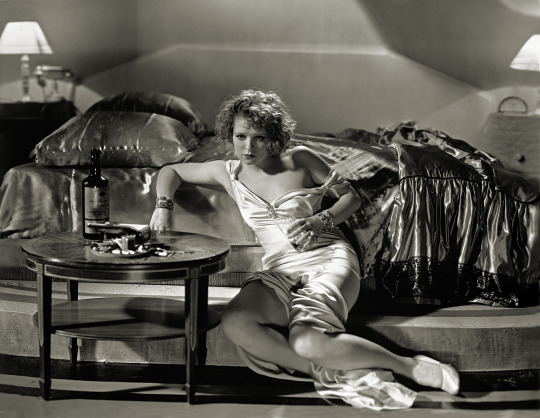
Mark A. Vieira: The text suggests what image should be placed on a page or on succeeding pages. Readers wonder what Jason Joy looked like or what was so scandalous about CALL HER SAVAGE (’32), so I have to show them. But I can’t put just any picture on the page, especially to illustrate a well-known film. My readers own film books and look at Hollywood photos on the Internet. I have to find a photo that they haven’t seen. It has to be in mint condition because Running Press’s reproduction quality is so good. The image has to be arresting, a photo that is worthy in its own right, powerfully composed and beautifully lit—not just a “representative” photo from a pre-Code film. It also has to work with the other photos on that page or on the next page, in terms of composition, tone and theme. That’s what people liked about Sin in Soft Focus. It had sections that were like rooms in a museum or gallery, where each grouping worked on several levels. In Forbidden Hollywood, I’m going for a different effect. The photo choices and groupings give a feeling of movement, a dynamic affect. In this one, the pictures jump off the page.
Raquel Stecher: Why did you decide on a coffee table art book style format?
Mark A. Vieira: Movies are made of images. Sexy images dominated pre-Code. To tell the story properly, you have to show those images. Movie stills in the pre-Code era were shot with 8x10 view cameras. The quality of those big negatives is ideal for a fine-art volume. And film fans know the artistry of the Hollywood photographers of that era: Fred Archer, Milton Brown, William Walling, Bert Longworth, Clarence Bull, Ernest Bachrach and George Hurrell. They’re all represented—and credited—in Forbidden Hollywood.

Raquel Stecher: What was the research process like for Forbidden Hollywood?
Mark A. Vieira: I started at the University of Southern California, where I studied film 40 years ago. I sat down with Ned Comstock, the Senior Library Assistant, and mapped out a plan. USC has scripts from MGM, Universal and the Fox Film Corporation. The Academy Library has files from the Production Code Administration. I viewed DVDs and 16mm prints from my collection. I reviewed books on the Code by Thomas Doherty and other scholars. I jumped into the trade magazines of the period using the Media History Digital Library online. I created a file folder for each film of the era. It’s like detective work. It’s tedious—until it gets exciting.
Raquel Stecher: How does pre-Code differ from other film genres?
Mark A. Vieira: Well, pre-Code is not a genre like Westerns or musicals. It’s a rediscovered element of film history. It was named in retrospect, like film noir, but unlike film noir, pre-Code has lines of demarcation—March 1930 through June 1934—the four-year period before the Production Code was strengthened and enforced. When Mae West made I’M NO ANGEL (’33), she had no idea she was making a pre-Code movie. The pre-Code tag came later, when scholars realized that these films shared a time, a place and an attitude. There was a Code from 1930 on, but the studios negotiated with it, bypassed it or just plain ignored it, making movies that were irreverent and sexy. Modern viewers say, “I’ve never seen that in an old Hollywood movie!” This spree came to an end in 1934, when a Catholic-led boycott forced Hollywood to reconstitute the Code. It was administered for 20 years by Joseph Breen, so pre-Code is really pre-Breen.

Raquel Stecher: What are a few pre-Code films that you believe defined the era?
Mark A. Vieira: That question has popped up repeatedly since I wrote Sin in Soft Focus, so I decided which films had led to the reconstituted Code, and I gave them their own chapters. To qualify for that status, a film had to meet these standards: (1) They were adapted from proscribed books or plays; (2) They were widely seen; (3) They were attacked in the press; (4) They were heavily cut by the state or local boards; (5) They were banned in states, territories or entire countries; and (6) They were condemned in the Catholic Press and by the Legion of Decency. To name the most controversial: THE COCK-EYED WORLD (’29) (off-color dialogue); THE DIVORCEE (’30) (the first film to challenge the Code); FRANKENSTEIN (’31) (horror); SCARFACE (’32) (gang violence); RED-HEADED WOMAN (’32) (an unrepentant homewrecker); and CALL HER SAVAGE (’32) (the pre-Code film that manages to violate every prohibition of the Code). My big discovery was THE SIGN OF THE CROSS (’32). This Cecil B. DeMille epic showed the excesses of ancient Rome in such lurid detail that it offended Catholic filmgoers, thus setting off the so-called “Catholic Crusade.”
Raquel Stecher: It’s fascinating to read correspondence, interviews and reviews that react to the perceived immorality of these movies. How does including these conversations give your readers context about the pre-Code era?
Mark A. Vieira: Like some film noir scholars, I could tell you how I feel about the film, what it means, the significance of its themes. So what? Those are opinions. My readers deserve facts. Those can only come from documents of the period: letters, memos, contracts, news articles. These are the voices of the era, the voices of history. A 100-year-old person might misremember what happened. A document doesn’t misremember. It tells the tale. My task is to present a balanced selection of these documents so as not to stack the deck in favor of one side or the other.
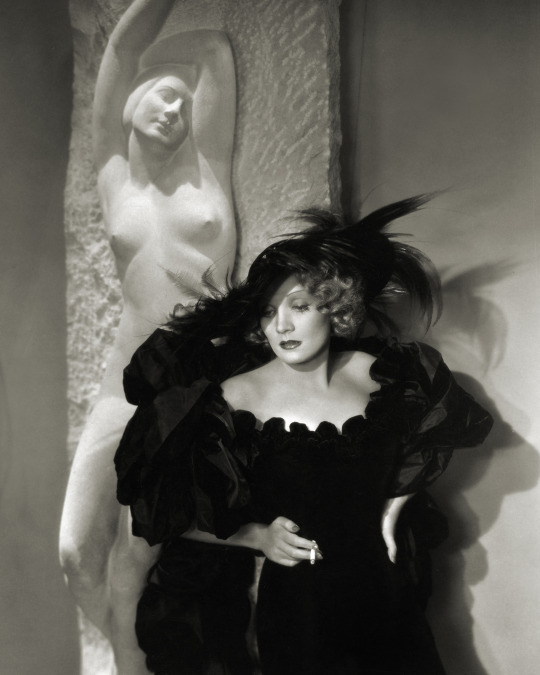
Raquel Stecher: In your book you discuss the attempts made to censor movies from state and federal government regulation to the creation of the MPPDA to the involvement of key figures like Joseph Breen and Will H. Hays. What is the biggest misconception about the Production Code?
Mark A. Vieira: There are a number of misconceptions. I label them and counter them: (1) “Silent films are not “pre-Code films.” (2) Not every pre-Code film was a low-budget shocker but made with integrity and artistry; most were big-budget star vehicles. (3) The pre-Code censorship agency was the SRC (Studio Relations Committee), part of the Motion Picture Producers and Distributors Association (MPPDA)—not the MPPA, which did not exist until the 1960s! (4) The Code did not mandate separate beds for married couples. (5) Joseph Breen was not a lifelong anti-Semite, second only to Hitler. He ended his long career with the respect and affection of his Jewish colleagues.
Raquel Stecher: How did the silent movie era and the Great Depression have an impact on the pre-Code era?
Mark A. Vieira: The silent era allowed the studios the freedom to show nudity and to write sexy intertitles, but the local censors cut those elements from release prints, costing the studios a lot of money, which in part led to the 1930 Code. The Great Depression emptied the theaters (or closed them), so producers used sexy films to lure filmgoers back to the theaters.
Raquel Stecher: TCM viewers love pre-Codes. What do you think it is about movies from several decades ago that still speak to contemporary audiences?

Mark A. Vieira: You’re right. Because we can see these films so readily, we forget that eight decades have passed since they premiered. We don’t listen to music of such a distant time, so how can we enjoy the art of a period in which community standards were so different from what they are now? After all, this was the tail end of the Victorian era, and the term “sex” was not used in polite society. How did it get into films like MIDNIGHT MARY (’33) and SEARCH FOR BEAUTY (’34)? There were protests against such films, and there were also millions of people enjoying them. What they enjoyed is what TCM viewers enjoy—frankness, honesty, risqué humor, beautiful bodies and adult-themed stories.
Raquel Stecher: What do you hope readers take away from your book?
Mark A. Vieira: One thing struck me as I wove the letters of just plain citizens into the tapestry of this story. Americans of the 1930s wrote articulate, heartfelt letters. One can only assume that these people were well educated and that they did a lot of reading—and letter writing. I want my readers to read the entire text of Forbidden Hollywood. I worked to make it accurate, suspenseful and funny. There are episodes in it that are hilarious. These people were witty! So I hope you’ll enjoy the pictures, but more so that you’ll dive into the story and let it carry you along. Here’s a quote about SO THIS IS AFRICA (‘33) from a theater owner: “I played it to adults only (over 15 years old). Kids who have been 12 for the last 10 years aged rapidly on their way to our box office.”
#pre-Code#TCM#Forbidden Hollywood#pre-code films#interview#jean harlow#mae west#ginger rogers#Depression era#1930s#Raquel Stecher
257 notes
·
View notes
Text
Sinner’s Holiday: An Ode to Pre-Code

Once upon a time, Hollywood movies showed us Spencer Tracy skinny-dipping with Loretta Young, Barbara Stanwyck ducking into the ladies’ room with her boss in exchange for a promotion, and chorus girls warbling hosannas to marijuana.1 This, of course, was pre-Code: shorthand for the era of Hollywood movie-making between the advent of sound in 1929 and the ascendance of Hays Office censorship in 1934. The term is in fact a misnomer. The Production Code was written and officially adopted in 1930, but for the next four years, like Prohibition, it was flouted with near impunity. A look at a representative film of the time provides ample evidence of the Code’s impotence. Take Night Nurse (Wellman, 1931), starring Barbara Stanwyck: a fast, tough, sleazy and thoroughly enjoyable tale of a nurse who uncovers a plot to murder the children in her care for their trust funds.
The Code proclaimed that Undressing scenes should be avoided, and never used save where essential to the plot. Stanwyck and her roommate, played by Joan Blondell, often speak their lines while casually changing their clothes in front of the camera. An intern who walks in on Stanwyck in her scanties assures her, “You can’t show me a thing. I just came from the delivery room.” The Code said, The use of liquor in American life…shall not be shown. The mother of Stanwyck’s charges, who is never seen in any other state than blotto, boasts, “I’m a dipshomaniac—and I like it!” Stanwyck befriends an amiable bootlegger when she treats his bullet-wound and agrees not to report it, contrary to law. In gratitude, he sends her a bottle of rye. “But you’re not allowed to drink,” a square nurse objects. “No,” Blondell cracks, “But it’s swell for cleaning teeth.” Adultery and profanity are both proscribed by the Code. The dipsomaniac is plainly carrying on a tawdry affair with her chauffeur, Nick (Clark Gable), and at one point Stanwyck, disgusted to find her passed out while her children are on the brink of death, rebukes her with, “You mother.” The Code said, Methods of crimes should not be explicitly presented. When sent out to get milk for the sick children, the amiable bootlegger breaks into a grocery store. As for Revenge in modern times shall not be shown, the movie ends with the bootlegger arranging for Nick to be “taken for a ride.” Did I forget to mention that Apparent cruelty to children or animals, the central trope of the plot, is also forbidden by the Code? Or that Gable socks Stanwyck on the jaw, or that Stanwyck gets her job by flashing her ankles at a doctor?
Code? What Code?
The appeal of pre-Code movies lies not in sex, violence or vulgarity (there’s more than enough of those in the infinitely more explicit cinema of the last forty years) but in their attitude, which conveyed the pessimism and irreverence of their time. Radical cultural changes in the wake of World War I, the farce of Prohibition, the 1929 stock-market crash and the Great Depression combined to create a pervasive disillusionment and loss of respect for authority and traditional values. With rapid changes in fashion and technology, violent upheavals in economic and political conditions, society was wide open, hectically elated in the twenties, confused and frightened in the thirties. For a few years the lack of rigorous censorship allowed movies to channel the mood of the country and to capture society warts and all. They depicted adultery, divorce, rape, prostitution and homosexuality; bluntly portrayed alcoholism and drug addiction, glorified gangsters, con artists and fallen women. With a distinctive blend of cynicism and exuberance, they offered escapist entertainment but also bitter and sometimes radical visions of a society on the verge of breakdown. Oscar Levant famously quipped that he he knew Doris Day before she was a virgin; Hollywood too was grown up before it was innocent.

The Con Man as Comic Hero: Blonde Crazy
During the silent era, censorship of films was piecemeal. Not only states but individual towns had boards of censors who screened movies and ordered cuts of shots or scenes they considered too racy. Projectionists simply snipped out the offending material, a practice that accounts in part for the incompleteness many surviving films from the twenties.2 In the early twenties, Hollywood was hit with a string of off-screen scandals, culminating in the trial of comedian Roscoe Arbuckle on charges of rape and manslaughter. The movie moguls, terrified that bad press would scare away audiences, invited Will Hays to become the guardian and public face of Hollywood’s morals. Hays, a Presbyterian elder and former postmaster general, became director of the Motion Picture Producers and Distributors Association. He was an ideal choice to project a more wholesome image of Hollywood, but as a censor he proved ineffectual, and movies continued to be attacked for their evil influence on the country’s moral fiber.
Silent movies contained many elements that would not be seen during the Code era, including nudity, drug use and comic vulgarity. But the absence of sound gave film a degree of unreality that lent itself to fantasies like Valentino as an Arab sheik and Douglas Fairbanks riding a flying carpet, as well as to timeless moral fables like Sunrise: a Song of Two Humans, whose characters are called simply The Man and His Wife. From Mary Pickford as a spunky urchin to Harold Lloyd as a college freshman, actors frequently played much younger and more naive than they were in real life. Even the flapper films of Clara Bow and Joan Crawford, which purported to expose the shocking mores of modern youth, presented their heroines as pure though misunderstood. With the change to talkies, the silent era’s swashbuckling heroes, Great Lovers, ringleted sweethearts and carefree flappers suddenly seemed antiquated. Sound punctured fantasy and brought movies down to earth and up to date: never again would they soar to the heights of romance they had reached in silence.

The coming of sound involved a complete reinvention of movies, amounting to the development of a new medium. The fluid spectacles of the silent screen gave way to small-scale films confined by the technical limitations of early sound recording technology to interiors and studio sets. The bulk of films from 1929 and ’30 are clunky and static, with stilted dialogue and acting. When talkies hit their stride in the early thirties it was with urban settings that could be recreated on studio backlots and zingy vernacular dialogue delivered at machine-gun pace by Brooklyn-bred voices. As the old screen gods faded, snappy young urbanites like James Cagney and Joan Blondell entranced audiences with their unaffected style and wised-up attitude.3 This new earthiness brought the censorship issue to a crisis; everyone agreed that movies were going “from bad to voice.” In 1930, still hoping to render external censorship unnecessary through self-regulation, the studio moguls officially adopted the Production Code, written largely by a Jesuit priest named Daniel Lord (hence it should, aptly, be known as the Lord’s Code rather than the Hays Code.) But this effort coincided with the onset of the Depression, when the movie studios were struggling like other businesses. Desperate to lure audiences back to theaters they defied the Code to create daringly risqué entertainment, treating the list of “Don’ts and Be Carefuls” as a list of “Do’s.”
The kick in pre-Code movies comes from the awareness shared by the actors and filmmakers that they are pushing the limits, getting away with something. Since today’s films must work so hard to raise an eyebrow, they can never recapture the harmless fizz of Maurice Chevalier taking Jeannette MacDonald’s measurements in Love Me Tonight, or Jean Harlow slipping a portrait of her boss into her garter in Red-Headed Woman, or Miriam Hopkins and Herbert Marshall in Trouble in Paradise picking each other’s pockets over the course of a romantic meal. (“I trust I may keep your garter?”)
There was a Code, after all, and movies were never completely uncensored. Because they couldn’t get away with explicitness or profanity, pre-Code movies specialized in innuendo. A line that would register with sophisticated adults but fly over the heads of children or more naïve viewers was considered ideal; it would protect the innocent while enticing the experienced. In The Half-naked Truth, a scheming promoter played by Lee Tracy checks into a fancy hotel with a Mexican carnival dancer he is passing off as a Turkish princess. Also with them is rotund Eugene Pallette, wearing a turban. The hotel clerk looks at the register Tracy has filled out and does a double take at Pallette. “Oh, they have them in all Turkish harems,” Tracy says, adding confidentially, “He’s very sensitive about it.” The joke is carried through the movie without a word being spoken that could bring a blush to the most prudish cheek. Pre-Code wasn’t always this artful—there’s nothing subtle about Dick Powell singing “I’m Young and Healthy” in a tunnel of chorus girls’ legs, or Tarzan and Jane romping around the jungle in loin cloths—but in general the naughtiness was low-key, not flaunted but there to be discovered by the alert viewer.
Movies offered vacations from reality in sleek art deco style: gleaming penthouses with twinkling views of Manhattan, shimmering bias-cut evening gowns and shiny top hats, buoyant jazz scores and intoxicated gaiety. Beyond mere escapism, there’s a loopy, zany, surreal streak in pre-Code that flourishes in the early Marx Brothers and W.C. Fields films, in Busby Berkeley musicals with their kaleidoscopes of semi-nude chorines and in the cartoons of the Fleischer Brothers, where Cab Calloway lends his voice to a ghostly dancing walrus singing “The St. James Infirmary Blues.” There’s a dizzy feeling, as if the whole of society, like Jack Lemmon in Some Like it Hot, had an empty stomach and it went to their heads.
Maybe it was the effect of hearing so often that prosperity was just around the corner while the country sank deeper and deeper into despair. Demented optimism was parodied—or endorsed; it’s hard to tell—in a bizarre cartoon short from Columbia Studios called Prosperity Blues. A world of wretched, baggy-eyed, trembling sufferers, of cobweb-infested banks and pitiful apple-peddlers, is transformed into a fascistic spectacle of crazed cheerfulness as the hero, to the tune of “Happy Days Are Here Again” slaps disembodied grins on people’s faces with the command “Smile, darn ya, smile!”
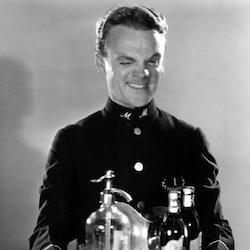
“The age of chivalry is over,” James Cagney declares in Blonde Crazy (Del Ruth, 1931). “This, honey, is the age of chiselry.” Tough yet ebullient, Cagney personifies the essential pre-Code flavor of hard-boiled high spirits, sarcastically knowing and gleefully amoral, but not sour or misanthropic. Like nightclub owner Texas Guinan who greeted her customers with a hearty, “Hello, suckers!” the con artist hero of Blonde Crazy seems high on his own cynicism. Or maybe punch-drunk: you need a score card to keep track of how many times Joan Blondell slaps him, and he keeps coming back for more.
The films of Hollywood’s classical period are tight, smooth, polished. The scripts, dialogue, acting, lighting and art direction all gleam with controlled craftsmanship. Blonde Crazy, by contrast, skates on the verge of chaos: the actors seem to be winging it, cutting loose, seeing how far they can go. Cagney revels in this freedom, indulging in outrageous vocal mannerisms, flaunting his virtuosic control of his body as he darts and weaves through the role like a boxer in the ring, going from crafty schemer to world-class chump, wise-cracking operator to heart-broken lover. The anarchic, free-wheeling atmosphere of pre-Code, mined with slapstick and doubles entendres, often leaves modern audiences incredulous. Did I really hear that? Did they really mean...?
Like Night Nurse, Blonde Crazy methodically defies the Code. Undressing scenes? Cagney walks in on Blondell in the tub and appreciatively examines her underwear, doing a little shimmy with her panties, playfully holding her bra over his eyes like a pair of goggles. Liquor in American life? In an early scene Cagney, a bell-hop in an anything-goes hotel, peddles bootleg booze to a traveling salesman (Guy Kibbee). Adultery? Cagney and Blondell’s first con involves setting up the same salesman: caught “parking” with Blondell and a bottle of hooch, he offers a hefty bribe to the “cop” who’s actually their accomplice. Methods of crimes? The depiction of the movie’s confidence tricks, including a daringly simple ploy by which Cagney lifts a diamond bracelet from a jewelry store, is so detailed the viewer could easily copy them. Revenge in modern times? The movie lovingly details the means by which Blondell succeeds in fleecing a fellow con man who previously fleeced Cagney.
One scene is set in an elegant hotel lobby where men discuss the races while women share their plans to blackmail men with love letters. Every single person here is on the make. “Everyone has larceny in his heart,” Bert (Cagney) explains to Ann (Blondell) when he asks her to join him in the rackets. She’s reluctant, but only because she’s afraid of getting caught and sent to jail. Still, as the movie’s only hint of a conscience, she objects to out-and-out thievery and feistily protects her virtue. Bert keeps making passes at her and she keeps slapping his face, without harming their affectionate partnership. But the pair’s toughness keeps them from admitting the depths of their feelings. “I’ve wanted you ever since I saw you,” he tells her earnestly, then shrugs dismissively, “But if I can’t have you I’ll have someone else.” Still, by the time Ann tells him she’s marrying another man, your heart bleeds for Bert, the chiseler with the wandering eye. The other man is Joe Reynolds (Ray Milland) who chivalrously takes a cinder out of her eye and sends her a book of Browning (the poet, not the automatic, as Philip Marlowe would say.) She tells Bert that she’s going to marry Reynolds because he and his family know “a better way to live.” They care for “music and art and that kind of thing.” Of course he turns out to be the biggest louse of all, stealing from his firm and exploiting Bert’s devotion to Ann to make him the patsy. Bert winds up in jail and shot full of holes, but at least Ann finally admits her love and promises to wait for him.
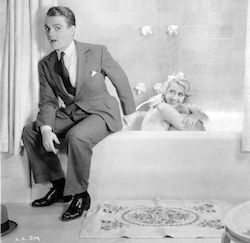
Joan Blondell was the best love interest Cagney ever had. More than able to stand up to him, she brings out an unexpectedly tender and sexy side of his cocky, wound-up persona. With her wide-eyed, appetizing looks, Blondell has a warm, open front but an inner reserve and caution. Like her fellow Brooklynite Barbara Stanwyck, she was born wised-up. Cagney too, for all his extroverted energy, has a core that is aloof, introverted, nervously intense. It is touching to see these two wary, skeptical souls embrace each other so openly. They have good reason to be wary; only suckers trust anyone in the world of Blonde Crazy. Con artists con fellow con artists, and “respectable” citizens lack basic decency. Near the end of the movie, another con man tries to interest Bert in a ploy that involves tricking the relatives of the recently deceased into paying for good luck charms that the dead supposedly ordered just before “kicking off.” Anyone stupid or trusting enough to be conned deserves to lose his money. Life is a continuous game of one-upmanship, a contest to see who can laugh last.
In Guys and Dolls, Sky Masterson explains that among his people, “to be marked as a chump is like losing your citizenship.” During the early thirties, audiences who felt like victims of an economic swindle reveled in the exploits of sharpies, shysters, smart guys who know all the angles and who outwit hypocritical representatives of wealth, authority, respectability. Cagney played more con men than gangsters: in Jimmy the Gent, as “the greatest chiseler since Michelangelo,” he asserts, “There’s only two kinds of guys in business, the ones that get caught and the ones that don’t get caught.” But for all his street smarts, Cagney has moments of child-like naivité. “The consummate urban provincial,” as Andrew Sarris called him, Cagney is irrepressible rather than unflappable. His driving energy, self-mocking humor, hot temper and sentimental streak expressed the pre-Code mood—fast-paced, excitable, hustling for a buck—as Bogart’s world-weary postwar cool expressed the mood of noir.
Later in the thirties, Frank Capra would glorify his own version of the sucker: in his films Gary Cooper and Jimmy Stewart embody the soul of America as innocent, optimistic, easily fooled. Smart cookies like Stanwyck and Jean Arthur would crumble in the face of such purity, renouncing their hardened attitude and determination to get ahead by any means necessary. Even pre-Code movies often bow, sometimes wistfully and sometimes perfunctorily, towards the old-fashioned virtues. Chivalry makes a come-back in the final scene of Blonde Crazy, one of the few genuinely romantic moments in Cagney’s career as he gazes up at Blondell with shining, worshipful eyes. Bert has demonstrated that love can turn a crooked guy into a knight in shining armor. But he’s got a prison stretch ahead of him, and then—what? Will he go straight, get a job? It’s hard to feel any great confidence in his future, since the lasting impression left by the film is that the cornerstone of American society is the confidence trick.
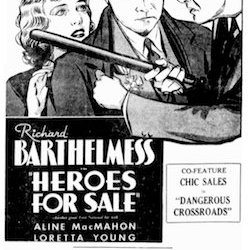
“The End of America”: Heroes for Sale
The pre-Code years corresponded to the nadir of the Great Depression, when disgust with Herbert Hoover’s government deepened the country’s black mood, when the homeless called their shanty-towns “Hoovervilles” and the newspapers they wrapped themselves in “Hoover blankets.” Law-abiding citizens made folk heroes out of bank robbers like Dillinger and Bonnie and Clyde, while hoboes sang of a utopia where “all the cops have wooden legs” and “the railroad bulls are blind.” The “bulls” were notorious for beating the hoboes they caught, shooting at them or forcing them to jump from speeding trains; even young teenagers weren’t spared. Being broke, jobless and homeless was treated not as a misfortune but as a crime. In the South, many towns used transients as slave labor: arrested on freight trains or in rail yards, they were put to work on chain gangs, and when their sentences were up, put back on the trains they’d been arrested for riding and told to get out of town. Communities posted signs, “Jobless men keep going—we can’t take care of our own.” Some towns denied medical care to travelers who fell ill or were injured, simply dumping them outside the city limits. Before the 1932 election of Franklin D. Roosevelt, many people felt the country was drifting towards anarchy or revolution.
Not all movies of the time were escapist fantasies; many pre-Code films were “ripped from the headlines.” Warner Brothers even confronted the Depression in a musical, Golddiggers of 1933. The opening number, “We’re In the Money,” is pure wish-fulfillment, as chorus girls wearing only strategically placed gold coins crow that “Old Man Depression” is through and that, “We never see a headline about a breadline today.” This giddy fantasy shatters when it is revealed to be a rehearsal for a show that has to close down because the producers can’t pay rent for the theater. Soon the chorus girls are staying in bed all day (three to a bed) because they have nothing to eat. The plot invites us to enjoy watching Joan Blondell earn money the easy way again, squeezing it out of a man who is rich, self-righteous and not very bright. Golddiggers is fluff, but it concludes with a musical number that makes a powerful if disconcerting stab at social realism.
This is social realism à la Busby Berkeley, so Blondell dons a black satin dress and stands under a lamppost, suggesting that unless the government helps jobless men their wives will be reduced to peddling themselves in the street. “Remember my forgotten man,” she sings, “You put a rifle in his hand / You sent him far away / You shouted hip hooray / But look at him today…”4 The song is taken up by a black woman sitting in an open window, surrounded by other women posed to look like F.S.A. portraits: a gaunt and worried farm wife, a starved and empty-eyed grandmother. Meanwhile endless lines of men are seen marching off to war, stumbling through the muddy trenches, then shuffling along in breadlines. This was torn from some very fresh headlines: in the summer of 1932 thousands of World War I veterans, known as the Bonus Army, had camped out on the Mall in Washington, D.C., asking the government to pay them the financial bonuses they were promised for their war service in advance, since many of them were unemployed and destitute. The army under Gen. Douglas MacArthur violently dispersed the men and their families, inspiring outrage. In this frivolous Hollywood musical, Blondell confronts a policeman who is rousting a bum out of a doorway, pointing to the military medal pinned to the inside of the man’s shabby lapel. Her eyes burn with pure hatred for the cop.
In these desperate times, both socialism and fascism were touted as viable alternatives to America’s problems. Several Hollywood movies offered glowing visions of benevolent totalitarianism: in Gabriel Over the White House, produced by William Randolph Hearst in 1932, Walter Huston plays a president who seizes dictatorial powers for the good of the country and proceeds to get rid of gangsters by trying them in military courts without constitutional protections. (Sound familiar?) In The Mayor of Hell, the boys in an ethnically diverse and racially integrated reform school are offered the chance to run the place as a children’s democracy, and when a tyrannical director tries to destroy this system, they try him in a kangaroo court complete with flaming torches.
The government’s helplessness or callousness in the face of economic crisis was not the only source of disenchantment with authority. The prohibition of alcohol, enacted in 1920, turned the vast majority of Americans into criminals, law enforcement into hypocrites, and bootlegging gangsters into society’s pets. Meanwhile, in the late 1920s the lingering wounds of the Great War, initially suppressed by a generation desperate to forget, resurfaced as people began to take stock of what they now viewed as a ghastly waste of life. Pacifism was widely embraced; in 1933 the hallowed Oxford University Student Union debated and passed the statement, “That this House will in no circumstances fight for its king and country.” Movies like All Quiet on the Western Front and The Last Flight expressed horror at the costs and pointlessness of the war, while others called attention to the plight of veterans struggling to survive in the country for which they had fought.
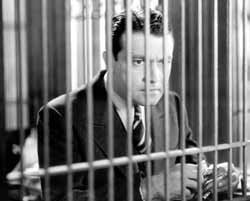
Heroes for Sale (Wellman, 1933) is one of the bleakest films to come out of Hollywood during the studio era. What the confidence trick is in Blonde Crazy, gross injustice is in Heroes for Sale: the basic building block of American society. Richard Barthelmess plays the American everyman as Job, afflicted not by mere bad luck but by unfairness, misunderstanding and the heartlessness of the powerful. In the teens and twenties, Barthelmess had played pure-hearted farm boys in silent melodramas like Way Down East and Tol’able David; he stood for integrity, trustworthiness and boyish optimism. By 1933, his fresh handsome face looked tired and worn, prematurely defeated even at the start of the movie, when he supposed to be just 25. The story begins in the trenches during the War, and the first thing we see is an officer issuing a command for a raid intended to gain prestige by capturing a German officer. When a subordinate objects that the plan will amount to suicide, he snaps, “Suicide or not, it’s orders,” and tells the other officer to take nine or ten men, because “that’s all I can afford to lose.” This kind of callous abuse of power will recur throughout the film, until the penultimate scene in which armed policemen drive homeless men from their shelter into the rain, ignoring the plea that they are not bums but veterans.
Tom Holmes (Barthelmess) is one of the nine or ten expendables chosen for the mission, and when his superior officer turns yellow and refuses to leave the shell-hole where they are hiding, he single-handedly knocks out a machine-gun nest and captures a German officer, only to be wounded and left for dead on his way back. His own officer, Roger, takes credit for the escapade and wins the Distinguished Service Cross, while Tom is taken to a German hospital where he is treated humanely but given morphine to ease the pain of shell-fragments in his spinal column, starting him on the road to addiction. Back home, he winds up working in the bank owned by Roger’s father, who self-righteously fires him when he learns of his drug problem. Roger is a weak, nervous, sweaty-palmed villain; he feels bad about stealing Tom’s glory and allowing him to suffer unfairly, just not bad enough to do anything about it.
For a while things look up for Tom. In Chicago he falls in with a friendly father and daughter who run a café, gets a good job at a laundry, and marries a beautiful young woman (Loretta Young). But as soon as he reaches higher he is shot down. He agrees to help promote a friend’s invention to mechanize the laundry, but when his benevolent boss dies, the new owners use the machine as an excuse to fire all their workers. The workers blame Tom and start a riot, in which his wife is accidentally killed. As if that weren’t enough, he is blamed for leading the riot he was trying to stop and sentenced to five years hard labor. When he gets out, he’s still marked as a “Red” and driven out of town by government agents. By now the country is in the grip of the Depression, and he joins the army of hoboes riding the rails. Achieving secular sainthood, Tom gives away the fortune he earned from the laundry machine to fund a soup kitchen. And when he finally encounters Roger again, also on the bum after serving jail time for embezzling, Tom counters Roger’s pessimism (“The country can’t go on this way. This is the end of America”) with a pat speech about how the country isn’t licked and will rise again, just like Roosevelt said in his inaugural speech. Angry and anguished throughout much of the film, by the end he has slipped into a kind of haloed masochism. Despite his clichéd words, what he embodies is not can-do optimism but the kind of enlightened detachment that comes from having nothing more to lose.
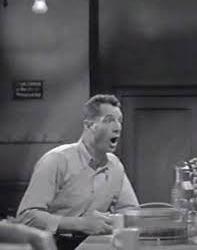
“The only thing that matters is money. Without it you are garbage. With it you are a king.” These words are spoken by Max, the German inventor who makes Tom rich and indirectly ruins his life. Max is a ludicrous stereotype, starting out as a ranting communist and abruptly turning into a greedy plutocrat (when someone points out that he used to hate capitalists he responds, “Of course—because I had no money then!”) In its one idyllic interlude, the film shows a workplace where capital and labor cooperate in smiling harmony and the boss is even willing to use mechanization to give employees more leisure and easier jobs without cutting the workforce or lowering salaries. This utopian fantasy, along with the café whose owners give to the poor even as they struggle to survive, suggest that the only solution to the country’s problems is selfless generosity. Unfortunately, the movie also implies that heartlessness and blinkered malice are far more common.
Heroes for Sale is not a lucid analysis of economic problems, and despite a gritty atmosphere it lacks the objectivity of neo-realism. At once bitter and sentimental, it portrays the whole of American society as a “you-must-pay-the-rent-I-can’t-pay-the-rent” melodrama, with villains as vile and heroes as pure as those in a D.W. Griffith tale of wronged innocence. Many pre-Code movies invite the viewer to identify with and root for people who cheat to get ahead: gangsters, con artists, gold-diggers. Heroes for Sale instead asks us to identify with an innocent and virtuous but hapless and often helpless hero. If people fantasized about being one of Cagney’s confident, cynical operators—predators rather than prey—they saw themselves as Tom Holmes: down on their luck, taking one hit after another, but struggling on and clinging to hope.
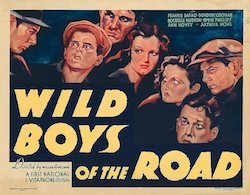
Wellman’s next film was Wild Boys of the Road, his famous portrait of teenage hoboes, which grinds through hardship and injustice only to veer into shining idealism in the last five minutes. Two middle-class high-school boys turn into ragged panhandlers, one a cripple, the other stooping occasionally to petty theft. A crowd of vagrants bands together to attack and kill a brakeman who has raped a teenage girl, and to fight off the “bulls” who try to put them off a freight train. It’s easy to imagine audiences cheering as the young bums pelt the cops with eggs and fruit, and booing when the cops use fire hoses to drive them from the shanty-town they have built in disused sewer pipes. The hobo community is painted as loyal, diverse and supportive (blacks and girls are treated as equals), but no one is having any fun. They’re not wild, just bone-weary. The protagonists wind up in New York, living in a garbage dump, and one is tricked into taking part in an attempted robbery. But when they are hauled before a judge, instead of coldly meting out injustice like the judge in Heroes for Sale, the kindly man lectures the youths on how things are going to be better now, they will get a fresh chance, as the camera pans up to the National Reconstruction Administration poster above his head (“We Do Our Part”). The ending looks like a cop-out now, but audiences of the time probably cheered it too.
The pre-Code era was vanquished not only by stricter censorship but by the mood swing following Roosevelt’s inauguration, when the desperate country embraced the promise of a “new deal for the American people.” Pictures of FDR went up next to icons of Jesus; at the end of Footlight Parade, another Warner Brothers musical, solders marching in formation create an American flag, the president’s face, and the NRA eagle. Roosevelt campaigned to the tune of “Happy Days are Here Again,” and one of his first actions in office was to repeal Prohibition. The New Deal failed to end the Depression but it did stop the free-fall of the country’s spirits, ending the sense that the people had been abandoned by their leaders. Hollywood diligently promoted the new tone of wholesome optimism, strictly punishing vice and rewarding virtue. But can you regain innocence once you’ve lost it?

The Age of Experience: Baby Face
Pre-Code movies finally went too far. The last straw may have been the lesbian “dance of the naked moon” in The Sign of the Cross, Miriam Hopkins getting raped in a barn in The Story of Temple Drake, or Mae West just being Mae West. America was divided then as now, and the backlash that ushered in the Code crackdown was driven in part by heartland resentment of movies pitched at sophisticated urban audiences. 5 Outraged by the increasingly salacious tone of Hollywood, in 1934 the Catholic Church formed the Legion of Decency and ordered its congregations to boycott the movies it condemned. In fact, box office receipts rose for movies that were banned by the Legion, but Hollywood’s producers panicked at the prospect of shrinking audiences; of being attacked as foreign corrupters of America’s youth, since most were Jewish immigrants; and of federal government intervention. They capitulated. After 1934, the studios could no longer flout the Production Code Administration and its viciously anti-Semitic head, Joe Breen; unless movies earned its seal of approval they would be blackballed. For a few years filmmakers fought hard against the Code6, but as ticket sales rose with the easing of the Depression, they settled into acceptance of its strictures. For the next twenty years married couples would sleep in twin beds and no couple would kiss for longer than three seconds. The most damaging aspect of the Code was not that it limited what could be shown, but that it forced movies to uphold conservative values, to show respect for authority and religion, and to present a simple dichotomy of good and evil, virtue and sin. The censors did not want controversial subjects like abortion, prostitution or racial tensions discussed from any angle, no matter how morally serious. Hollywood managed to produce great movies under the Code’s restrictions, but sometimes its stifling effect gave them a sterile, airless, homogenized quality.
Some of the pre-Code spirit survived in screwball comedy, a genre created by the Code—the sexes must battle lest they wind up in bed. Even at the height of the Code, Preston Sturges and Billy Wilder consistently subverted its precepts, probably because their dialogue was too clever or just too audaciously dirty for the censors to decipher. After World War II the hard-boiled, wised-up attitude went underground, flourishing in film noir, but what became of the pre-Code sensibility after the end of the noir cycle? Our own time may be rife with irony and black comedy, but sneaky innuendo can’t thrive without restrictions, and all-pervasive, indiscriminate irony becomes shallow and facile. The gritty, sassy tone of pre-Code flourished precisely because it still had the power to shock.
The proponents of censorship cited the overwhelming power and mass appeal of movies, which made them particularly dangerous to the young. And after all movies were not art, so they couldn’t claim first-amendment protection as books or plays might: one journalist wrote in 1934 that no “classic” movie had been created yet. Hollywood’s producers were all too ready to agree, viewing their creations only as commercial products. Even pre-Code films weren’t safe from retroactive censorship. Those that were re-released during the Code years or the early years of television had bits cut out: Myrna Loy trilling “Mimi” in a sheer nightgown in Love Me Tonight, Edward Woods tussling in bed with Joan Blondell in Public Enemy. Ironically, films that were considered too thoroughly offensive to be salvaged remained intact. In 2004 a complete, uncensored print of Baby Face, perhaps the crown jewel of pre-Code, was discovered at the Library of Congress. Baby Face (Green, 1933) was so sordid that it was rejected outright by state censorship boards and heavily altered before being released, but a copy of the original camera negative showed the film as only censors had ever seen it.
Sold-out crowds packed New York’s Film Forum on a snowy Monday in January 2005 to be the first audience ever to watch Barbara Stanwyck smash a beer bottle over the head of a man molesting her, then lie down in the straw with a brakeman in return for a free ride on a freight train; to hear a sinister German cobbler quote Nietszche to Stanwyck and advise her to stamp out all emotion and use her power over men to get the things she wants. A New York Times piece on the rediscovered print stated that “you couldn’t make this film today.” Baby Face’s heroine, Lily Powers, is sexy and heartless, with a hidden, wounded fury built up during a lifetime of mistreatment. Accompanied by a growling rendition of “The St. Louis Blues,” she climbs a ladder of weak and venal men from a dreary steel-town speakeasy to the inevitable Manhattan penthouse. With her all the way is the only person she really cares for, her black maid and best friend, played by the beautiful Teresa Harris. Baby Face has all the kick, the style, the shocking laughs and underlying bleakness that exemplify pre-Code.
During the Depression, with so many men unable to support families, women became responsible for their own and their children’s survival as they had rarely been before. Many pre-Code movies focus on the predicament of women looking for ways to support themselves outside of marriage. While the flappers of the 1920s were young girls sowing their wild oats, the women of pre-Code are looking for security, and they aren’t too scrupulous about how they get it. They are neither virtuous helpmeets nor destructive vamps; they are adults who have faced some cold, hard facts. Actresses like Constance Bennett and Miriam Hopkins played a new kind of woman who was hardened, experienced, far from spotless, but who instead of paying for her sins usually triumphed in the end.
World War I shattered the traditional manly and womanly ideals of the nineteenth century; World War II brought back the celebration of the he-man and the homemaker. Between the wars there was a blurring and mingling of the sexes. Women bobbed their hair, smoked and drove cars; men got manicures, sang falsetto and danced the Charleston. A novelty song of the time complained: “Masculine women, feminine men / Which is the rooster, which is the hen? / It’s hard to tell ‘em apart these days.” Homosexuality was an object of sniggering fascination, and caricatures of effeminate men and butch women show up regularly in pre-Code movies. In Ladies They Talk About, a new inmate in a women’s prison is warned about a hefty cigar-smoking lady in a monocle: “Watch out for her, she likes to wrestle.” In Wonder Bar, a fey young man cuts in on a dancing couple and dances off—with the man. “Boys will be boys!” Al Jolson comments with a swishy gesture.
In the Victorian era, Europe and America embraced the ideal of woman as untouched by experience, the “angel of the house.” One of the arguments against granting women the vote or allowing them to enter universities and the work-place was that if they left the domestic sphere they would lose their purity and moral authority. The working women of thirties Hollywood triumphantly backed this argument: they are hard-nosed, pragmatic, independent. The “double standard” for pre- and extra-marital sex was a common theme in films of the early thirties: why shouldn’t women act like men? The feisty yet vulnerable pre-Code woman was more compromised than the fast-talking dame of later screwball comedies, who usually worked as a reporter or secretary and relished her self-sufficiency. One aspect of pre-Code movies that might actually shock contemporary audiences is the ubiquitous equation of sex and money. It’s taken for granted that women will sell themselves for furs, jewels and apartments, as “kept women” or free-lance party girls. This reflects the Depression too, a time when—so the movies warned—the scarcity of honest jobs might tempt girls to take “the easiest way.” Men, meanwhile, might turn to crime, bootlegging, gangs: selling their souls for flashy suits, cars and women. Unlike their female counterparts, the fallen men always pay, dying in the gutter or going to the chair. Women who break commandments—even a hard-bitten ex-felon like Constance Bennett in Bed of Roses—can be redeemed through the love of an honest man, in this case the poor but hunky Joel McCrea.
The thirties were a golden age for women in Hollywood movies, the only decade when they were regularly allowed to be smart, competent, funny and sexy all at once, and seldom required to be tamed or put in their place by men (Female is a dispiriting exception.) Throughout the decade, women continued to embody the toughness and cynicism of the Depression years in romantic comedies, where they were habitually both more dazzling and more down-to-earth than their male counterparts. The experienced woman paired with a naïve, virginal man is partly a comic reversal of a more traditional trope, Little Red Riding Hood and the Big Bad Wolf. But while these women take economic advantage of their male prey, they are also seduced by male innocence. They yearn for what they themselves have lost.
The uncensored version of Baby Face makes it clear that Lily was forced into prostitution by her own father when she was fourteen. Hence the cruel irony of the title: while she poses as girlishly helpless (“Nothing like this has ever happened to me,” she pleads when she’s caught in the restroom with her boss) she has been, as the cliché goes, robbed of innocence. This is the festering wound behind her hard, defiant poise. No one could play the part better than Stanwyck, with her devastating ability to face the facts; her sudden lashing rages; and the enticing warmth that she could—chillingly—turn on or off at will. Douglas Sirk spoke later of how Stanwyck seemed to have been “deeply touched by life.” Her most arresting trait is her level, unwavering gaze, both bold and sad—what Sirk called her “amazing tragic stillness.” The simplicity of her style comes from a steely inner resolve, a hard-won self-mastery that allows her to look at the world without fear—but not without anger or sorrow. “My life has been hard, bitter,” Lily tells her husband. “I’m not like other women. All the gentleness and kindness in me has been killed.”
Movies of the early thirties revel in the victory of experience over innocence, but they mourn it too. James Cagney stumbles into the gutter in the rain muttering, “I ain’t so tough.” Ann Dvorak, as a drug addict whose sleazy lover has kidnapped her son, crashes through a window and plummets to the street below to save the boy’s life. Paul Muni, fugitive from a chain gang, fades into the darkness, answering his girlfriend’s question, “How do you survive?” with the despairing words, “I steal!”7 It is this sense of bitter knowledge, of deeply-felt experience, that makes the best pre-Code movies truly “adult.” W.H. Auden said that the purpose of art is to make self-deception more difficult: “by telling the truth, to disenchant and disintoxicate.” Enchantment and intoxication have always been Hollywood’s stock in trade, but occasionally—in Out of the Past, in The Lady Eve, in Blonde Crazy—the studios blended cocktails of fantasy and disillusionment, of disappointment and romance. Hollywood in the 1930s cast its lingering spell not with cynical magic, but with magical cynicism.
by Imogen Sara Smith
NOTES
1. In, respectively, Man’s Castle, Baby Face, Murder at the Vanities.
2. What happened to the cut footage? Most of it probably wound up in the wastebasket, though some found a home elsewhere. In his book The Silent Clowns Walter Kerr recounts how a boyhood friendship with his local projectionist enabled him to amass “what must unquestionably have been the most extensive collection of shots of Vilma Banky’s décolletage existing anywhere in America.”
3. Native New Yorkers Cagney and Blondell were appearing together in a play called “Penny Arcade” when they were both offered contracts by Warner Brothers, the studio that, with its Vitaphone process, had pushed the changeover to sound. “Penny Arcade” became the film Sinners’ Holiday; Cagney and Blondell made six more films together and formed a life-long friendship.
4. Harry Warren and Al Dubin wrote “Remember My Forgotten Man,” which echoes the great Depression anthem, “Brother, Can You Spare a Dime?” in its complaint that the men who built the country and fought to defend it were now reduced to begging for bread. These two songs were exceptional; Tin Pan Alley churned out hundreds of “keep smiling” ditties during the Depression, leaving it to Woody Guthrie to express the nation’s bitter mood in songs like “I Ain’t Got No Home in this World Anymore.”
5. The pre-Code Two Kinds of Women opens with the governor of a western state rehearsing a passionate speech decrying the evil influence of New York City on the rest of the nation, leading America’s youth astray with the lure of glamour and fast living. The scene cuts to the next room where the governor’s daughter (Miriam Hopkins) lounges on a sofa in sexy pajamas, reading The New Yorker and listening to a radio program broadcasting jazz from a Manhattan nightclub. The movie makes no secret of which side it’s on. At the end the daughter says that she and her New York playboy husband will announce that they are moving to South Dakota for the fresh air and clean living—until her father is re-elected, after which, “We’ll come back and live on East 58th Street!”
6. Producers and filmmakers at Warner Brothers were particularly hostile to the new regime. Busby Berkeley’s Footlight Parade features a puritanical censor who keeps popping up to warn Cagney, a director of musical prologues, “You’ll have to put some bathing suits on those mermaids—you know Pennsylvania.” Ultimately, he’s revealed as worse than just a buffoon when he’s caught in flagrante delicto with the film’s floozy.
7. In, respectively, Public Enemy, Three on a Match, I Am a Fugitive from a Chain Gang.
20 notes
·
View notes
Text
Already Broken Ch. 1

- - Birmingham, 1919 - -
The woven basket digs into your hip as you knock on the large wooden door.
“S’cuse me! I have your laundry here.”
It’s your last delivery of the day. Your boots are caked in mud and the bottom of your skirt is dirty with it too. It’s been as grey a day as any other. The Birmingham sky melting into the grey brick of the townhouses lining the streets of Small Heath. You run back and forth between your mum’s laundry shop to deliver and pick up dirty linens while dodging the horses running errands with their handlers and the occasional motor cars. Every once in awhile a lad will stumble out of a pub and holler at you about his britches needing a stitching or a bloody stain on his cap.
“Oi! Mam! I’ve got things to do, ya know. I won’t be bringing it back till’ tomorrow if ye can’t bother to answer-”
The door swings open suddenly, leaving you a bit unsteady as your beating fist falls freely through the air.
Behind a cloud of cigarette smoke stands a tall, dark-haired man with piercing green eyes. His grey three-piece suit wrinkles as he leans against the door frame and pinches the fat of his bottom lip between his thumb and forefinger.
He looks beyond you, examining the busy street before settling his eyes on you. “What’s it, then?”
“Delivery, sir. Your laundry.” You twist to thrust your hip towards him, displaying a pile of neatly folded and pressed linens. “It’s a shilling, sir. My mum wanted you to know she appreciated your new business. It’s not often we-”
“You’re the laundrymaid?”
You use your free hand to brush your hair from your brow and lift your chin up defiantly.
“Yes, sir. I’ve been helping me mother since my pa-”
The man clears his throat, inhaling his cigarette, and stepping back to let you in. “Put it on the table,” he orders, watching you intently as you step inside. He reaches into his pocket to dig out some coins to slap down on the table. “Six pence to put it away. Wardrobe’s over there,” he nods to a spot behind you and scratches a heavy chair against the floor as he drags it out to sit.
This isn’t a usual part of the job. You pick up laundry, help wash, or dry, or fold, and then you return it with a bill. Sometimes you haggle with an honry housewife about a stain, or an extra pence, or a late delivery. Rarely do you leave laundry in the hands of a man. Last year all the men were off at war. Now, they are back, some of them, anyway. A lot never came home, in more ways than one way. Those that did are off in the factories, or working the docks, or drunk in the pubs.
You hesitate. You know how men have their ideas about a lady working outside the home. Just so happens that most of that work tends to be horizontal. A handful of neighborhood names get shouted out of pubs as the rowdy men account their real, but often sensationalized, excursions with them. That type of work they don’t seem to mind.
“Look, sir, I don’t know what kinda mind you have bout me, but”
“Just nice to have a woman put away y’laundry,” he assures with a nod and a deep exhale of smoke. “Nothin’ more than that.”
There’s nothing in his face that makes you want to trust him. His lips are pressed firmly, his eyebrows are furrowed tightly together, and there’s a dangerous glint in his eyes. The olive green around his pupils fades into a near black in the dimly lit room. You turn away as he leans back in his chair, turning the knob on the gramophone in front of him to turn up the parlour music.
“Knickers, shirts, and trousers,” he directs gruffly whilst motioning to the drawers.
You prop the basket back onto your hip and turn away from the man tepidly. The extra money will be yours to keep, and there was that new picture that you wanted to see at the cinema. You huff and swallow any doubt you had.
The man’s home is lightly furnished. There’s a large fireplace; otherwise, the room is just a wire bed frame, side table, and wardrobe. Clearly the residence of an unwed lad and not a well-off one at that.
With a bit of effort, you pull open the top drawer finding it to be full of socks and knickers like he said. Glad that you’re turned away so he can’t see your blush, you carefully begin putting away the freshly laundered items.
“You’re new round here?” you ask over your shoulder, turning enough to notice that his eyes are still on you. “You move here after the war?”
You’re tired of talking about the war, but its permeated every part of life for the last five years so you don’t know how to separate from it. There was the time before the war when everyone talked about what life would be like during the war, then there was the war, and there was now - post war. Everyone was coming back, or rebuilding, or starting new. No matter what, everyone pretended they had moved on it from it but no one had.
You turn around when the man doesn’t answer; he’s fixated on you. His eyes flash with secrets, but his lips, pressed tightly together assure that you will never hear them. Instead, he raises a glass of dark whiskey to his lips, sipping it slowly.
“After the war, then.” You decide, turning back to fold away the rest of his laundry. His clothes are all well-kept. No holes, or tears, or stains that reveal him to be a laborer or a docker. Nothing like your blouses with unmatched buttons or skirts slightly tattered from wear. “And not a factory man. Clothes are much too expensive,” you assume further without any sound of protest. You close the middle drawer with a shove of your hip and peer over your shoulder to see just the smallest hint of a smirk turning his lip.
“So, back from the war and decided to move to Small Heath? Most of us are trying to get away from here. No jobs, no countryside, no blue sky. Just mud, and smoke, and coppers and criminals running everyone round in circles. ” You kneel to the floor, plopping the basket beside you, and wiggling open the bottom drawer. “Can’t imagine what might bring you to settle here - oh.”
You stop short, staring at the open bottom drawer of the man’s dresser. Flat wool caps in haphazard rows line the bottom. To most they are indiscriminate. Not the most popular fashion, but certainly not something to draw anyone’s eye on the streets of London, or Derby, or Bristol. However, here, in Birmingham, in Small Heath, they immediately set any man wearing them apart from the crowd. The small, silver razor blade poking out threateningly from the brim of the cap easily arrests the attention of any passerby and assures them of what any disagreement will guarantee.
The creek of the floorboards is what breaks your focus; the man’s slow footsteps fall heavily until he stops beside your kneeled form.
You can feel your heart beating thickly in your throat. You don’t turn towards him. The sound of the music and the streets outside disappear into a thick static that fills your ears and quiets your thoughts. You’re alone with a gangster in his empty house. You force yourself to tuck away the trousers still folded in your basket, being careful to avoid brushing the sharp shreds of steel against your knuckles.
When you’re done, a single leather brogue kicks out in front of you, pushing close the drawer, and shutting away his trousers, and the razor-blade rimmed caps but not the threat.
You ease slowly from your bum, carefully eyeing a rot in the floorboard at your feet.
“I’ll just be going then-” you mumble, snatching up the basket and popping it onto your hip. You can’t bring your self to step past the dangerous man.
“The bill?”
His hand brushes past you, making you flinch, but he only stubs out the last of his dying cigarette in a glass plate that rattles behind you.
“It’s no charge, sir. It’s on the house for any of yours.”
You step away, trying to brush by him, but he grabs you by the forearm and stops you dead.
He leans down, tilting his head until you gather the nerve to draw your eyes to his. “Yours?”
You swallow the lump in your throat.
“One of the Shelby kin. You’re a blinder.” His eyes are trained on you, unblinking. “You’re a gangster.”
He smiles then, humourlessly and barely perceptible.
“A cousin,” he grumbles, plucking a cap from his back pocket and fixing it on his head as if to confirm the point. You can’t help but stare at the sharp, metal blade. Now, you realise the danger you sensed in him before. His hair, shaved on the side and long on top, the scar under his chin, the round collar pinned securely at his throat. “I need someone to do my laundry, miss,” he says cooly, still gripping you around the arm. “Someone I can trust. Someone who’s going to keep quiet about what they see.”
Laundrymaids keep a lot of secrets: a forgotten note tucked away in an errand-boy's trousers, the lipstick-stained collar dropped off by a red-faced husband in the cover of dusk, or the young virgin daughter who shamefully needs her bodice let out. Occasionally, you will watch your mum scrub away these secrets with tightly sealed lips but knowing eyes. This is different, though. You’re not sure how much you will be willing to unsee.
The blinders are dangerous. They control the pubs, and the betting tracks, and the cops. The Garrison, the neighborhood pub, had been owned by one of your father’s mates before the war, but then one day it wasn’t his anymore. He had a wad of cash for the exchange, but just because he was tight-lipped about the thing didn’t mean anyone couldn’t see the bitterness behind his eyes. That’s how it happened. You could take the money or not, but either way, the Peaky Blinders would take what they wanted with your consent or not.
“My mum won’t allow it, sir. I’m sorry. She won’t want your business-”
“Not her,” he interrupts, reaching to take the coins from the table and push them into your captured hand. “You. Next Sunday I have an errand to run. Meet me here at half six. I will have some washing up for ya.”
There’s no room for argument. Everything is bought in Small Heath with money or force: liquor, power, secrecy.
You search his face desperately. You know you don’t have a choice. At least your mum will not have to be involved; you can still protect her.
“Okay,” you agree, reaching down for your basket as he lets go of your arm. “Here. Next Sunday.”
He nods, eyeing you thoughtfully. If he is surprised, or happy, or disappointed, then he doesn’t show it. Rather he reaches into his breast pocket and pulls out another cigarette with a mindless, routine movement.
He opens the door for you, letting in the noise of the busy Birmingham street.
As you step out, anxiety spikes in your heart and you abruptly turn on the man. “This will just stay between you and I?” you ask nervously. “You won’t let anyone be any wiser?”
He inhales deeply, taking time to exhale a deep puff of smoke and watch it disappear into the grey Birmingham sky before answering. His green eyes flick down to yours carefully.
“Do I look like a man who shares his secrets?”
[ch. 2]
[masterpost]
#fiction#writing#fanfiction#harry styles#harry styles fic#paytontanner#one direction#one direction fic#historical fiction#peaky blinders#crossover fic#thomas shelby#birmingham#peaky blinders fic
87 notes
·
View notes
Text
It was 85 years ago this week, in October 1934, that Mark Sandrich’s The Gay Divorcee was released in theaters across the country. That occasion would normally have been just another movie release except it marks a significant moment in movie history. The Gay Divorcee, you see, was the first starring picture for Fred Astaire and Ginger Rogers. While cinema has given us many memorable romantic movie couples, only one was so memorably romantic in dance.
The Gay Divorcee is my favorite of the Astaire Rogers pictures thanks in large part to its hilarious supporting cast including Alice Brady, Edward Everett Horton, Erik Rhodes, and Eric Blore who supply laughs galore in a story we’d see over and over again later in the 1930s as the Astaire and Rogers film canon picked up speed. Here we see Mimi Glossop (Rogers) trying to get a divorce from her estranged husband. Her Aunt Hortense (Brady) suggests she consult with attorney Egbert Fitzgerald (Horton) with whom Hortense has a romantic history. The fumbling lawyer suggests a great way for Mimi to get a quick divorce is for her to spend the night with a professional co-respondent and get caught being unfaithful by the private detectives hired for the task. Except, Egbert forgets to hire the detectives. As the co-respondent Egbert hires Rodolfo Tonetti (Rhodes) who is supposed to introduce himself to Mimi by saying “Chance is a fool’s name for fate,” but the Italian can’t keep the line straight, which never fails to make this fan roar with laughter.
“Fate is the foolish thing. Take a chance.”
In the meantime, staying in the same hotel is dancer Guy Holden (Astaire) who falls for Mimi the moment they had an uncomfortable meeting on the ship from England. Guy is determined to make Mimi his while she mistakes him for the co-respondent. It’s quite the confusing premise that serves the talent of the cast and Astaire-Rogers pairings on the dance floor, which made the trip to the movies the magical experience these movies surely were.
Fred Astaire reprised his role from the stage play The Gay Divorce for The Gay Divorcee. Censors insisted that The Gay Divorce be changed to The Gay Divorcee, because a gay divorce was no laughing matter. Erik Rhodes and Eric Blore, who played the waiter in typical snooty fashion, also reprised their roles from the stage version. Cole Porter wrote the music for the stage production, but only one of his songs, “Night and Day” was retained for the movie.
The Gay Divorcee won one Academy Award, the first ever Best Original Song for “The Continental” with music and lyrics by Con Conrad and Herb Magidson respectively. The film was also nominated for Best Picture, Best Art Direction, Best Sound, Recording, and Best Music Score for Max Steiner, then head of the sound department at RKO. While award recognition is great, the place The Gay Divorcee holds in history is much more important. As mentioned, this was the first movie where Fred Astaire’s and Ginger Rogers’ names appear above the title. This film also sets the stage quite nicely for subsequent Astaire-Rogers movies, which often followed the same formula. First, Fred’s character usually falls for Ginger’s at first sight and he is often annoying to her. In The Gay Divorcee, for example, she has her dress caught in a trunk while he attempts to flirt. In Top Hat (1935) he wakes her up with his tap dancing in the room above hers. In Swing Time (1936) he asks her for change of a quarter only to ask for the quarter back a bit later.
Most Fred and Ginger movies also have mistaken identity central to the plot and some are set in lavish surroundings, extravagant art deco sets, “Big White Sets” as they are called, and include travel to exotic places. The world in these pictures is rich and cultured and never fail to offer an escape from reality.
More importantly, most of the Astaire-Rogers movies feature dances that further the characters’ story together, all are supremely executed, beautifully orchestrated, and emoted to a tee. Through dance Fred and Ginger express love, love lost, anger, giddiness, joy, despair, tragedy. The movies usually feature at least two main routines for the couple, one a fun, lighthearted affair and the other a serious, dramatic turn, depending on where in the story the dance takes place. These dance routines take precedence in the films above all other elements and are, ultimately, what create the Astaire-Rogers legend, each its own priceless gem. For this dance through history the focus is on the dance routines, which were born out of the RKO story.
RKO was born RKO Radio Pictures in October 1928 as the first motion picture studio created solely for the production of talking pictures by David Sarnoff and Joseph Kennedy as they met in a Manhattan oyster bar. Radio-Keith-Orpheum (RKO) resulted from the merger of the Radio Corporation of America, the Film Booking Offices of America, and the Keith-Albee-Orpheum circuit of vaudeville houses.
In its first year, RKO did well by producing about a dozen pictures, mostly film versions of stage plays. The studio doubled that number the following year and was established as a major studio with the Academy Award-winning Cimarron (1931) directed by Wesley Ruggles. Unfortunately, that film’s success did not result in money for the studio. That year RKO lost more than $5 million, which resulted in the hiring of David O. Selznick to head production. Selznick immediately looked to stars to bring audiences into theaters. The first place he looked was the New York stage where he found and contracted Katharine Hepburn whom he placed in the hands of George Cukor for Bill of Divorcement (1932) opposite John Barrymore. Hepburn became a star and the movie was a hit, but RKO’s fortunes did not improve making 1932 another difficult year. Enter Merian C. Cooper and a giant ape. David O. Selznick had made Cooper his assistant at RKO.
The idea of King Kong had lived in Cooper’s imagination since he was a child, but he never thought it could come to fruition until his time at RKO. It was there that Cooper met Willis O’Brien, a special effects wizard who was experimenting with stop motion animation.
King Kong premiered in March 1933 to enthusiastic audiences and reviews. RKO’s financial troubles were such, however, that even the eighth wonder of the world could not save it. David O. Selznick left RKO for MGM and Merian Cooper took over as head of production tasked with saving the studio. Cooper tried releasing a picture a week and employing directors like Mark Sandrich and George Stevens. Of the two Sandrich made an important splash early with So This Is Harris! (1933), a musical comedy short that won the Academy Award for Best Short Subject. This short paved the way for RKO’s memorable musicals of the decade, the first of which introduced future megastars Fred Astaire and Ginger Rogers as a dancing duo.
“I’d like to try this thing just once” he says as he pulls her to the dance floor.
“We’ll show them a thing or three,” she responds.
And they did. For the movie studio permanently on the verge of bankruptcy Fred Astaire and Ginger Rogers proved saving graces. Pandro S. Berman, who produced several of the Astaire-Rogers movies, said “we were very fortunate we came up with the Astaire-Rogers series when we did.”
Fred Astaire was born Frederick Austerlitz II on May 10, 1899 in Omaha, Nebraska. Fred began performing at about the age of four with his older sister Adele. Their mother took them to New York in 1903 where they began performing in vaudeville as a specialty act. Of the two it was Adele, by all accounts a charmer on stage and off, who got the better reviews and was seen as the natural talent.
By the time Fred was ten years old, he and his sister were making about $50 a week on the famed Orpheum Circuit. As they traveled the country, their reputation grew and by 14 Fred had taken over the responsibility of creating steps and routines for their act. He also hunted for new songs as he was able, which led to a chance meeting in 1916 with then song plugger George Gershwin. Although the two did not work together then, they’d have profound effects on each other’s careers in the future, including the Astaires headlining George and Ira Gershwin’s first full-length New York musical, Lady, Be Good! in 1924.
Unlike her driven brother, Adele did not even like to rehearse. For Fred’s constant badgering to rehearse she ascribed him the nickname “Moaning Minnie.” Fred later admitted the nickname fit because he worried about everything. Between Fred’s attention to detail and Adele’s charm for an audience, the Astaire’s reviews usually read like this, “Nothing like them since the flood!”
Fred and Adele made it to Broadway in 1917 with Over the Top, a musical revue in two acts, and never looked back. Their other hits in New York and London included the Gershwin smash, Funny Face (1927), where Adele got to introduce “‘S Wonderful” and the Schwartz-Dietz production of The Band Wagon (1931), Adele’s final show before retiring to marry Lord Charles Cavendish in 1932. At the time she and her brother Fred were the toast of Broadway.
The Astaires, Adele and Fred
After his sister retired, Fred starred in Cole Porter’s A Gay Divorce, his last Broadway show before heading west to Hollywood where he was signed by David O. Selznick at RKO. Legend goes that of Fred Astaire someone in Hollywood said after watching his screen tests, “Can’t act; slightly bald; can dance a little.” If true, those are words by someone who had a terrible eye for talent, but I doubt they are true because at the time Fred Astaire was a huge international star. The likelihood that someone in Hollywood didn’t know that is slim. David O. Selznick had seen Fred Astaire on Broadway and described him as “next to Leslie Howard, the most charming man on the American stage.” What was true is that Fred Astaire did not look like the typical movie star. He was 34 years old at the time, an age considered old for movie stardom. In fact, Astaire’s mother insisted he should just retire since he’d been in the business from such a young age. We can only be thankful he ignored her request.
Not sure what to do with him, or perhaps to see what he could do, Selznick lent Astaire to MGM where he made his first picture dancing with Joan Crawford in Robert Z. Leonard’s Dancing Lady (1933). Flying Down to Rio experienced some delays, but it was ready to go after Dancing Lady so Fred returned to RKO to do “The Carioca” with a contract player named Ginger Rogers.
By the time Fred Astaire made his first picture, Ginger Rogers had made about 20. She was under contract with RKO and excelled at sassy, down-to-Earth types. In 1933 Ginger had gotten lots of attention singing “We’re in the money” in Gold Diggers of 1933 (1933) and in 42nd Street. She did not have top billing in either of those, but the public noticed her.
Ginger Rogers was born Virginia Katherine McMath in Independence, Missouri on July 16, 1911. Her first few years of life were confusing ones. Her parents were divorced and Ginger was kidnapped by her father until her mother, Lelee (or Lela), took him to court. In need of a job, Ginger’s mother left her with her grandparents while looking for a job as a scriptwriter.
Lelee met and married John Rogers in 1920 and, for all intents and purposes, he became Ginger’s father. The family moved to Dallas where, at the age of 14, Ginger won a Charleston contest, going on to become Charleston champion dancer of Texas. The prize was a 4-week contract on the Vaudeville Interstate circuit. Lela took management of her daughter and put together an act called “Ginger and Her Redheads.” Ginger continued to perform on her own after the Redheads were disbanded eventually going to New York where she was seen by the owner of the Mocambo night club who recommended her to friends for the Broadway show Top Speed.
Ginger was making two-reelers in New York when she was offered a Paramount contract making her feature appearance in Monta Bell’s Young Man of Manhattan (1930) starring Claudette Colbert. At about that time, she was cast as the lead in the Gershwin musical Girl Crazy, which – by happenstance one afternoon – offered her the opportunity to dance with Fred Astaire for the first time ever. Astaire had been brought in to the Girl Crazy production to see if he could offer suggestions for the routines. Ginger was asked to show him one of the main numbers to which he said, “Here Ginger, try it with me.”
After that Ginger and Lela headed to Hollywood and the picture business in earnest. Ginger made a few forgettable pictures for Pathé before being cast as Anytime Annie in 42nd Street and singing that number about money in Golddiggers of 1933. Both of those gave Ginger Rogers ample opportunity to show off her comedic skills. These types of parts, funny flappers, were definitely in the cards for Ginger Rogers until fate intervened when Dorothy Jordan, who was scheduled to dance “The Carioca” with Fred Astaire in Flying Down to Rio, married Merian C. Cooper instead. Ginger was by now under contract with RKO and was rushed onto the set of Flying Down to Rio three days after shooting had started.
“They get up and dance” in 1933
The stage direction in the original screenplay for Flying Down to Rio simply read, “they get up and dance.” Ginger Rogers was billed fourth and Fred Astaire fifth showing she was the bigger star at the time. In looking at Astaire and Rogers doing “The Carioca” in Flying Down to Rio one doesn’t get the impression that these are legends in the making. Ginger agreed as she wrote in her memoir that she never would have imagined what was to come from that dance. “The Carioca” is exuberant, youthful, and fun, but certainly lesser than most of the routines the couple would perform in subsequent films. I say that because we can now make a comparison. At the time audiences went crazy for “The Carioca” and the dancers who performed it, their only number together in the Flying Down to Rio and only role aside from the comic relief they provide. The picture was, after all, a Dolores Del Rio and Gene Raymond vehicle.
Doing the Carioca in Flying Down to Rio
Hermes Pan’s first assignment at RKO was to find Fred Astaire on stage 8 to see if he could offer assistance. Fred showed him a routine and explained he was stuck in a part for the tap solo in Flying Down to Rio. Hermes offered a suggestion and another legendary movie pairing was made. Pan worked on 17 Astaire musicals thus playing a key role is making Fred Astaire the most famous dancer in the world.
Pan explained that he went to early previews of Flying Down to Rio and was surprised to see the audience cheer and applaud after “The Carioca” number. The studio knew they had something big here and decided to capitalize on the Astaire-Rogers pairing.
When RKO approached Fred Astaire about making another picture paired with Ginger Rogers, Astaire refused. After years being part of a duo with Adele, the last thing he wanted was to be paired permanently with another dancer. If he was to do another picture he wanted an English dancer as his partner, they were more refined. Pandro Berman told him, “the audience likes Ginger” and that was that. Astaire was at some point given a percentage of the profits from these pictures and the worries about working with Ginger subsided. Ginger’s contribution to the pairing was not considered important enough to merit a percentage of the profits.
The Gay Divorcee (1934)
The Gay Divorcee offers ample opportunity to fall in love with the Astaire-Rogers mystique. The first is a beautiful number shot against a green screen backdrop, Cole Porter’s “Night and Day.” Fred as Guy professes his love for Mimi (Ginger), mesmerizing her with dance until she is completely taken by the end. He, so satisfied, offers her a cigarette.
Later in the film the two, now reconciled after a huge mix-up, dance “The Continental.” The song is introduced by Ginger who is swept off her feet to join the crowd in the elaborate production number. Needless to say Fred and Ginger clear the floor with outstanding choreography. “The Continental” sequence lasts over 17 minutes, the longest ever in a musical holding that record until Gene Kelly’s 18-minute ballet in An American in Paris in 1951. “The Continental” was clearly intended to capture the excitement of “The Carioca” and exceeds that by eons with enthusiasm and gorgeous execution by these two people whose chemistry is palpable. No one could have known if either Fred or Ginger could carry a movie, but The Gay Divorcee proved they were stars of unique magnitude. For 85 years dance on film has never been bettered and that’s why I celebrate this anniversary with all the enthusiasm I could muster as my contribution to The Anniversary Blogathon sponsored by the Classic Movie Blog Association (CMBA), which is celebrating its tenth year of classic love.
Doing The Continental in The Gay Divorcee
Fred always gets a solo number in these pictures, by the way and, as you’d expect, they’re wonderful. Many times these take place in hotel rooms all of which – luckily – have fantastic floors for tap dancing. In addition, The Gay Divorcee has the added attraction of a routine with Edward Everett Horton and Betty Grable, who has a small part in the picture.
Fred Astaire and Hermes Pan would begin work on the routines up to six weeks before the principal photography was scheduled to start on the pictures. Pan played Ginger’s part and would teach her the routines once she arrived to start rehearsals. Her part was long and arduous and Fred Astaire always said he admired her work ethic as she gave everything she had to make those routines memorable and match him move for move. Fred was also impressed by Ginger being the only one of his female partners who never cried. As they say, she did everything he did “backwards and in heels,” which by the way, is a phrase born in the following Frank and Ernest cartoon.
The unfailing result of their work together is absolute beauty in human form. Ginger Rogers completely gave herself to Fred Astaire, was entirely pliable to his every whim in dance. This is why they became legend. Fred may have partnered with better dancers and I certainly cannot say whether that’s true or not, but what he had with Ginger Rogers was special. The Gay Divorcee was only the beginning.
As for working with Fred again, Ginger had no worries. She enjoyed the partnership and the dancing and was fulfilled by doing various other parts at the same time. While Fred and Hermes worked on the routines she was able to make small pictures for different studios appearing in seven in 1934 alone.
Roberta (1935)
Fred and Ginger’s next movie together is William Seiter’s Roberta where they share billing with one of RKO’s biggest stars and greatest talents, Irene Dunne. Here, Fred and Ginger have the secondary love affair as old friends who fall in love in the end. As they do in most of their movies, Fred and Ginger also provide much of the laughs. The primary romantic pairing in Roberta is between Dunne and Randolph Scott.
The film’s title, Roberta is the name of a fashionable Paris dress shop owned by John Kent’s (Scott) aunt and where Stephanie (Dunne) works as the owner’s secretary, assistant, and head designer. The two instantly fall for each other.
Huck Haines (Astaire) is a musician and John’s friend who runs into the hateful Countess Scharwenka at the dress shop. Except Scharwenka is really Huck’s childhood friend and old love, Lizzie Gatz (Rogers). Fred and Ginger are wonderful in this movie, which strays from the formula of most of their other movies except for the plot between Irene Dunne and Randolph Scott, which is actually similar to that of other Astaire-Rogers movies. Again, aside from the dancing Fred and Ginger offer the movie’s comic relief and do so in memorable style with Ginger the standout in that regard.
There are quite a few enjoyable musical numbers in Roberta. Huck’s band performs a couple and Irene Dunne sings several songs including the gorgeous “When Smoke Gets in Your Eyes” and a beautiful sequence on stairs during a fashion show to “Lovely to Look At,” which received the film’s only Academy Award nomination for Best Music, Original Song. That number transitions into a Fred and Ginger duet and dance to “Smoke Gets in Your Eyes” followed closely by an exuberant finale number.
Fred and Ginger in Roberta
Early in Roberta, at the Cafe Russe, Ginger is delightful singing “I’ll be Hard to Handle” with the band. She and Fred follow with a supremely enjoyable duet with their feet, a routine where each answers the other with taps. I believe there were requests for them to re-record the taps after the live taping as you can hear Ginger laughing during the routine, but Fred insisted to leave it as is. The result is a relaxed, wonderfully entertaining sequence I hadn’t seen in years. The pantsuit Ginger wears during this number is fabulous.
I’ll Be Hard to Handle routine in Roberta
Later, Ginger and Fred sing a duet to “I Won’t Dance” with Fred following with an extraordinary solo routine. This may be my favorite of his solo sequences, which includes an unbelievably fast ending.
Astaire in Roberta
Fred Astaire was perfection on the dance floor and, as many have said, seemed to dance on air. None of it came without excruciating hard work, however. Astaire was known for rehearsing and losing sleep until he felt every movement in every sequence was perfect. He stated he would lose up to 15 pounds during the rehearsals for these films. Clearly, nothing had changed since his days preparing for the stage with his sister.
Fred Astaire fretted over routines constantly. He could not even stand looking at the rushes himself so he would send Hermes Pan to look and report back. Astaire admitted that even looking at these routines decades later caused him angst. Of course, his absolute dedication to perfection, pre-planning even the smallest detail of every dance number, resulted in much of the legend of Fred and Ginger. Fred’s demands on set also made the pictures epic among musicals. Astaire insisted, for instance, to shoot every single sequence in one shot, with no edits. He also insisted that their entire bodies be filmed for every dance number and that taps be recorded live. He was known to say that either the camera moved or he moved. One of the cameramen at RKO who worked on the Astaire-Rogers pictures said that keeping Fred and Ginger’s feet in the frame was the biggest challenge. All of these Fred Astaire stipulations ensured that the performances are still moving many decades after they were filmed and all of them are as much a statement in endurance as they are in artistry.
Top Hat
Directed by Mark Sandrich, Top Hat is the first film written expressly for Fred Astaire and Ginger Rogers by Deight Taylor and Alan Scott and feels bigger from its catchy opening sequence on forward than the other movies in the series to this point. This is perhaps the most well regarded of the Astaire-Rogers movie pairings and it’s no wonder because it’s delightful even though it shares several similarities with The Gay Divorcee. Joining Fred and Ginger once again are Edward Everett Horton in the second of three Fred and Ginger pictures he made, Eric Blore in the third of five, and Erik Rhodes in his second. To my delight Rhodes dons that wonderful, hilarious Italian accent, which by the way, got him barred by Mussolini. Joining the group in this picture is Helen Broderick as Madge Hardwick, Horton’s wife.
The story in Top Hat begins when Fred as Jerry Travers meets Ginger as Dale Tremont when he wakes her up by tap dancing in the hotel room above hers. She is naturally annoyed, but warms up to him fairly quickly the next day as he seeks her favor with Irving Berlin’s “Isn’t This a Lovely Day?” when the two are in a gazebo during a rainstorm. The song ends in a wonderful dance sequence that starts off as a challenge, but warms to affection. I should add we see here what we see in many Astaire-Rogers routines that is so darn exciting – when they don’t touch. The gazebo number is not as emotionally charged as others the couple executes because it is the lighthearted one in the picture, the one during which he woos her with dance. By the end of this number she is sold on him and what prospects may lay ahead.
It’s a lovely day to be caught in the rain from Top Hat
Unfortunately, after the gazebo number some confusion ensues as Dale believes Jerry is married to one of her friends. This is the requisite mistaken identity. It is Horace Hardwick (Horton) who’s married, not Jerry. Some innocent games and trickery take place before Dale is hurt and Jerry has to win her over once again. Then heaven appears.
“Heaven, I’m in heaven And the cares that hung around me through the week Seem to vanish like a gambler’s lucky streak When we’re out together dancing cheek to cheek”
These songs are standards for a reason. It just does not get better than that.
To continue the story – at the insistence of Madge Hardwick, Dale and Jerry dance as he sings those lyrics to her. She is mesmerized, wanting to believe him wearing that famous feather dress. They move onto a terrace in each other’s arms as the music swells.
A gorgeous, sexy backbend during Cheek to Cheek in Top Hat
Once again, the song is over and her heart is stolen. She’s seduced. And so are we.
One of the few times Ginger seriously disagreed with Fred concerning a routine was her stance on the feather dress for the “Cheek to Cheek” sequence. Fred hated it. During the number feathers went everywhere, including in his face and on his tuxedo. Ginger designed the dress and insisted she wear it, despite the cost of $1,500 worth of ostrich feathers. She was right. While you can see feathers coming off the dress during the number, none are seen on Fred’s tuxedo, but it doesn’t matter because it moves beautifully and adds immeasurably to the routine.
The feather dress didn’t stay there. In fact, it stayed with Ginger for some time as thereafter, Astaire nicknamed her “Feathers.” After what Ginger described as a difficult few days following the feather dress uproar, she was in her dressing room when a plain white box was delivered. Inside was a note that read, “Dear Feathers. I love ya! Fred”
Fred Astaire has two solo routines in Top Hat, “No Strings” at the beginning of the movie, the tap dance that wakes Dale, and “Top Hat, White Tie and Tails,” a signature production number considered one of his best.
Following in the tradition of “The Carioca” and “The Continental,” Top Hat features “The Piccolino,” an extravagant production number with song introduced by Ginger who said that Fred was supposed to sing the tune and hated it so he told Sandrich to give it to Ginger. In any case, she and Fred join the festivities with only their feet visible heading toward the dance floor, reminiscent of the movie’s opening sequence. It’s quite the rush as you see their feet advancing toward the dance floor, I must say.
“The Piccolino” is lively and fun, a terrific routine with a fun ending as the two end the number by sitting back at their table with Ginger having to fix her dress, a beautiful dress that made it to the Smithsonian.
Fred and Ginger doing The Piccolino
Top Hat premiered at New York’s Radio City Music Hall to record crowds. Added security had to be sent to the venue to ensure order. The movie went on to gross $3 million on its initial release, and became RKO’s most profitable film of the 1930s.
Follow the Fleet (1936)
Mark Sandrich was back to direct Follow the Fleet, which I have a huge affection for. The Irving Berlin score in this film is superb with songs that take me back to my childhood and the memory of watching them on Saturday nights on our local PBS station. Fred, Ginger, Sandrich and the crew of Follow the Fleet heard about the record numbers of moviegoers attending Top Hat as they gathered to begin shooting this movie. The excitement certainly inspired them to make Follow the Fleet the cheerful, energetic movie it is. Although, Ginger hoped that by this, their third movie together, Mark Sandrich would recognize her worth it was not to be. She discusses his dislike of her a lot in her book.
Like in Roberta, Fred and Ginger’s relationship in Follow the Fleet is that of the secondary romantic couple supplying the laughs in the film despite the fact that they get top billing. The primary romance here is the one between Harriet Hilliard (in her first feature film) and Randolph Scott. The story is simple, Bake Baker (Astaire) and Bilge (Scott) visit the Paradise Ballroom in San Francisco while on Navy leave. At the ballroom are Connie Martin (Hilliard), who is immediately taken with Bilge, and her sister Sherry (Rogers), the dance hostess at the ballroom who also happens to be the ex-girlfriend of Bake’s. Sherry and Bake reunite by joining a dance contest and winning (of course), but it costs Sherry her job.
In the meantime, Connie starts talking about marriage to Bilge who is instantly spooked sending him into the arms of a party girl. Bake tries to get Sherry a job in a show, which entails a mistaken identity amid more confusion until things clear up and the two are successful, heading toward the Broadway stage. The confusion here comes by way of some bicarbonate of soda, in case you’re wondering.
Follow the Fleet is a hoot with several aspects straying from the usual Fred-Ginger formula. To begin, Fred Astaire puts aside his debonair self and replaces him with a much more informal, smoking, gum-chewing average guy. It’s enjoyable seeing him try to be common. Fred opens the movie with Berlin’s wonderful “We Saw the Sea,” the words to which I remembered during the last viewing, quite the surprise since I had not seen Follow the Fleet in decades. Later in the movie he gets another solo tap routine on deck of his ship with fellow seamen as accompaniment. Both instances are supremely enjoyable as one would expect.
Fred during one of his solo routines in Follow the Fleet
Ginger does a great rendition of “Let Yourself Go” with Betty Grable as a back-up singer. A bit later there��s a reprise of the fabulous song during the contest, the dance reunion of Bake and Sherry. According to Ginger, a search through all of Hollywood took place in hopes of finding other couples who could compete with Fred and her. This may already be getting old, but here you have another energetic, enjoyable routine by these two masters. The whistles from the crowd at the Paradise Ballroom show the audience enjoy it as well.
The Let Yourself Go routine during the dance contest in Follow the Fleet
As part of an audition, Ginger gets to do a solo tap routine, a rarity in these movies and it’s particularly enjoyable to watch. Unfortunately, Sherry doesn’t get the job as a result of the audition even though she’s the best the producer has seen. Thinking that he’s getting rid of her competition (mistaken identity), Bake prepares a bicarbonate of soda drink, which renders the singer incapable of singing. Sherry drinks it and burps her way through the audition.
Sherry during the rehearsal, a solo tap for Ginger in Follow the Fleet
Now rehearsing for a show, Bake and Sherry sing “I’m Putting All My Eggs in One Basket” followed by a wonderfully amusing routine where Ginger gets caught up in steps leaving Fred to constantly try to get her to move along. During the number the music also changes constantly and they have fun trying to stay in step be in a waltz or jazz or any number of music moods. This routine is a rare one for Fred and Ginger whose dance sequences are usually step perfect. It looks like they have a blast with this including a few falls and a fight instigated by Ginger.
“Eggs in One Basket” routine from Follow the Fleet
Fred and Ginger follow the comical exchange in “I’m Putting All My Eggs in One Basket,” with one of their greatest sequences, another rarity in that this one happens out of character for both in the movie. The wonderful “Let’s Face the Music and Dance” and the routine to it make as iconic an Astaire-Rogers sequence as has ever put on film. The song and the performance tell a mini story outside of the confines of the plot. This is a grim tale executed with extraordinary beauty as we see two suicidal people happen upon each other and are saved from despair through dance. Again, kudos to Berlin’s genius because the lyrics of this song are sublime.
“There may be trouble ahead But while there’s moonlight and music And love and romance Let’s face the music and dance”
Ginger is a vision as Fred guides her across the dance floor. The dance starts off with a sway, they are not touching, he’s leading her, but she’s despondent at first, unable to react to his urging that there is something to live for. As that beautiful music advances she responds and in the process conquers demons. The routine ends as the music dictates in dramatic fashion with a lunge, they are both now victorious and strong. Magnificent. The movie concludes minutes later because…what more is there to say?
“Let’s Face the Music and Dance” Fred and Ginger
Ginger in beaded dress for “Let’s Face the Music and Dance”
Ginger is wearing another legendary dress in the “Let’s Face the Music and Dance” routine. Created by one of her favorite designers, Bernard Newman, the dress weighed somewhere between 25 and 35 pounds. The entire thing was beaded and moved beautifully along with Ginger. Fred Astaire told the story of how one of the heavy sleeves hit him in the face hard during the first spin in the dance. They did the routine about 12 times and Sandrich decided on the first. If you look closely you can see Fred flinch a bit as Ginger twirls with heavy sleeves near his face at the beginning of the dance, which is affecting, beautifully acted by both, but particularly Ginger in the arms of Fred Astaire.
Lucille Ball plays a small role in Follow the Fleet and can be seen throughout the film and a couple of times during the “Let’s Face the Music and Dance” sequence. Also, Betty Grable makes an appearance in a supporting role. Harriet Hilliard sings two songs in Follow the Fleet as well, but to little fanfare.
By Follow the Fleet Fred Astaire and Ginger Rogers were top box office draws as a team. America was in love with Fred and Ginger. And they still hadn’t reached the apex of dance.
Swing Time (1936)
Swing Time was directed by George Stevens, his first musical, made when he was the top director at RKO Pictures. As I watched these films in succession I noticed something I never had before, Fred and Ginger’s dancing in Swing Time is more mature than in previous films. The emotionally-charged “Never Gonna Dance” sequence has always been my favorite, but I had never considered that it is because Astaire and Rogers are at their peak. This, they’re fifth starring outing as a pair, is their best.
The plot of Swing Time is similar to that of Top Hat to include the ever-present mistaken identity theme, but this movie is wittier and more inventive and clever surrounding memorable songs by Dorothy Fields and Jerome Kern. The story here begins as dancer and gambler, Lucky Garnett (Astaire) arrives late for his own wedding to Margaret Watson (Betty Furness). Angry at the young man’s audacity, the father of the bride tells Lucky that the only way he can marry his daughter is to go to New York and become a success. Lucky heads East with his lucky quarter and constant companion Pop Cardetti (Victor Moore).
Once in New York the stage is set for a chance meeting between Lucky and Penny Carroll (Rogers). The encounter leads to the first routine in the movie to the glorious “Pick Yourself Up” at the dance academy where Penny works as an instructor. The exchange leading up to the dance sequence is quite enjoyable as Lucky makes believe he can’t dance as Penny tries in vain to teach him. His fumbling on his feet causes her to be fired by the furious head of the dance studio, Mr. Gordon (Eric Blore). To make it up to Penny, Lucky pulls her to the dance floor to show Gordon how much she has taught him and she delights in seeing his amazing dancing ability. The routine that ensues is energetic, fun, and the movie’s acquaintance dance after which Penny is completely taken with Lucky.
During the “Pick Yourself Up” routine in Swing Time
Watching Ginger transition from angry to incredulous to gloriously surprised to such confidence that the dance floor can’t even contain them is simply wonderful. As the dance progresses her joy grows naturally illustrated by such details as throwing her head back or giggling as Fred, who’s the wiser, wows her. And she, in turn, gives Gordon a few hard looks as he sits there making memorable Eric Blore faces. At the end of the dance their relationship is different and Gordon is so impressed he gets them an audition at the Silver Sandal Nightclub where they enchant the patrons and are hired. Incidentally, since Fred’s mood, shall we say, is what initiates and dictates these routines he has little emotional change through these mini stories. The journey is mostly all hers.
Before they do the nightclub act, Lucky sings “The Way You Look Tonight” to Penny while her hair is full of shampoo. The song won the Academy Award for Best Music, Original Song. Penny and Lucky are now in love. That night at the nightclub, Penny tells Lucky that bandleader Ricardo Romero (Georges Metaxa) has asked her to marry him many times so it’s no surprise when Romero squashes their chance to perform. That is until Lucky wins Romero’s contract gambling and sets the stage for the “Waltz in Swing Time”
“The Waltz in Swing Time” seems to me to be one of the most complex of the Astaire-Rogers dance sequences. Performed at the gorgeous art deco club, this routine is as airy as it is masterful. Fred and Ginger lovingly looking at each other throughout as twists and turns and light taps happen around them. Gosh, they are awe-inspiring.
The Waltz in Swing Time
The next day Lucky does all he can to avoid a love-making scene with Penny. He’s in love with her, but remembers he’s engaged to another woman and hasn’t told her. Meanwhile Pop spills the beans to Mabel (Helen Broderick, the fourth wheel in this ensemble.) A kissless Penny and a frustrated Lucky sing “A Fine Romance” out in the country and Ginger once again gives a lesson in acting. I’ve noted in other posts about how acting in song is never taken too seriously by people and this is another example. Ginger Roger’s reviews in these films were often mediocre with the praise usually going entirely Astaire’s way. Admittedly, Astaire-Rogers films are not dramatic landscapes that allow for much range, but the fact that Ginger manages believable turns in the routines and in all of the sung performances should be noted. She had an air of not taking the films and roles too seriously, but still managed a wide range of emotion, particularly when the time came to emote in dance. That only made her all the better and often the best thing in the movies aside from the dancing.
Fred Astaire has a wonderful production number, “The Bojangles of Harlem,” in Swing Time even though he performs in blackface. The number is intended to honor dancers like Bill ‘Bojangles’ Robinson who were influential to Fred Astaire. Aside from Fred’s indelible dancing in the sequence, the number is memorable for introducing special effects into Fred Astaire dance routines as he dances with huge shadows of himself. The effect was achieved by shooting the routine twice under different lighting. “Bojangles of Harlem” earned Hermes Pan an Academy Award nomination for Best Dance Direction.
As our story continues – Penny and Lucky are definitely into each other and Ricardo is still wooing Penny when Margaret shows up to spoil the festivities. Actually, she comes to tell Lucky she’s in love with someone else, but doesn’t have a chance to say it before Penny is heartbroken.
And so here we are…we see Penny and Ricardo talking. Given the situation with Lucky – his impending marriage and his losing their contract while gambling – she feels she has no choice but to marry Ricardo. Lucky walks in. Two heartbroken people stand at the foot of majestic stairs as he begins to tell her he’ll never dance again. Imagine that tragedy. The music shifts to “The Way You Look Tonight” and “The Waltz in Swing Time” throughout. Ginger, who had gone up the stairs, descends and the two walk dejectedly across the floor holding hands. The walks gathers a quiet rhythm until they are in each other’s arms dancing. Still, she resists, attempts to walk away, but he refuses to let her go until she succumbs, joining him in energetic rhythm, two people in perfect sync as the music shifts to past moments in their lives together – shifts between loud and quiet, fast and slow, together and apart – mimicking the turmoil of the characters in that time and place.
Ginger’s dress here is elegantly simple as if not to detract from the emotion of the piece, which is intense. Everything about this routine is absolutely gorgeous.
Fred and Ginger split toward the end of the number, each going up an opposite staircase on the elaborate set. They reach the top where the music reaches its crescendo. The two dance, a flurry of turbulent spins. Until she runs off leaving him shattered. And me.
To my knowledge, the “Never Gonna Dance” sequence in the only one where a cut had to happen during the dance in order to get the cameras to the top of the stairs. This is the famous routine that made Ginger’s feet bleed. One of the crew noticed her shoes were pink and it turned out to be that they were blood-soaked. Also notable is that the number was shot over 60 times according to Ginger and several other people there. At one point George Stevens told them all to go home for the night, but Fred and Ginger insisted on giving it one more try. That was the take that’s in the movie. Once done the crew responded enthusiastically.
In the end of Swing Time, as is supposed to happen, Lucky manages to interrupt Penny’s marriage to Ricardo and makes her all his own.
Ginger looks stunning in Swing Time. For details on her Bernard Newman designs in the film I suggest you visit the Glam Amor’s Style Essentials entry on this film.
Despite the many wonderful things about Swing Time, the movie marked the beginning of audience response to Fred and Ginger movies declining. The movie was still a hit, but receipts came in slower than expected. The Fred Astaire-Ginger Rogers partnership never quite gained the same momentum as it did up to this point in their careers together. Although the pair was still an asset for RKO and they had many more memorable on-screen moments to share.
Shall We Dance (1937)
In 1937 Astaire and Rogers made Shall We Dance with Mark Sandrich at the helm once again. Edward Everett Horton and Eric Blore are also on hand for the film that featured the first Hollywood film score by George and Ira Gershwin.
The plot of Shall We Dance is a bit convoluted, but still enjoyable. Fred plays Peter P. Peters a famous ballet dancer billed as “Petrov” who yearns to do modern dance. One day he sees a picture of famous tap dancer Linda Keene (Ginger) and sees a great opportunity to blend their styles. Similar to their other movies, Fred falls in love with Ginger at first sight. It takes her longer to recognize his graces, but eventually falls hard for him too. That is, after many shenanigans and much confusion when she gets angry and hurt and then he has to win her over again.
Fred has a terrific solo routine here with “Slap That Base,” which takes place in an engine room using the varied engine and steam sounds to tap to. Ginger later does an enjoyable rendition of the Gershwin classic, “They All Laughed (at Christopher Columbus),” which leads to a fun tap routine for the duo. For this Ginger is wearing that memorable flowered dress by Irene who dressed her for this movie. This “They All Laughed” sequence is where he woos her and where she cannot help falling for him.
Soon after “They All Laughed” Fred and Ginger call the whole thing off in the classic sequence that takes place in New York’s Central Park on roller skates. At this point in the story the tabloids have reported the two are married and, having fallen for each other, they don’t know what to do. “Let’s Call the Whole Thing Off” was written by the Gershwins in New York prior to the making of Swing Time. The brothers brought the song with them to Hollywood and it works perfectly in the comedic scene with both Astaire and Rogers taking turns with verses of the catchy tune before starting the roller skating tap routine.
Unable to stop the rumors that they are married, Pete and Linda decide to actually marry in order to later divorce. The problem is that they’re both crazy about each other, which he demonstrates with one of the most romantic songs ever written, “They Can’t Take that Away From Me.” This song was a personal favorite of both Fred and Ginger. So much so, in fact, that the song was used again in their final film together, their 1949 reunion movie, The Barkleys of Broadway. “They Can’t Take That Away From Me” remains the only occasion on film when Fred Astaire permitted the repeat of a song previously performed in another movie.
George Gershwin died two months after Shall We Dance was released in May 1937. He was posthumously nominated for an Academy Award, along with his brother Ira, for Best Original Song for “They Can’t Take That Away From Me.”
The finale of Shall We Dance is an odd production number. Fred dances in front of dozens of women donning Ginger Rogers masks. Pete Peters decided if he can’t dance with Linda Keene then he’ll dance with many of the next best thing. The real Linda joins him for the final act, touched by his attempt to clone her. The end.
Carefree (1938)
Carefree is probably the Astaire-Rogers movie I’ve seen least and it was refreshing to take a new and improved look at it for this tribute. Mark Sandrich directs Fred and Ginger for the last time in this romantic comedy, the shortest of their films, which attempts a new story flavor for our stars with Irving Berlin tunes.
Stephen Arden (Ralph Bellamy) asks his Psychiatrist friend Dr. Tony Flagg (Astaire) to meet with his fiancée Amanda Cooper (Rogers). Immediately we know Arden’s in trouble because Ralph Bellamy never gets the girl, but anyway… Amanda is having trouble committing to marrying Stephen and agrees to see Tony who immediately decides she needs to dream in order for him to decipher her unconscious. After having all sorts of odd foods for dinner Amanda dreams, but of Dr. Tony Flagg, not Stephen. Embarrassed by her dream, Amanda makes up a weird tale, which leads Tony to think she has serious psychological issues that only hypnosis can fix. In slapstick style, Stephen comes by Tony’s office to pick up Amanda and without realizing she’s hypnotized lets her run free on the streets causing all sorts of havoc.
Fed Astaire does a terrific routine early in Carefree where he hits golf balls to music. I know nothing about golf, but recognize this is quite astounding. In a 1970s interview, Fred commented on the scene with some affection saying it was not easy and couldn’t believe he was asked to do another take when the balls were ending off camera.
Amanda’s dream allows for a beautiful, fantasy-like routine to Irving Berlin’s “I Used to Be Color Blind” made famous because Fred and Ginger share the longest kiss here than in any other one of their movies. It happens at the end of the sequence done in slow motion, which definitely causes swooning. About the kiss Fred Astaire said, “Yes, they kept complaining about me not kissing her. So we kissed to make up for all the kisses I had not given Ginger for all those years.” Fred was not a fan of mushy love scenes and preferred to let his kissing with Ginger in movies be alluded to or simple pecks, but he gave in partly to quell the rumors that circulated about he and Ginger not getting along. As Ginger told the story, Fred squirmed and hid as the two reviewed the dance and she delighted in his torture. She explained that neither of them expected the long kiss as it was actually a peck elongated by the slow motion. That day she stopped being the “kissless leading lady.”
The longest kiss Fred and Ginger ever shared on-screen from Carefree
By the way, Ginger is wonderful in the sequence when she’s hypnotized. She gets an opportunity to showcase her comedic skills in similar fashion than she does in Howard Hawks’ Monkey Business (1952) opposite Cary Grant.
At the club one evening Ginger kicks off “The Yam” festivities. According to Ginger this is another instance where Fred didn’t like the song so he pawned it off on her. Who could blame him? Silly at best, “The Yam” is a dance craze that never actually catches fire as it doesn’t have the panache of “The Continental.” These people give it all they have, however, and the evening looks like an enjoyable one. Or, at least I would have loved to be there. Of course Tony joins Amanda in doing “The Yam” before the crowd joins in. As an aside, Life Magazine thought Fred and Ginger doing “The Yam” was worthy of a cover on August 22, 1938.
After yamming it up, Amanda is determined to tell Stephen she’s in love with Tony, but he misunderstands and thinks she professes her love for him. Suddenly Stephen announces their engagement. It’s a total mess that Tony tries to fix through hypnosis, which backfires supremely. Thank goodness everything straightens itself out in the end.
Before getting to the final, exceptional routine in Carefree the supporting cast deserves a mention. Louella Gear joins the fun in Carefree as Aunt Cora, in the same vein as Alice Brady and Helen Broderick in Fred and Ginger movies before her. Hattie McDaniel makes a brief appearance albeit as a maid, but it’s better to see her than not and Jack Carson has a few enjoyable scenes as a brute who works at the psychiatrist’s office.
After Amanda tells Tony she’s in love with him, he hypnotizes her to hate him because he doesn’t want to betray Stephen. When Tony realizes he loves Amanda it’s too late, she’s left his office to be happy with Stephen, avoiding Tony at all costs. But at the club one evening, Tony manages to find a few moments alone with her outside and what results is a sexy number during which she’s completely under his spell. In fact, this may be Fred and Ginger’s sexiest routine. “Change Partners and Dance With Me,” which begins inside as she dances with Stephen, is another beautiful song from Irving Berlin, which received one of the three Academy Award nominations for Carefree for Best Music, Original Song. The other two Oscar nods were for Best Art Direction and Best Music, Scoring.
Howard Greer designed Ginger’s gowns for Carefree and the one she wears in the impassioned “Change Partners and Dance With Me” dance is absolutely stunning.
Ginger is under Fred’s Spell in Carefree
The Story of Vernon and Irene Castle (1939)
The Story of Vernon and Irene Castle directed by H. C. Potter is the ninth of ten dancing partnership films of Fred Astaire and Ginger Rogers, the last of their musicals in the 1930s and for RKO, and the only one of their films based on a true story and real people.
Vernon and Irene Castle were a husband-and-wife team of ballroom dancers and dance teachers who appeared on Broadway and in silent films in the early 20th century. Hugely popular, the Castles were credited with popularizing ballroom dance with a special brand of elegance and style. Their most popular dance was the Castle Walk, which Fred and Ginger do in the movie. In fact, they replicate most of the Castle’s dances as closely to the original as possible. As you’d expect from Fred Astaire.
Irene Castle served as a Technical Advisor on The Story of Vernon and Irene Castle and the story goes that she eventually disowned the film because of the film’s lack of authenticity. In defense of some of the changes though, 1934 censorship restrictions were quite different than those in the 1910s. The differences affected costuming and casting at every level of the film. That said, Variety gave The Story of Vernon and Irene Castle a glowing review and the public received it warmly.
Ginger and Fred as Irene and Vernon Castle
It must be mentioned that The Story of Vernon and Irene Castle features two of the greatest character actors who ever lived. Edna May Oliver plays the Castle’s manager Maggie Sutton and Walter Brennan plays Walter, Irene’s majordomo, for lack of a better word, since she was a child. Both of these characters were changed dramatically for the film due to production code restrictions. The real Maggie Sutton (real name Elizabeth Marbury) was openly a lesbian and the real-life Walter was a black man. Neither of those suited the production code mind for broad appeal across the country.
Fred and Ginger do a fine job in this movie. The dances are pretty if not as elaborate as those Astaire and Rogers performed in their other movies. It is exciting to see them do a Tango, a dance I am particularly fond of. However, there is one other dance sequence in particular that moves me immensely, “The Missouri Waltz” at the Paris Cafe when Vernon returns from the war. The acting in the sequence is superb as you can feel the emotion jumping off of her as he picks her up in a gorgeous move during which she wraps herself around him. It’s stunning.
Ginger wrote in her book about the day they shot “The Missouri Waltz,” the last filmed in the movie and, to everyone’s mind, likely the last number she and Fred would ever do together. RKO was abuzz with rumors and people came from far and wide to watch them shoot it. They came from all around RKO, from Paramount and from Columbia to see this last dance. “This was a very dignified way to end our musical marriage at RKO.”
In 1939, after completing The Story of Vernon and Irene Castle, Astaire and Rogers split as you know. Astaire’s salary demands proved too much for RKO pictures. Fred Astaire went on to make movie musical magic in all manner of ways, both alone and with other outstanding talents, leaving a rich legacy of treasures. Ginger Rogers went on to prove herself a true quadruple threat. We knew by 1939 that she could sing, dance and be funny but now, determined to go into straight drama she reaches the pinnacle with an Academy Award-winning performance in Sam Wood’s, Kitty Foyle in 1940. I recognize Ginger’s dramatic talent in the time I spent watching the many dance routines she did with Fred Astaire, but in a time when movies were seen just once it’s difficult to think of other actors who make the transition from film genre to film genre so seamlessly as she did. Hers was a rare talent.
Since I already dedicated an entire entry to Fred and Ginger as The Barkleys of Broadway, Josh and Dinah Barkley, I will forego a full summary here. For now let’s relive the reunion.
Ten years after she made her last appearance on-screen with Astaire, Ginger Rogers walked onto the set of The Barkleys of Broadway. The cast and crew had tears in their eyes. This was special. She said her “hellos”, kissed Fred Astaire and they got to work. At first Ginger explained that Fred seemed disappointed. Judy Garland was scheduled to make the picture with him, but was replaced by Ginger. All of that doesn’t matter though because as a fan, I cannot fathom what it must have been like for audiences in 1949. If people are out of their minds excited about the release of a superhero film today, if audiences drool over a new and rehashed installment of Spiderman, imagine seeing legends together again after a ten-year sabbatical. I would have had to take a Valium. I get chills just thinking about it, and admit a bit of that happens when I watch The Barkleys of Broadway in my own living room. From the moment I see the opening credits, which are shown while the couple is dancing, quite happily – she in a gold gown and he in a tux, I mean, seriously, I’m verklempt right now. We are all happy to be together again.
Despite their great individual careers the magic of Fred Astaire and Ginger Rogers together cannot be replicated. And it wasn’t necessarily the dancing, or not the dancing alone, that made them a perfect pair. It was the glances, the touch, and the feel that made them magic. The spell of romance, real for the length of a composition, entranced. We all know Katharine Hepburn’s famous quote, “she gave him sex and he gave her class.” Well, Kate was not wrong. Fred Astaire was never as romantic as when he danced with Ginger. And Ginger, a down-to-Earth beauty, was never as sophisticated as when she danced with Fred.
Fred Astaire and Ginger Rogers brought prestige to RKO when it was in desperate need of it and joy to a nation hungry for respite from tough times. In a six-year span they established themselves as the best known, best loved dancing partners in the history of movies and have remained there for 85 years. I’ll end with these words by Roger Ebert, “of all of the places the movies have created, one of the most magical and enduring is the universe of Fred Astaire and Ginger Rogers.”
Sources:
The RKO Story
Ginger: My Story by Ginger Rogers
The Astaires: Fred & Adele by Kathleen Riley
As many Fred Astaire interviews as I could find.
Be sure to visit the Classic Movie Blog Association (CMBA) and The Anniversary Blogathon. There are many fantastic film anniversaries honored for this prestigious event.
85 Years of Fred Astaire and Ginger Rogers It was 85 years ago this week, in October 1934, that Mark Sandrich’s The Gay Divorcee…
#Astaire and Rogers Movies#Carefree#Flying Down to Rio#Follow the Fleet#Fred and Ginger#Fred and Ginger Movies#Fred Astaire#George Stevens#Ginger Rogers#Hermes Pan#Mark Sandrich#Pandro Berman#RKO Pictures#Roberta#Shall We Dance#Swing Time#The Barkleys of Broadway#The Gay Divorcee#The Story of Vernon and Irene Castle#Top Hat
8 notes
·
View notes
Text
Back to the Future: The Real Johnny B. Goode Rocked Long Before Marty McFly
https://ift.tt/2QFxici
Back to the Future is a classic comedy, one of the most popular films in motion picture history. Almost every laugh line lands with a perfectly executed punch. Every skateboard flip is a motion picture wonder. It’s one of those films which is broadly silly yet still has heart, and it’s a treasure of commercial cinema. But when Michael J. Fox’s Marty McFly straps on a cherry red Gibson ES-345 he plunders the golden oldies right out of the fingers of the true original. Ignore the bit where “Marvin Berry” calls his cousin on the phone. Chuck Berry didn’t just write “Johnny B. Goode,” he was Johnny B. Goode.
The song about the country boy who could play guitar like ringing a bell could have referred to any number of musicians, from Buddy Holly to Bo Diddley or Ricky Nelson. But the singer-songwriting guitarist who penned the line was born at 2520 Goode Avenue, in St. Louis.
Berry had already made his concession to white commercialism by changing the line “that little colored boy could play” to “that little country boy.” Oh my. But then for years, the Father of Rock and Roll watched the self-styled King of Rock and Roll, Elvis Presley, put his stamp on Berry’s signature. The royalties were sweet though for Berry, and the respect was mutual.
But the backhanded homage in the time-traveling 1985 comedy is really a cheap gag, and the joke is at the expense of Berry’s legacy.
“Long Distance information? Get Me Memphis, Tennesse”
“Chuck! Chuck, it’s Marvin, your cousin, Marvin Berry. You know that new sound you’re looking for?” the fictional bandleader yells into a pay phone at the 1955 Enchantment Under the Sea dance in Hill Valley, California. “Listen to this!”
We then hear the subtle sound of casual racial invalidation. Not only does the line denigrate Berry’s contribution to the architecture of rock and roll; it completely sidelines guitarist Carl Hogan who initiated the opening guitar phrasing on Louis Jordan’s 1946 pre-rock and roll song “Ain’t That Just Like a Woman.” Think, McFly. Think!
Michael J. Fox already has a perfectly winning comic ending to the now-iconic scene: when his fingers stretch back to the future, and he channels Eddie Van Halen on the guitar, even the kids at the 1950s dance think he should act his age. So why does director and co-screenwriter Robert Zemeckis feel the need to shit on Chuck Berry with such a disposable throw-away gag? It is even more insulting when you take into consideration who Berry had to sue over the course of his career for stealing his riffs.
Indicative of a long-standing music industry tradition, the two biggest names in white rock and roll, the Beatles and the Beach Boys, had to cough up to the pioneering artist after infringing on his copyrights. Berry sued to get his name on the Beach Boys’ hit “Surfin’ USA” while John Lennon agreed to cover two songs owned by Berry’s publisher in exchange for copping lines from “You Can’t Catch Me” for the song “Come Together.”
But Lennon still declared “If you tried to give rock and roll another name, you might call it ‘Chuck Berry,’” when he introduced him on The Mike Douglas Show in 1972. “In the 1950s, a whole generation worshipped his music, and when you see him today, past and present all come together, and the message is Hail, Hail Rock and Roll.’”
He Could Play a Guitar Just Like a-Ringin’ a Bell
Berry was the first-ever Rock & Roll Hall of Fame inductee, and in the same class as James Brown, Ray Charles, Fats Domino, the Everly Brothers, Buddy Holly, Jerry Lee Lewis, and Presley. With songs like “Maybellene,” “Roll Over Beethoven,” “Little Queenie,” “Havana Moon,” “Wee Wee Hours,” “Rock and Roll Music,” and “Sweet Little 16,” Berry scored the soundtrack to the 1950s.
Berry didn’t invent rock and roll. Ike Turner is credited with that for his 1951 song, “Rocket 88.” Berry recorded his first hit “Maybellene” in 1955 at Chicago’s Chess Studios, the home of the blues. Berry sped up the blues to a country thump and let his fingers do to guitar strings what lips did to horns.
Berry made rock and roll fun, funny, and subtly rebellious. The teenager in “You Can’t Catch Me” is motorvating away from the cops. His “Brown Eyed Handsome Man” hit a home run with color coded racial pride. The artist who was glad, so glad, he was “living in the U.S.A.” (in the song “Back in the U.S.A.”) was barred from many of the things he found so wondrous in this country to sing about.
Almost Grown
Charles Edward Anderson Berry was born on Oct. 18, 1926. His St. Louis neighborhood, “The Ville,” was segregated. His great-grandparents were slaves. In 1944, Berry was arrested for driving along in an automobile he carjacked at gunpoint after robbing three stores in Kansas City. He did a three-year stint in reform school.
Berry began playing music professionally when he was in his mid-20s, sitting in with local bands like piano player Johnnie Johnson’s group, Sir John’s Trio. Blues icon Muddy Waters suggested Berry bring his songs to Chess Records where Howlin’ Wolf, the Moonglows, and Big Bill Broonzy were recording sides. Label owner Leonard Chess had a good feeling about the song “Ida Red.”
Read more
Movies
The History of Back to the Future Began With a High School Yearbook
By Chris Cummins
Movies
The United States vs. Billie Holiday: The Federal Bureau of Narcotics Was Formed to Kill Jazz
By Tony Sokol
Berry renamed the song “Maybellene” when he recorded it on May 21, 1955. It was Berry’s first nationwide hit. He was 28. Willie Dixon was on bass, Johnnie Johnson played piano, Jerome Green shook maracas, and Ebby Hardy beat the drums. Alan Freed and Russ Fratto didn’t do anything for the song, but their names are on the credits as co-songwriters. They effectively collected royalties for teaching Berry a valuable lesson.
Chuck Berry wrote all the songs on his first album, After School Session, which was released in May 1957. It was the same for his next two albums. Berry didn’t include any covers on his albums at all until his fourth album, Rockin’ at the Hops, released in July 1960. Berry starred in some of Alan Freed’s jukebox movies like Rock Rock Rock!, Mister Rock and Roll, and Go, Johnny, Go! He also appeared in Jazz on a Summer’s Day, a 1959 documentary about the Newport Jazz Festival.
“No Need to Be Complainin’, My Objections Overruled”
Berry was arrested in St. Louis, Missouri, in December 1959 for transporting Janice Norine Escalan, a 14-year-old hatcheck girl at Club Bandstand in Juarez, Mexico, across state lines for “immoral purposes.” He was charged under the Mann Act. Berry argued he was offering legitimate employment. An all-male, all-white jury found him guilty on March 11, 1960. Berry appealed, but the conviction was upheld at a 1961 trial. Berry was sentenced to three years. He served 18 months and was released from prison in 1964.
Berry’s career never quite took off again. He had some hits in 1964 and 1965, “Nadine,” “No Particular Place to Go,” “You Never Can Tell,” and “Promised Land.” He was one of the artists in the 1964 concert film The TAMI Show. Berry’s last number 1 hit, “My Ding-a-Ling,” was recorded live in London in 1972 for The London Chuck Berry Sessions album.
Berry never stopped playing live. He traveled with only his guitar and a briefcase for his money, and would grab local bar bands to back him when he hit town. Everyone knew Chuck Berry songs. Simple, three-chord pangs to teenage love, cars and safety belts. Bandleaders like Bruce Springsteen and Steve Miller eagerly lent their fingers and bands to the light traveling guitar player. Most groups were thrilled to get the chance to play for a legend when they weren’t harangued for bending a string too far on an intro. Not even Keith Richards got away with that, just watch the rehearsal portion of the 1987 documentary Hail! Rock ‘n’ Roll.
The Rolling Stones’ guitarist had already been brought in as a surprise backing player for a 1972 Los Angeles show where he was kicked off the stage for setting his amp too loud. Berry would also give Richards a black eye for touching his guitar after a New York City show a decade later. Richards’ early guitar work is modeled on Berry’s style. The Stones covered “Carol,” “Around and Around” and “You Can’t Catch Me.” Richards inducted Berry into the Rock and Roll Hall of Fame in 1986.
Back to the Future is really just a light, inoffensive, time-bending screwball comedy, and Berry has been the butt of far worse jokes. Spy magazine alleged Berry secretly filmed women in bathrooms. In January 1990, High Society claimed to be “the only magazine with the balls to show Chuck’s berries,” when it published photos of him posing nude with different women.
So when you read an article about Berry recalling the incident where the white kid played “Johnny B. Goode,” remember: it ran in The Onion. Chuck Berry could be accused of a lot of things, but he was an original.
cnx.cmd.push(function() { cnx({ playerId: "106e33c0-3911-473c-b599-b1426db57530", }).render("0270c398a82f44f49c23c16122516796"); });
The post Back to the Future: The Real Johnny B. Goode Rocked Long Before Marty McFly appeared first on Den of Geek.
from Den of Geek https://ift.tt/3aSzjIO
3 notes
·
View notes
Text
Hairspray (2007)
Before I start rambling about this movie, I am aware of the huge jump between this movie to my previous movie post (The Nightmare before Christmas) LMAO but I just want to appreciate a musical movie once in a while and who would have ever thought this movie shows aesthetic values in most of its musical scenes. Since this movie is supposed to take place in the 60′s, the whole wardrobe and the cityscape are adapted to the particular era (which is one of my favourite elements when movies decided to do old school vibes, you know what I mean?). At the same time it focuses on major issues like racism but in a lowkey way since this movie is child-friendly. Highly recommended to those who love musical! UwU
Won’t be a long wordy post but I will attach screencaps of the movie that I feel like are giving off aesthetic vibes! Here goes:
1. Good Morning Baltimore
This is the first song introduced in the movie sang by the main character Tracy Turnblad!
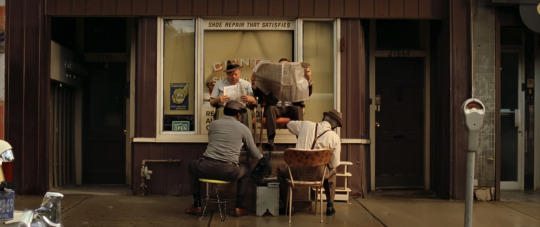
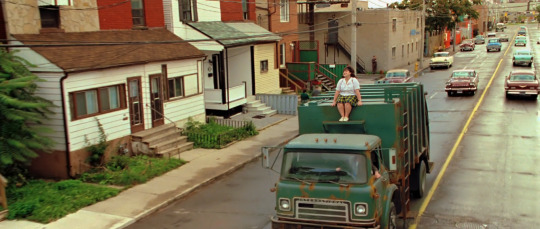
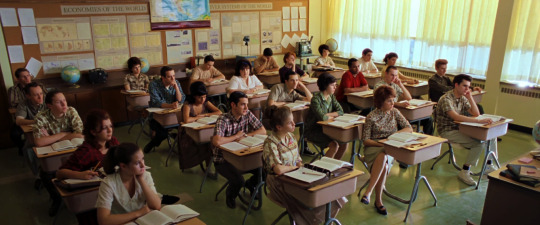
2. The Nicest Kids in Town
Introduction to the Corny Collins Show... and the handsome actor James Marsden.

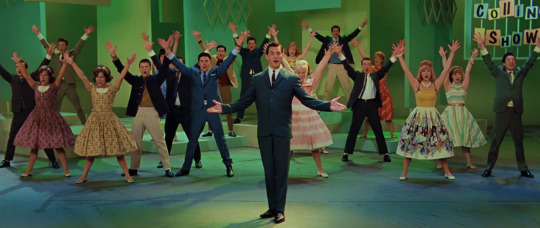
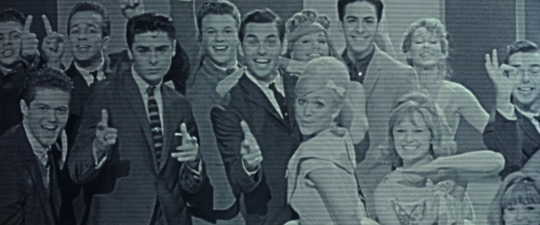
There is actually another song called The Legend of Miss Baltimore Crabs after this but I do not have favourite scenes in it (maybe I am a bit biased because I hate Velma von Tussle).
3. I Can Hear the Bells
When Link Larkin, the lead male dancer of the Corny Collins Show, finally acknowledges Tracy’s existence! I love every scenes involved in this song, it shows different contrasting settings and also aesthetically pleasing composition.

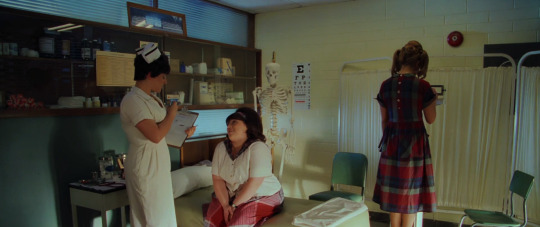
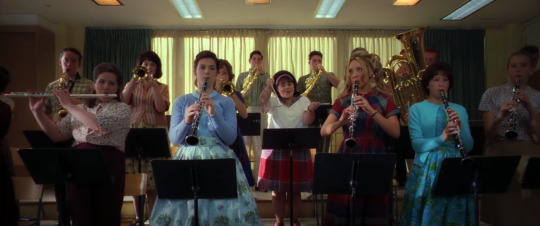
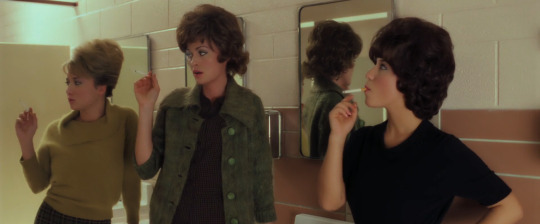

There is also another song after this called Ladies’ Choice sang by Link Larkin, I DO have favourite scenes in it but everything just moves so fast I could not take screenshots! :-( I will put down a YouTube link at the very end of this post so you guys can watch the whole musical scenes!
4. The New Girl in Town
I especially like the outfits here, you can see the contrast between the two performances.
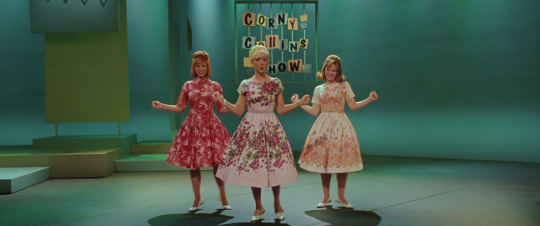
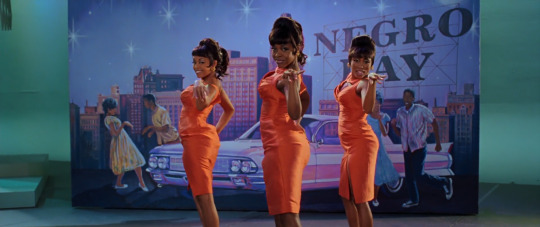
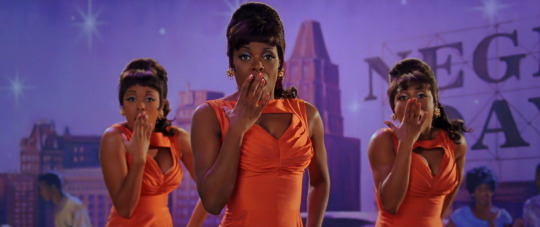
5. (Hey Mama) Welcome to the 60′s
This is when Tracy’s mother, Edna Turnblad got called by Mr. Pinky (a famous boutique owner in the town) and Edna has to go out from their home after many years of staying in. It is a good change for Edna where she gains confidence to look good! Love the lowkey good composition here, and the colours involved.
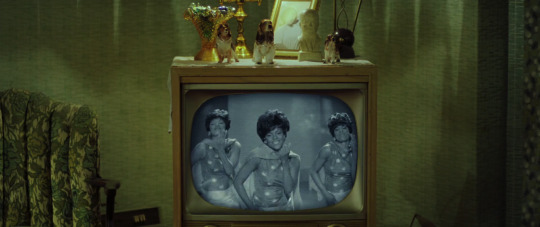
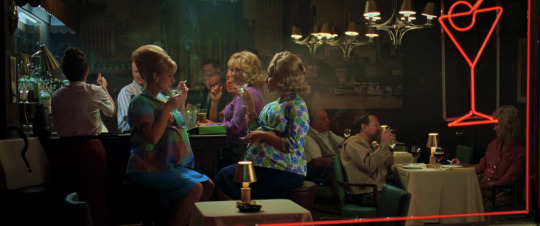

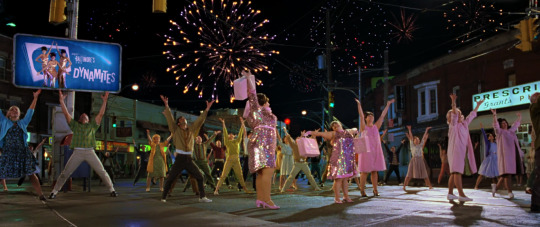
Again, skipping another song called Run & Tell That sang by Seaweed and his sister, Little Inez. And again, I have favourite scenes but everything just moves so fast!!!
6. Big, Blonde & Beautiful
Originally sang by Motormouth Maybelle and another version is by Edna Turnblad and Velma von Tussle right after.
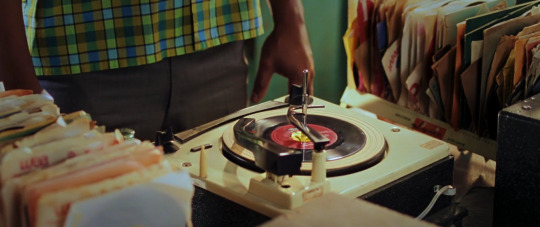
For those who are wondering who Velma von Tussle is, THIS is her! >:-(
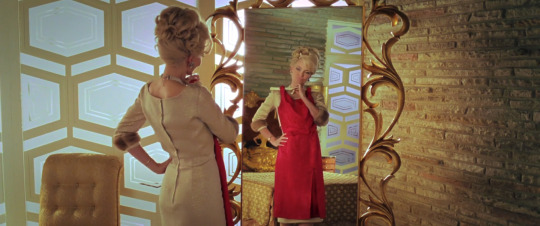

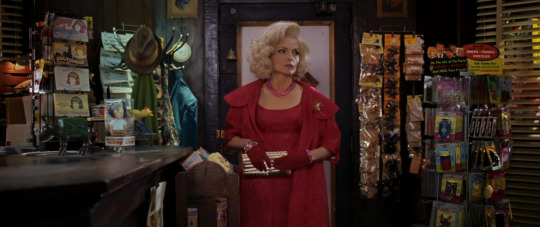
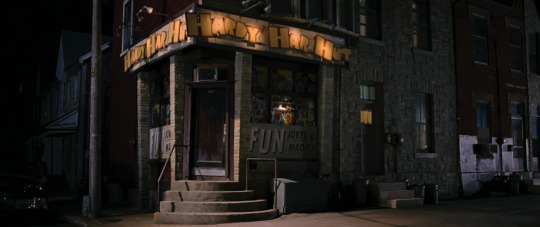
7. (You’re) Timeless to Me
This is after Edna misinterprets the affair incident between his husband Wilbur Turnblad and Velma, in Wilbur’s Hardy Har Hut >:-( (which Velma purposely plans just to make a scene, now you all know why I hate her). There are actually more scenes that I like in this song but as usual: everything is so fast!!! D-:
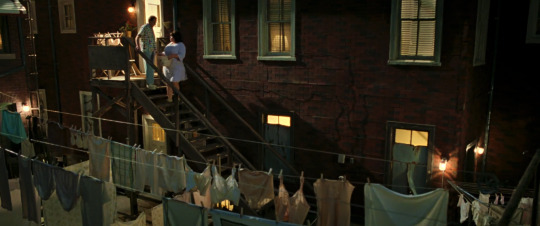
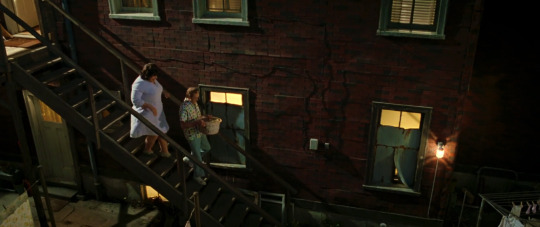
8. I Know Where I’ve Been
My favourite one so far! A powerful song sang by THE legend. They are protesting against the ending of Negro Day. You can actually see the different tone used in these particular scenes where it shows a certain type of mood related to the song. 10/10
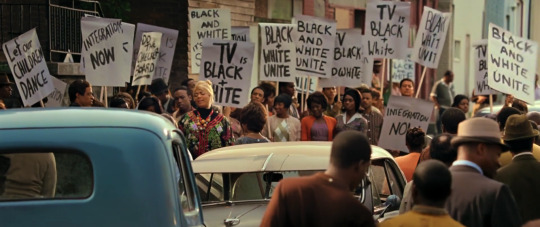
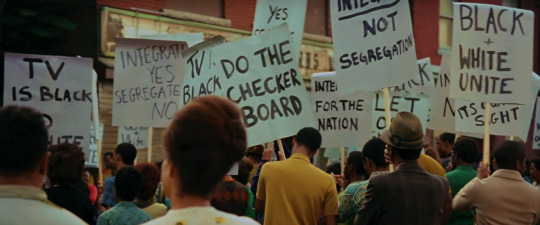
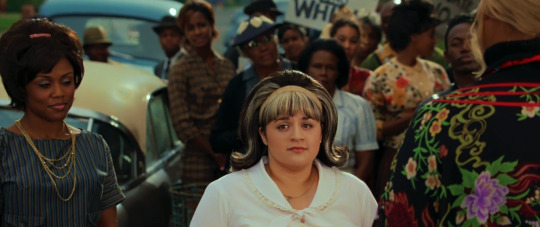

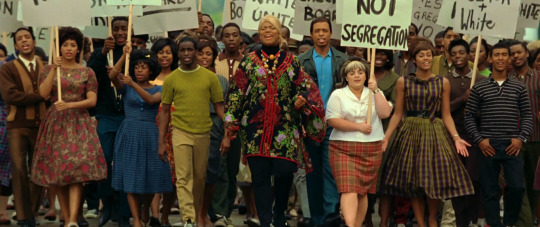
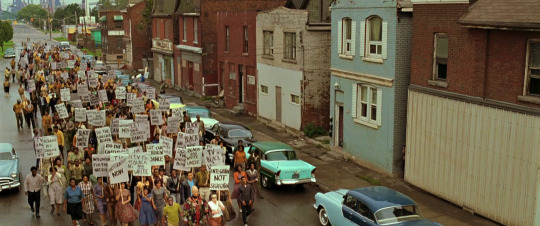
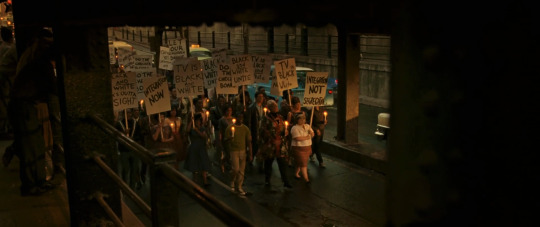
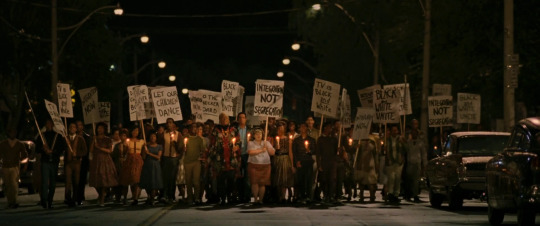
9. Without Love
This is literally right after the protest. LOL. They have to help Tracy from getting caught by the police (she hit a police officer during the protest). And this is also the moment Link admits he has feelings for Tracy, OMG.
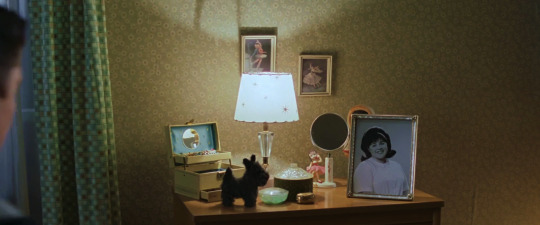
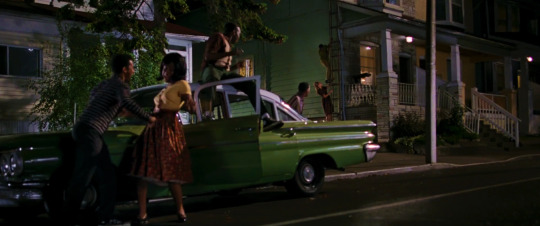
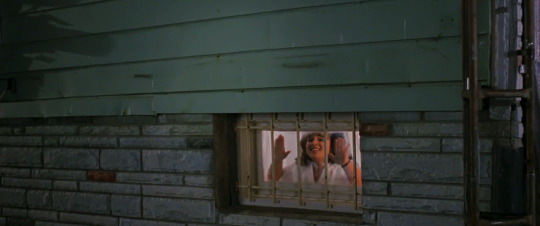
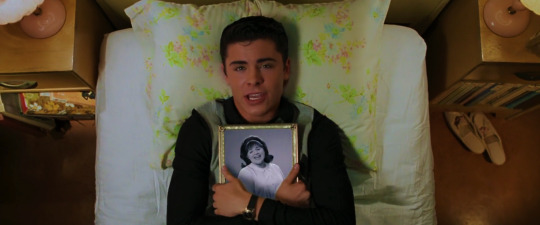
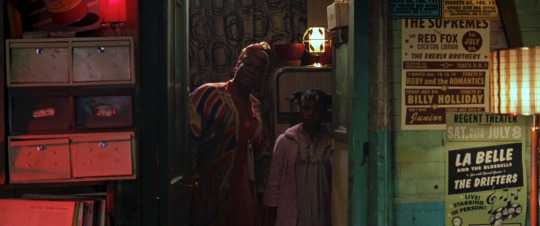
10. It’s Hairspray
This is near to the end! The final show of Corny Collins Show: Miss Teenage Hairspray. Love the colours involved! And James Marsden, ugh.
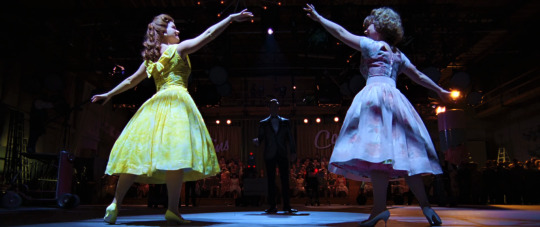

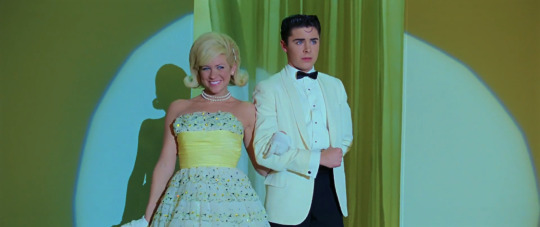
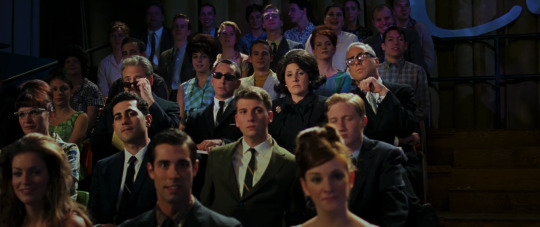
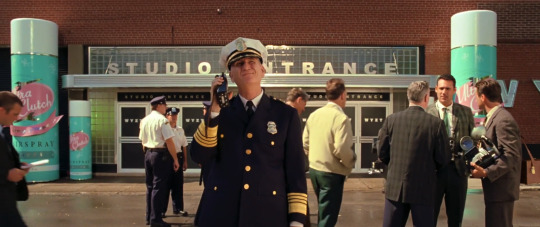
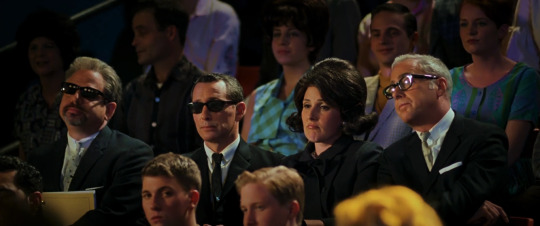
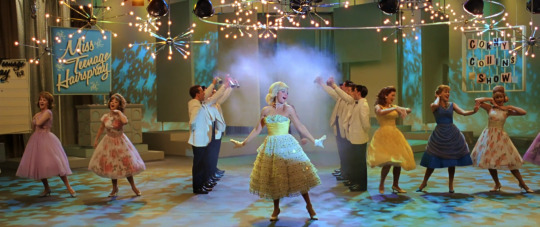
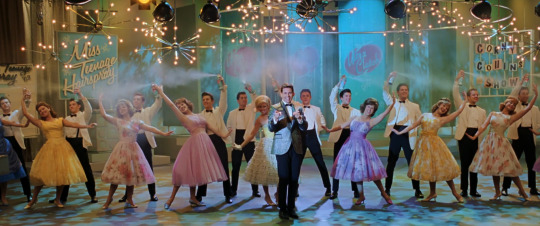
11. You Can’t Stop the Beat
We are coming to an end! Good things happen in this scene, Tracy gets rid of Amber von Tussle (Velma’s equally evil daughter) LIVE on TV, Link and Tracy finally gets together (uwu), Corny announces that the Corny Collins Show is finally integrated! [poetic cinema] I do not even need to explain why I love this final song TBH.
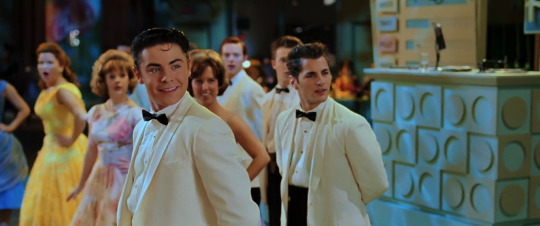
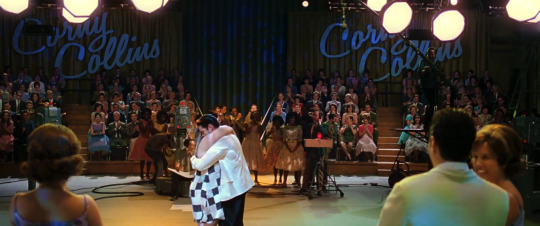
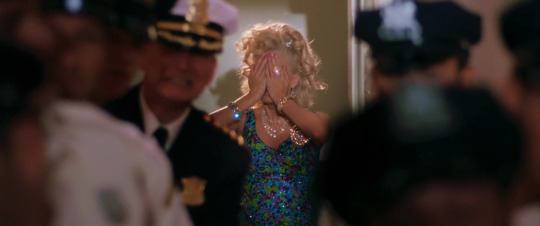
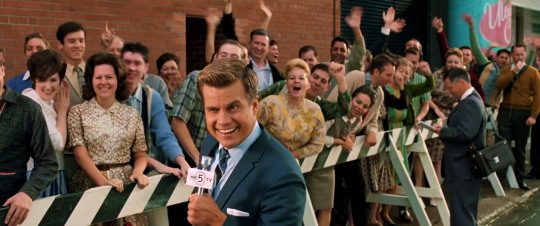
This is when Velma gets exposed on TV! LMAO
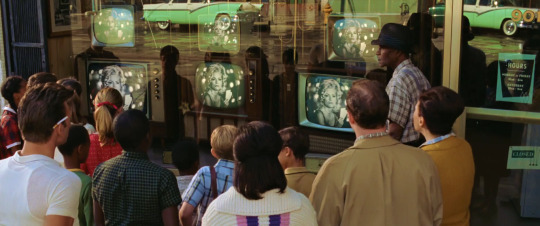
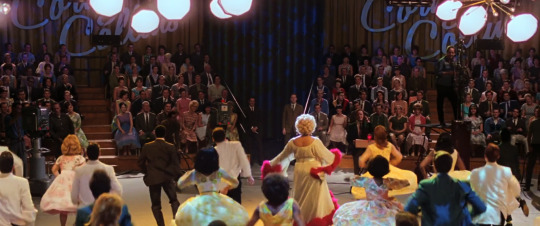
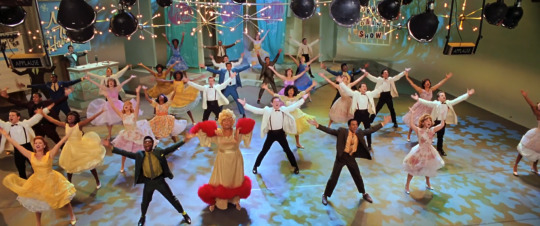
And that is it from me! Here is the link to all of Hairspray songs in order! Or you can just watch the full movie hehe.
Reference
Shankman, A. (Director), & Zadan, C. (Producer). (2007). Hairspray [Motion Picture]. United States: New Line Cinema.
1 note
·
View note
Photo
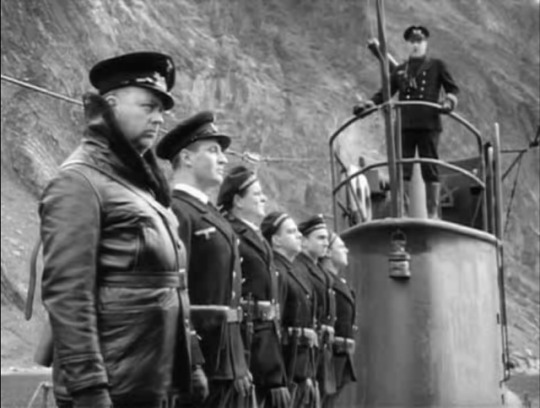
49th Parallel (1941)
The Allies were losing the Second World War. In London in 1939 or 1940, the Ministry of Information (the propaganda house of the British government) met with film director Michael Powell and asked if he might want to make a film about minesweepers. Powell’s interest was piqued, but then he suggested making a film that might inspire the United States to abandon their neutral stance on the conflicts in Europe and Asia. His new partner-in-crime, screenwriter Emeric Pressburger (Pressburger would soon become Powell’s co-director on their subsequent movies), relished the prospect, hoping to “scare the pants off the Americans” with this newest project.
By the second half of 1941, the situation appeared dire. The Allies evacuated Dunkirk (their last foothold in continental Western Europe) the year prior; Nazi Germany was making advances in the Balkans; Fascist Italy was reclaiming the former African lands of the Roman Empire that it long sought; Imperial Japan had completed its military stranglehold on modern-day Vietnam, Laos, and Cambodia. British Prime Minister Winston Churchill was the most vocal in pleading with the United States to enter the war, but still Washington sat on the sidelines, adopting the policy of appeasement. Michael Powell’s 49th Parallel is an unusual propaganda feature film, and ultimately did not inspire the Americans to declare war on the Axis. Though released in the United Kingdom in late 1941, the film was not given a general release in the U.S. until April 15, 1942. By then, the Japanese attack on Pearl Harbor already provided the impetus for the Americans joining the Allies.
Powell and Pressburger’s newest work was no longer needed to scare the pants off any American. With 49th Parallel (originally released in the United States as The Invaders, which is also how it is listed in the records of the Academy of Motion Pictures Arts and Sciences), they introduced a narrative centering around Nazi soldiers looking to impose their values an ocean away from home. Many WWII-era propaganda movies have lost much of their watchability given time, but that is not the case here.
A German U-boat has surfaced in Hudson Bay in Canada. Six sailors are tasked by the captain to search for foodstuffs and supplies, but shortly after they reach land, the Royal Canadian Air Force (RCAF) has destroyed the U-boat. The six Nazi raiders are now at large, looking for ways to return to Germany or to rally the Canadian people to their side and begin an insurrection. Their commanders, Lieutenants Hirth (Eric Portman) and Kunhecke (Raymond Lovell), push the men forward. The raiders soon terrorize a band of French-Canadian trappers led by Johnnie (Laurence Olivier with an atrocious French accent) and murder a local Inuit named Nick (Ley On; whose people is described by Hirth as, “sub-apes like Negroes, only one step above the Jews” – this line was cut from the American release to avoid offending segregationists). Kunhecke is killed by an Inuit marksman as their raiding party attempts to steal a floatplane, and becomes the first casualty as these six are picked off one after another. Their mission to return to Germany will encounter several stops, including a community of Hutterites (a Germanic Anabaptist group, similar to the Amish, that fled Europe in the nineteenth century due to religious persecution) that they will attempt to convert to Nazism and Banff National Park.
Also featured are: Hutterite leader Peter (Anton Walbrook), Hutterite villager Anna (Glynis Johns), writer Philip Armstrong Scott (Leslie Howard), and Canadian soldier Andy Brock (Raymond Massey). Rounding out the U-boat’s raiding party are Vogel (Niall MacGinnis), Kranz (Peter Moore), Lohrmann (John Chandos), and Jahner (Basil Appleby).
If 49th Parallel was not a propaganda film, it would be more commonly labeled a war thriller. Editor David Lean (1962′s Lawrence of Arabia, 1965′s Doctor Zhivago) was one year away from directing his first feature film, and his ability to string together frantic images in the handful of pursuit scenes means that 49th Parallel never needs spectacular violence nor masses of soldiers engaging in a firefight to send hearts racing. Lean’s future cinematographer for both Lawrence of Arabia and Doctor Zhivago, Freddie Young, is also involved. And though the widescreen camera lens of the 1950s and onwards had not been standardized yet (the film is in the typical 1.37:1 ratio for the time), his opening images of Canadian mountains and the nature photography found in the film’s second half are spectacular to behold. For eighteen months, the filmmakers traveled over 50,000 miles across the Atlantic Ocean and Canadian wilderness to shoot this film. 49th Parallel is a cross-country, cross-continental effort. When put through the paces of Lean and Young’s work, puts into doubt the certainty of any propaganda movie’s ending – even for a few minutes.
Emeric Pressburger’s screenplay keeps the war thriller based in Western anti-authoritarian rhetoric. Pressburger, a Hungarian Jewish refugee who fled continental Europe and whose command of English was imperfect, allows the Nazi characters to spout dogma without challenge; their ignorance and contempt for anyone not like them obvious soon after the U-boat surfaces in Hudson Bay. Their victims are never entirely helpless, often challenging the Nazis with celebrations of Western democratic and classical ideas championing a person’s fundamental rights to free thought and to live the life they please. Unlike a typical, pure war movie, 49th Parallel is a Nazi struggle to escape North America contained within a grander ideological dialectic. The film makes no pretense on what side it is on (it should not in any case). Its messages are articulate, achieving its initial goals to disturb and terrify the audience with the mindsets of men willing to slaughter their way home.
Uneven performances are expected in propaganda cinema, and 49th Parallel is no exception. Established actors like Leslie Howard and especially Laurence Olivier are serving overcooked ham with their performances. By the midpoint, Eric Portman, as Lieutenant Hirth, begins to dominate the proceedings – all of the scathing and pedantic lines penned by Emeric Pressburger go to the unshakeable Nazi commander. As a result, Portman’s performance lacks any nuance or self-doubt, as he becomes the equivalent of a tea kettle that has been left on the stove whistling for too long. Nevertheless, Portman is also involved during 49th Parallel’s most blatantly political, yet most effective moment. At a community meeting, Lieutenant Hirth, believing that the German-speaking Hutterites are closeted Nazi sympathizers, begins to traffic slogans of racial superiority, shredding the Allied nations as unwilling, unmanly combatants. Hirth has misinterpreted the people who have offered them food and temporary shelter. The Hutterite community’s leader, Peter, played by future Powell and Pressburger regular Anton Walbrook (1943′s The Life and Death of Colonel Blimp, 1948′s The Red Shoes), dismisses the hateful rhetoric by invoking the history of his people – a history, defined by personal freedoms and the intolerance of others, that makes their existence a living refutation of Nazi doctrine.
Concludes Peter:
You think we hate you, but we don’t. It is against our faith to hate. We only hate the power of evil which is spreading over the world. You and your Hitlerism are like the microbes of some filthy disease, filled with a longing to multiply yourselves until you destroy everything healthy in the world. No – we are not your brothers.
One could say that Walbrook is over-explaining the film’s subtext here, but other propaganda films released from the Allied nations were far more heavy-handed than this to insensitive faults (see: 1944′s The Negro Soldier – an American propaganda piece meant to increase black enlistment which celebrates black cultural excellence, yet completely fails to mention slavery or racial segregation in its historical passages). Walbrook’s presence, however brief, electrifies the audience’s energies in the scenes that follow.
The individual whose work on 49th Parallel could be called transcendent is English composer Ralph Vaughan Williams. Those knowledgeable with classical music probably just read that last sentence in disbelief but, yes, Ralph Vaughan Williams composed for films. In fact, 49th Parallel contains the first Vaughan Williams score for a feature-length film. Decades earlier, Vaughan Williams studied under Impressionist composer Maurice Ravel (Boléro), and the Frenchman considered his English pupil among his most gifted. Influenced by English folk songs and Tudor-era modal music, Vaughan Williams’ rhythmically complex style did not cohere until shortly before World War I. He served in the Great War, returning home emotionally traumatized, his hearing permanently damaged. For 49th Parallel, Vaughan Williams wished to invoke musical nationalism in ways he believed no composer had yet accomplished in British cinema.
youtube
Recording with the London Symphony Orchestra, Vaughan Williams begins his score with the “Prelude” – a molto legato statement of an opening, meant to invoke the lyricism of Christian hymns that extol freedom and human fellowship. One can hear the influence of Ravel’s Impressionist roots in this music, rejecting Wagnerian leitmotifs and versatile enough to adapt to 49th Parallel’s shifting moods and settings. The majesty of the prelude shares few similarities to “Hutterite Settlement: Anna’s Volkslied” (“Volkslied” is German for “folk song”). Wandering flutes, wisping the rural landscape along with the solo German-language vocalist. It is a peaceful, somewhat elegiac cue – combining Vaughan Williams’ strengths of string-led pastoral stillness, pre-Baroque influences, and the sweep of North American music. Throughout, Vaughan Williams will alternate between non-resolving passages for the Nazis to juxtapose a musical uncertainty to their ideological rigidity, as if their experiences in Canada may be inspiring second thoughts; the early Hollywood musical-esque bustle of a large city; and an Englishman’s interpretation of Native American music. Much of the music is written not to respond to what is occurring on-screen, but to empower the images. It is a virtuosic composition from Vaughan Williams that sounds as fantastic within the film as when listened to independent from it. Vaughan Williams would work on ten more movies until The Vision of William Blake (1957), with his efforts for 49th Parallel displaying a remarkable musical versatility in style and in musical medium.
During production, Raymond Massey, Leslie Howard, and Laurence Olivier all agreed to half-wages during production to assist the war effort. An aberration the year of this film’s release, the remainder of the cast was not comprised of just English actors (more specifically, London-area or Southern English actors), but Scots (Finlay Currie) and Irishmen (Niall MacGinnis). Few British films had ever been made with such a stacked cast, let alone being set on a grand international stage. Lawrence of Arabia this might not be, but this is as close to being an epic film as any British film production was able to be by the 1940s. The film’s financial success across the West allowed for the creation of independent British film production companies like The Archers (Powell and Pressburger) and Cineguild (David Lean), among others. The face of the non-Alfred Hitchcock British filmmaking industry would be strengthened by the marvelous reception given to 49th Parallel, securing the nation as one of the greatest forces of world cinema.
With its value as propaganda ended due to the course of history, 49th Parallel should be watched as both a historical landmark for British filmmaking as well as an excellent, potent thriller. It may not have changed any of the military or political outcomes Powell and Pressburger and the rest of its cast and crew were targeting, but the positive impacts of this production – for audiences and within the film industry – have outlasted many other works of propaganda.
My rating: 8.5/10
^ Based on my personal imdb rating. Half-points are always rounded down. My interpretation of that ratings system can be found here.
#49th Parallel#Michael Powell#Emeric Pressburger#Leslie Howard#Eric Portman#Laurence Olivier#Raymond Massey#Anton Walbrook#Glynis Johns#Raymond Lovell#Niall MacGinnis#Peter Moore#John Chandos#Basil Appleby#David Lean#Freddie Young#Ralph Vaughan Williams#propaganda film#TCM#My Movie Odyssey
3 notes
·
View notes